midterm visual analysis
1/96
Earn XP
Description and Tags
100 images and significance from provided slideshow
Name | Mastery | Learn | Test | Matching | Spaced |
|---|
No study sessions yet.
97 Terms
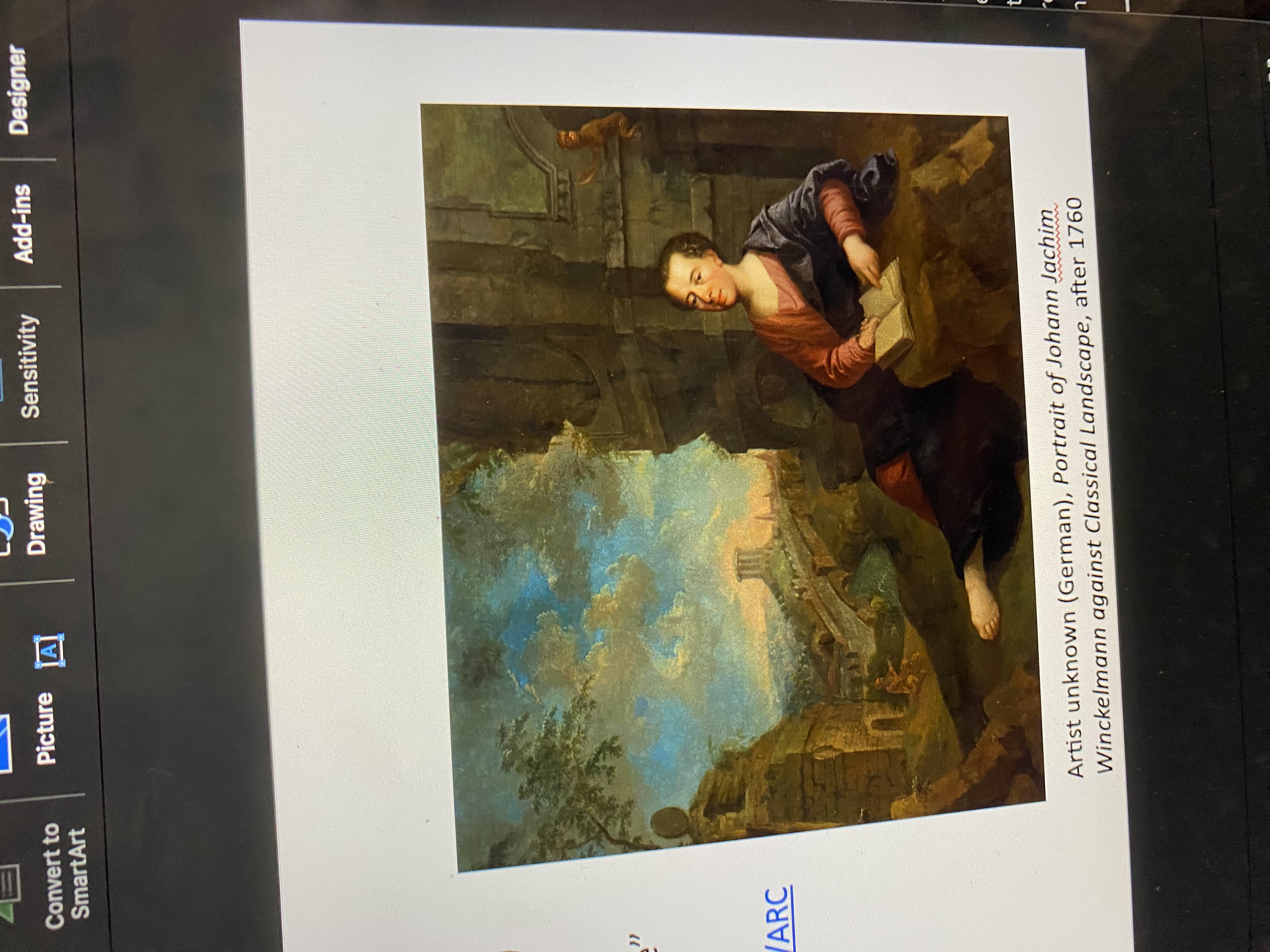
Artist unknown (German), Portrait of Johann Jachim Winckelmann against Classical Landscape, after 1760
Looks like it could be a coloseum/parthenon, daytime/sunset, looks like its about to rain, went to place to be alone and read, german literary scholar forcued on art, moves to rome to see all art, neoclassism-excavations at end of 18th century, hercalania excavations-eur people are seeing anciet Greek/roman stuff for frist time (Winkelmann found), winklemann things that foreign things is profected by greeks, he doesn’t respect other countries culture, good taste comes form imitating Greek art, Greek male bodies are perfect=should reproduce them in art, compare renaissance art, germans are looking for something to hold onto, catholic church have diminished presence in Germany,
Wrote “Reflections on the Imitation of Greek Works in Painting and Sculpture” (1756) and The History of Ancient Art (1764).
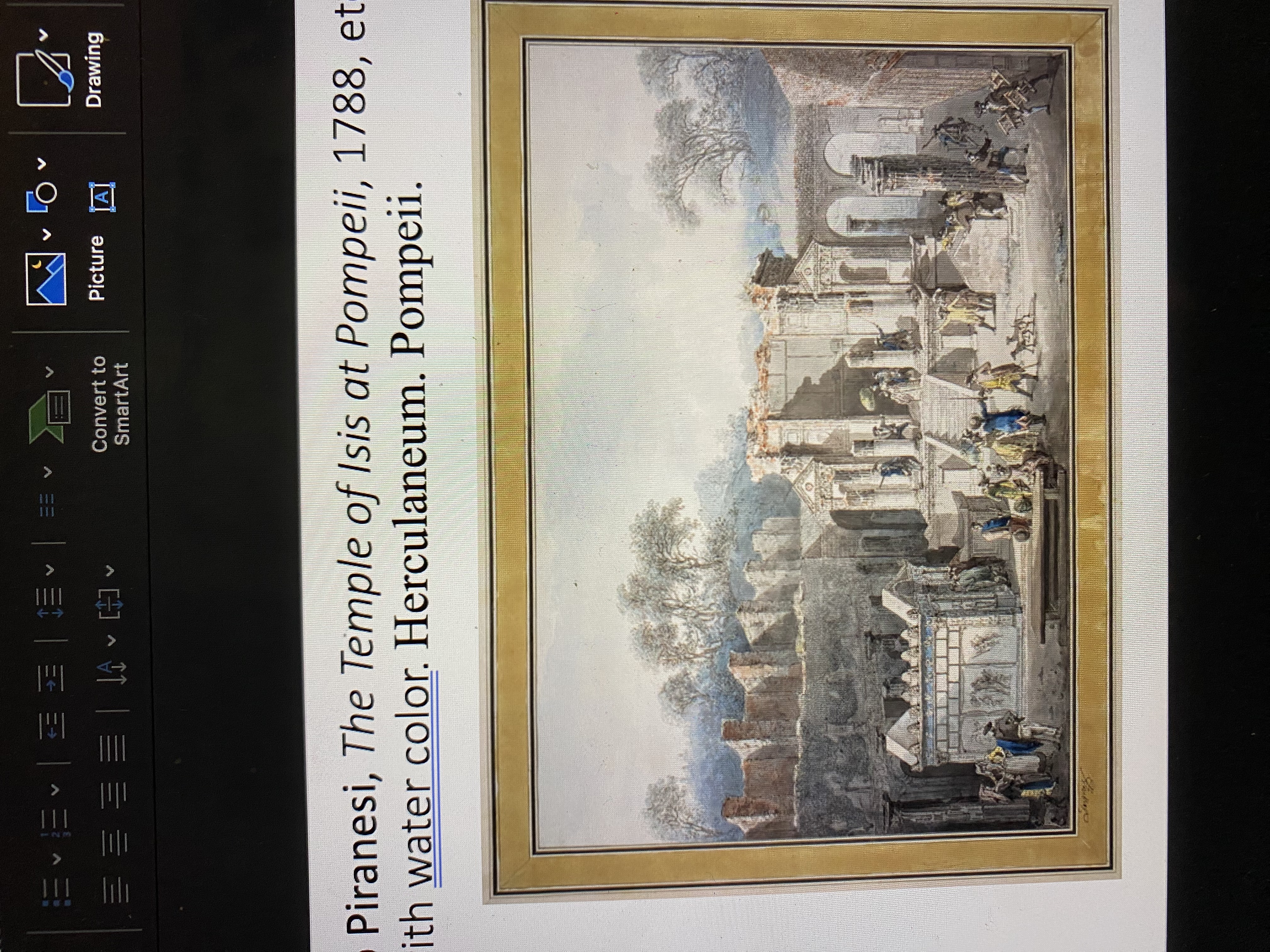
Francesco Piranesi, The Temple of Isis at Pompeii, 1788, etching, hand colored with water color. Herculaneum. Pompeii.
Ethcing to show tourists visiting Pompeii, shows personal artifacts, bring the style home with them, poepel took so much stuff that jteu had to ban exposrts from this site to supply tourists
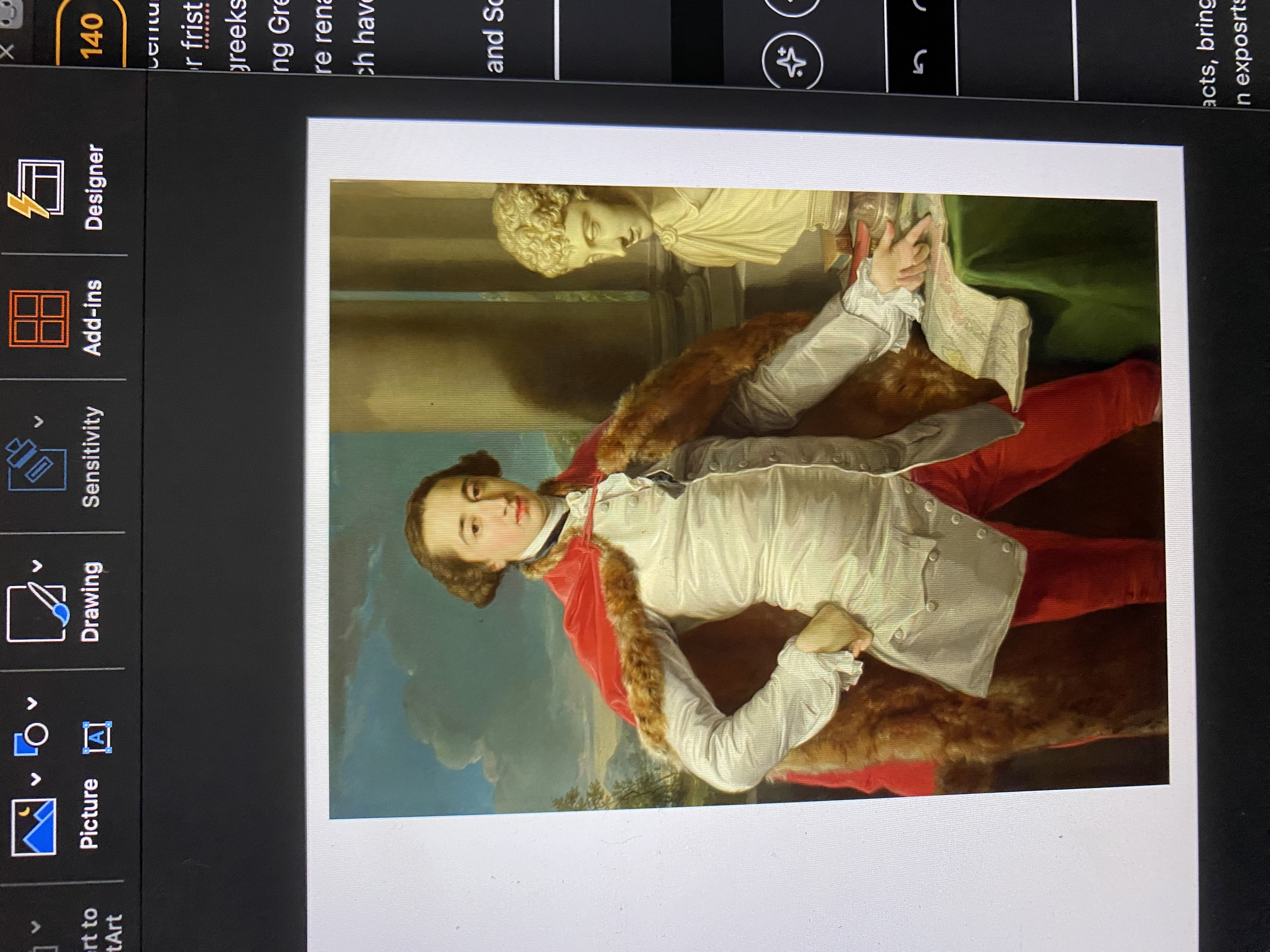
Pompeo Girolama Batoni, Portrait of Richard Milles, c. 1760, Oil on canvas. Grand Tour.
Popular in 18th century, type of portait popular at time, grand tour taken by wealthy british men, went to fleoence and Pompeii, “rich guy gap year”, to culture themselves in ressannace and Greek art, Richard milles sits when hes in Italy,
Rococo
•Largely popular in France, this style was popular in aristocratic home design, including furniture and light fixtures, as well as in painting
•Derives from the French word rocaille, or decorative rocks or pebbles
•Its characteristics are curving lines, bright light, sensuality, extremely lush nature
•Its light-hearted themes, eg: pursuing romance, music, picnics, etc.
•This frivolous style didn’t last long: only really ever popular with the very rich, it didn’t survive into the Enlightenment’s ideas about social equality and interest in science
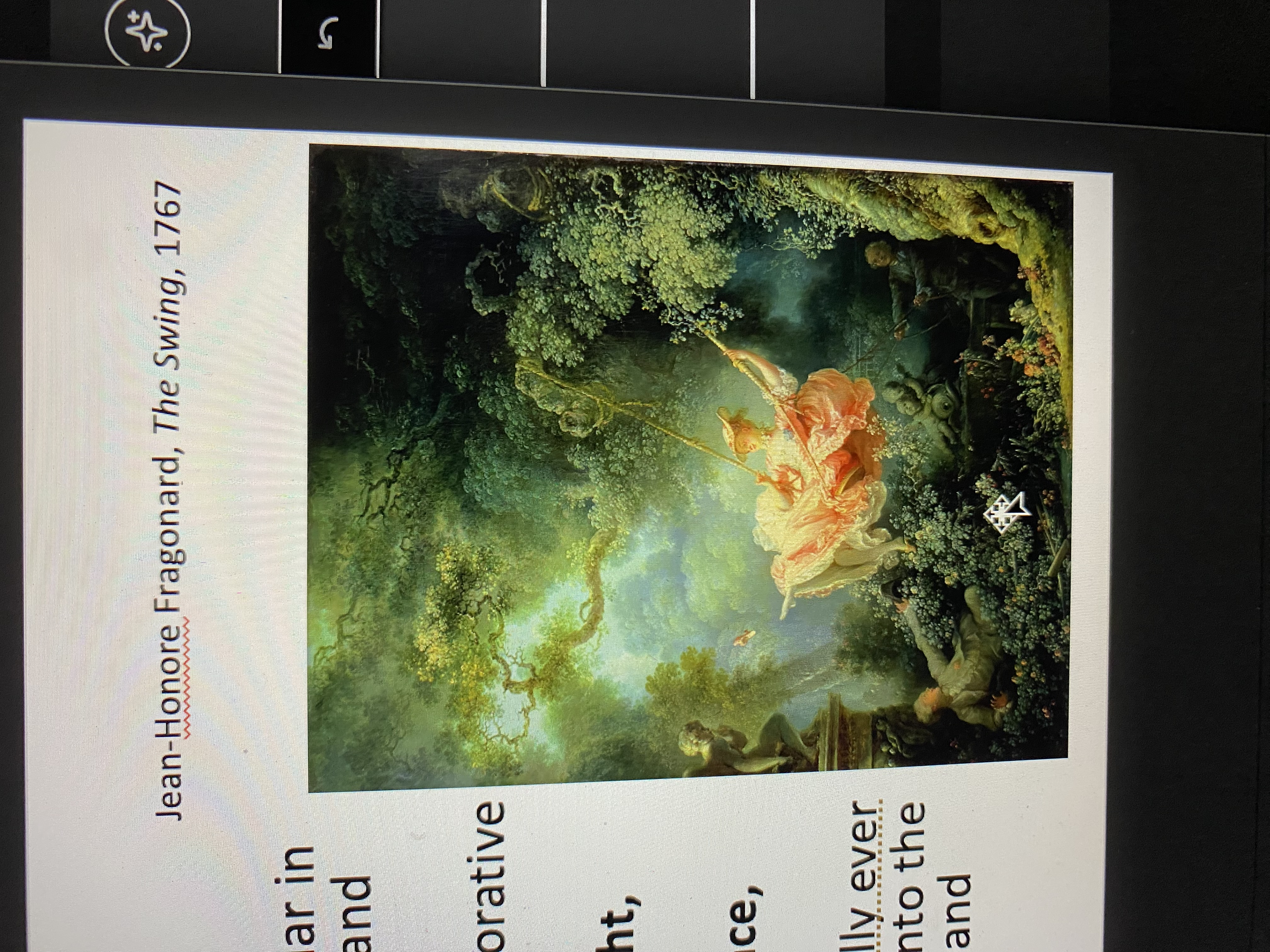
Jean-Honore Fragonard, The Swing, 1767
Lady is cheating on lover, flirting with guy in the bushes, partner is pushing her on swing, fliverous, lots of pastelles, cupid in background
Its characteristics are curving lines, bright light, sensuality, extremely lush nature
Its light-hearted themes, eg: pursuing romance, music, picnics, etc.
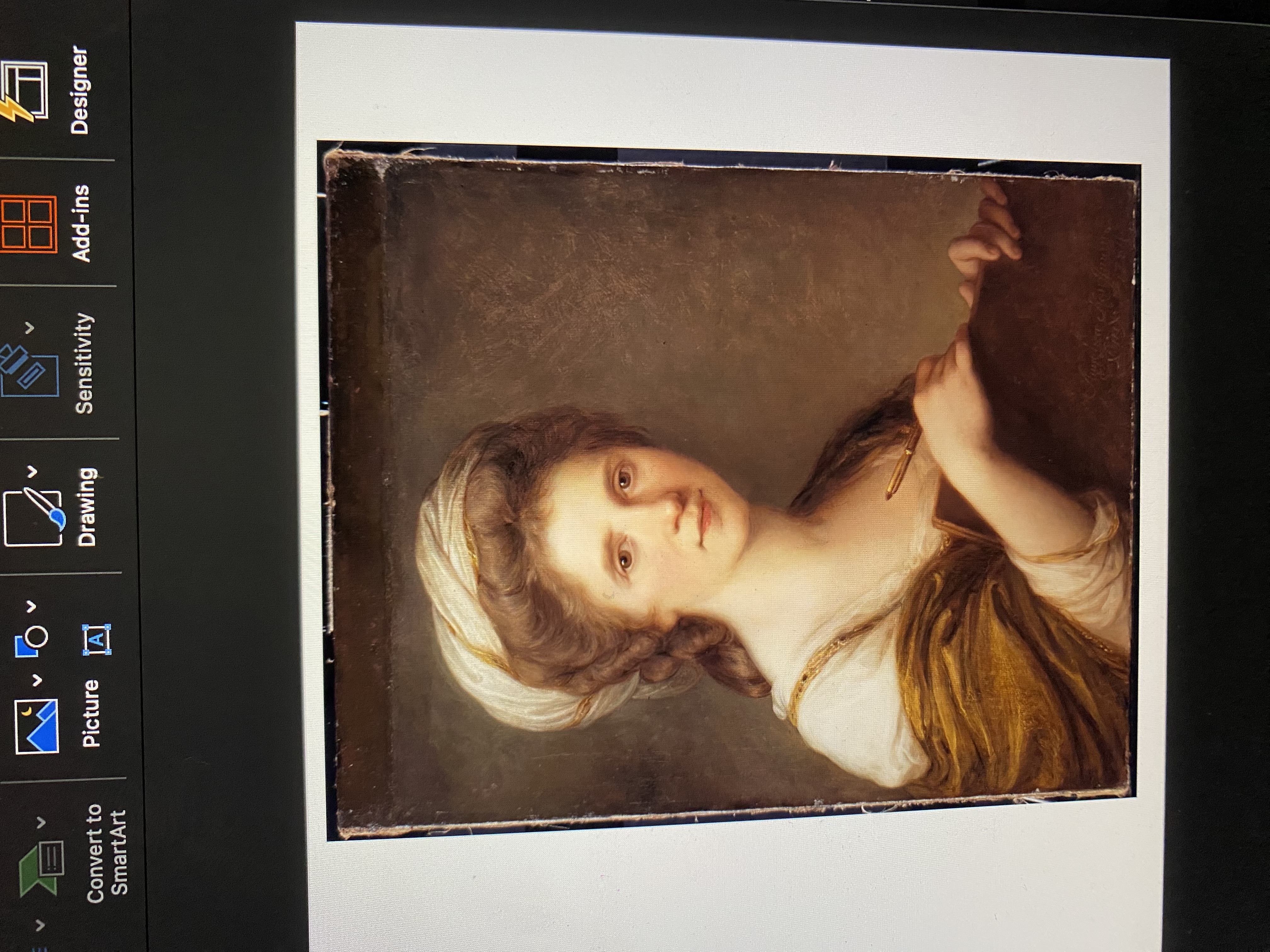
Angelica Kauffman, Self Portrait, 1784
Self portait, women were not allowed to attend any formal art trainting, usually are related to artisits some way in order to learn, allowed to be nude models, nudity issue, nude people made it immapropriate for women to study, born in Switzerland, study classical Greek/roman art there, becomes friends with Winckelmann, an intellectual, moves to engalnd and becomes respected for art, timed down color palate, in Greco romna gowns, she is in triangular composition, light constibutes to shape
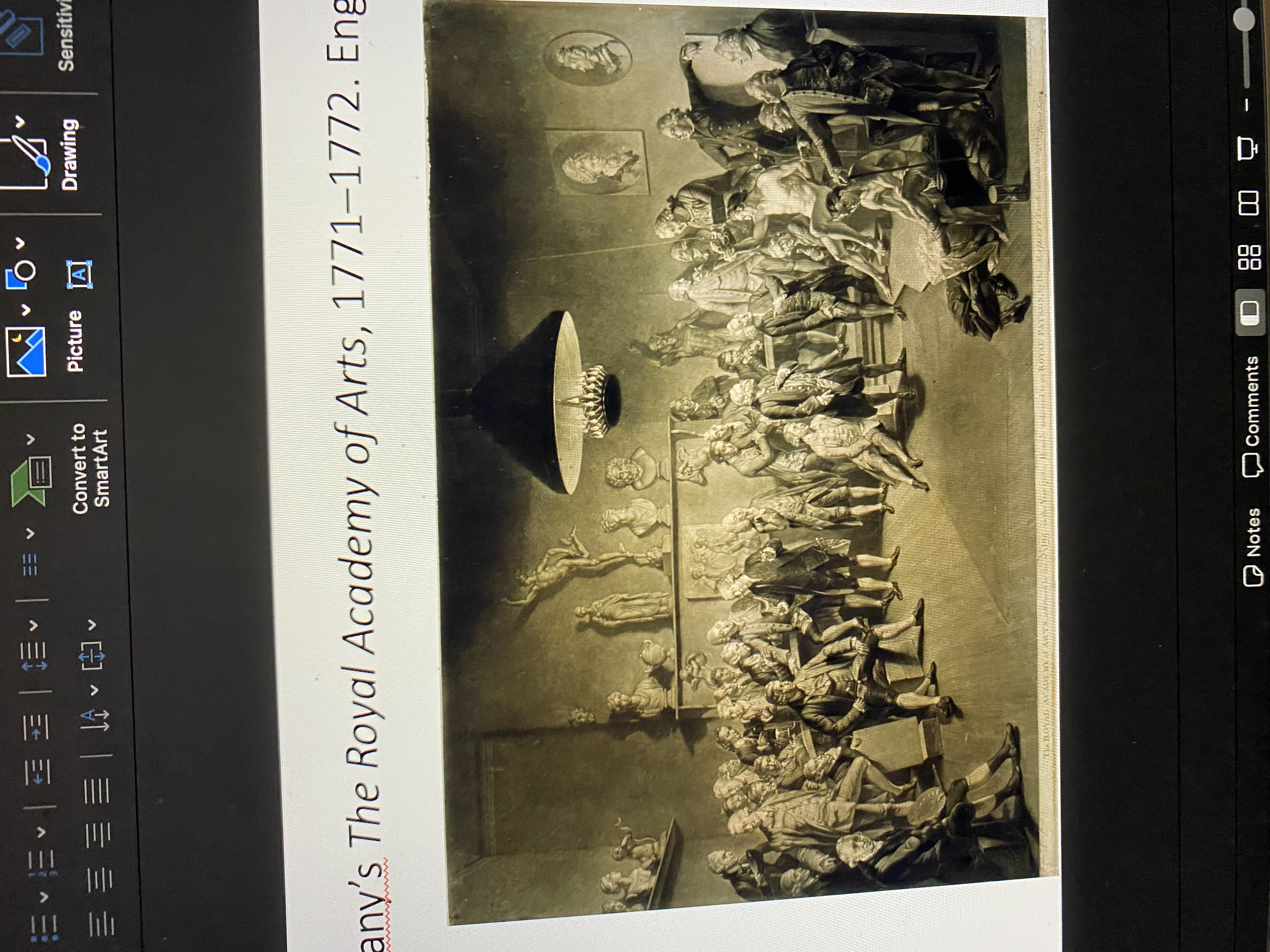
Johann Zoffany’s The Royal Academy of Arts, 1771–1772. Engraving.
British academy of arts, nude model, can see busts that they would be drawing from, special lightfixture of drawing, women are on the wall (acknowlded but wouldn’t be proper to have them on the wall) one of them is Angelica Kauffman on wa
neoclassical
an aesthetic attitude based on the art of Greece and Rome in antiquity
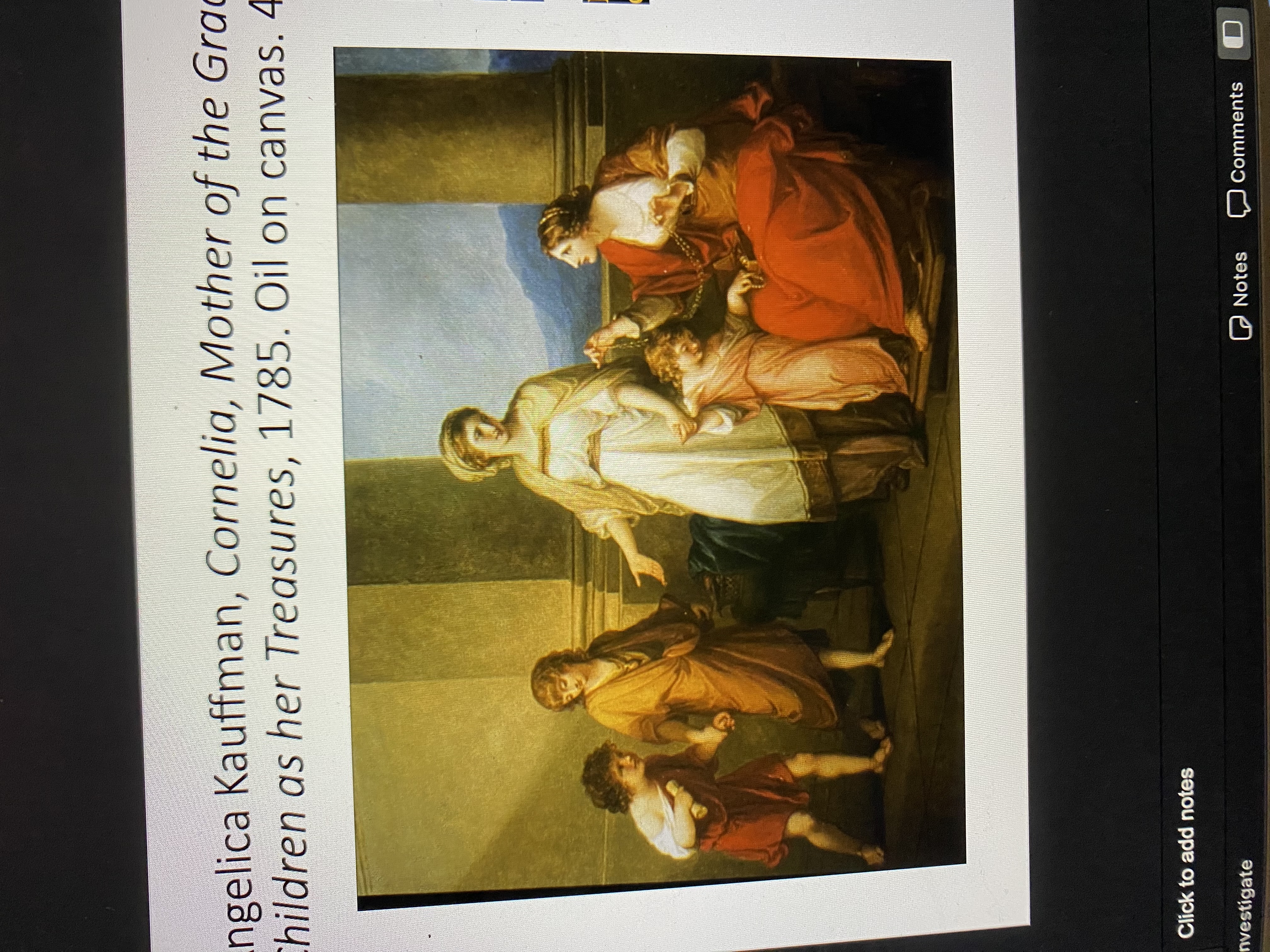
Angelica Kauffman, Cornelia, Mother of the Gracchi, Pointing to her Children as her Treasures, 1785. Oil on canvas. 40 x 50”
Wants to do large important history paintings, paint to her children as treasures, grand tour portraits, neoclassical elements in painting– drapery, columns, wearing bold red brother, Cornelia pointing to her sons, Cornelia is showing off necklace, friend is also wearing head jewles and earnings, Cornelia is virtuious and is saying her children are her jewles, to encourage French women to look back and see their duty is to raise the sons of the future of France and not have a lot of bling, push everyone up to front to show a narrative, Cornealia is pointing to sons, daughter is looking at the bling, raising sons is key to womens virtue
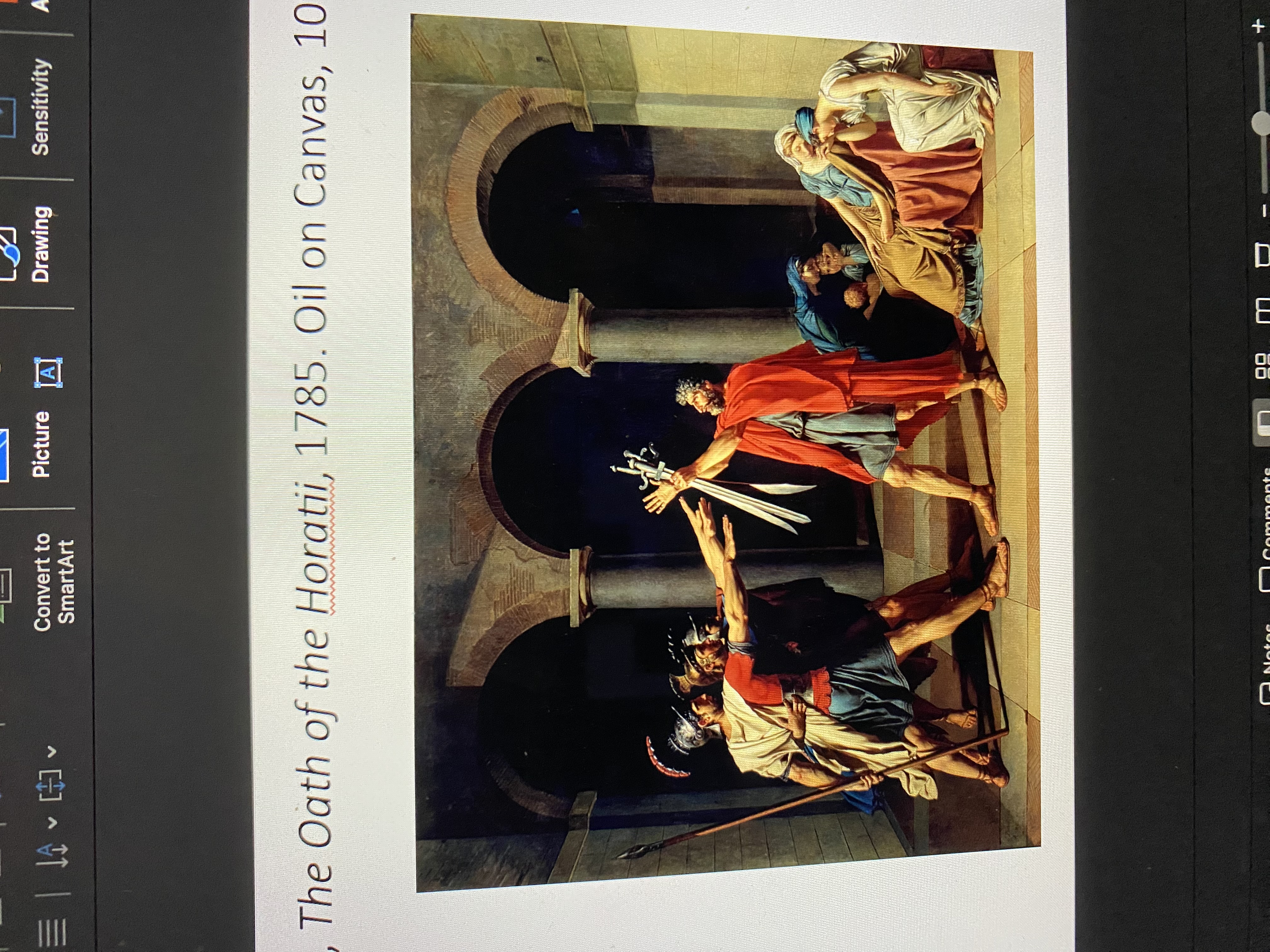
Jacques-Louis David, The Oath of the Horatii, 1785. Oil on Canvas, 10’10” x 13’11”. Salon
Oath of three brothers and their father, over 10/13 ft, David trained at French Academy, works in neo classical style, see Greek.roman art from winning French prize, so popular that salon had to extend showing to allow more people to see painting, refers to roman story and speak to French people, knew subject from roman story, made up scene, roman’s sandals and arches, point at which painting or organized around is the hands holding sword, neoclassical painting has shallow space like a stage, women are portrayed differently, separated, men have taught muscles, women are curving and angular, dispute between roman cities– 3 v 3, one of the woman is the sister of one of the brothers, womens husband is fighting on the other side, she will either lose a brother or a husband, moment that they swear to conquer or die
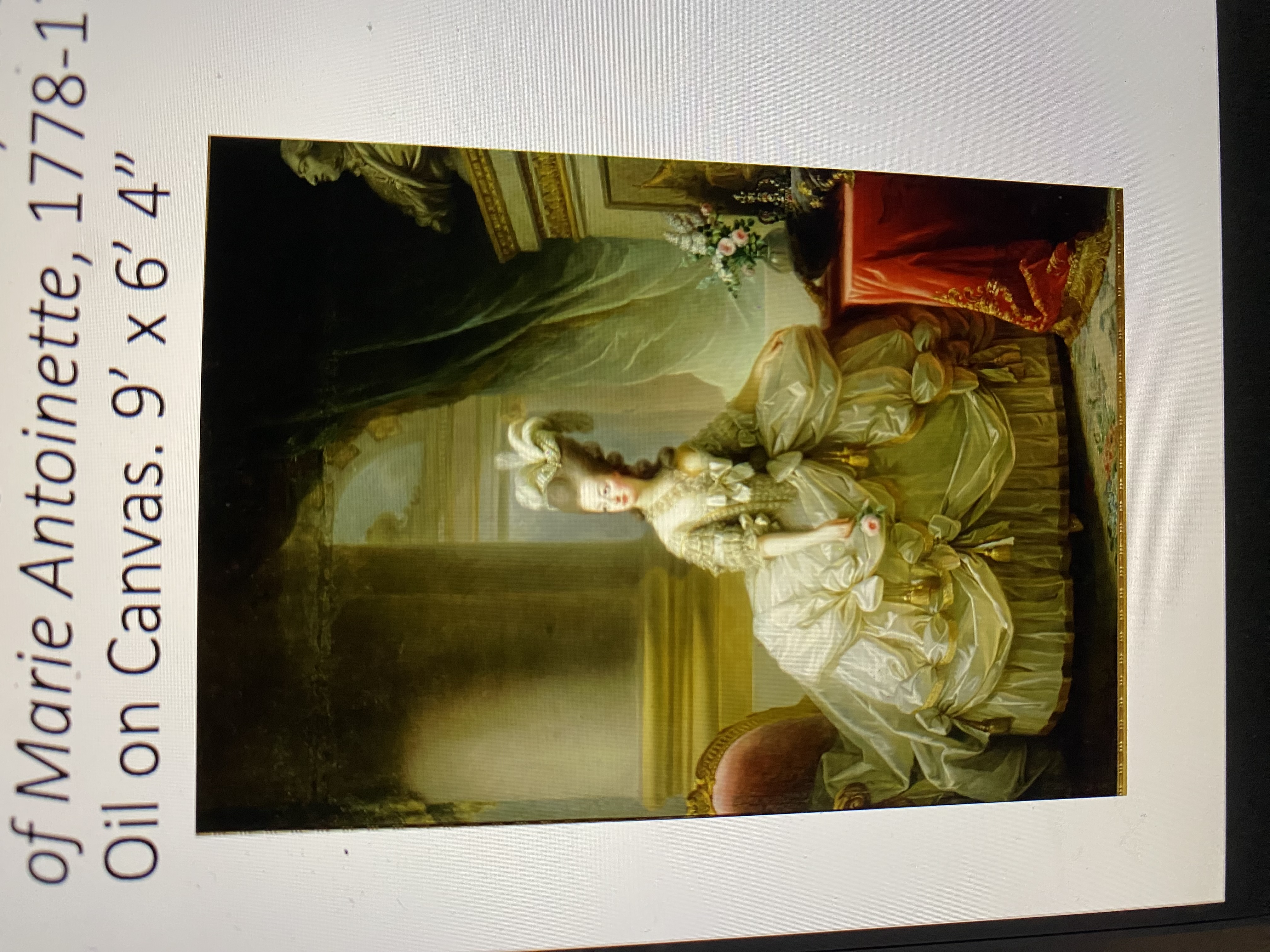
Elisabeth Vigee-Lebrun, Portrait of Marie Antoinette, 1778-1779 Oil on Canvas. 9’ x 6’ 4”
Louis 16 th wife, austrain princess, married him when they were both 15, louis’ father dies and they become king and queen in 1770, she loves spending, all about luxury, :ebrun first to attain rank of painter to king and qeen, Lebrun and Marie become friends because close in age, Lebrun became wealthy and admitted to French Achademy and could exibitat the salon, women were supposed to be moderately good at everything, father was an artist, silk dress=money, hair and face=uptight/full of herself, values money and wealh image, layers and bows and tastles, wig, muted colors, curves to dress, thrown on L and crown on R, bust of husband louis 16 th, recgnixe she is in Versaille, hall way of windows and hallways, windows were expensive at the time, column
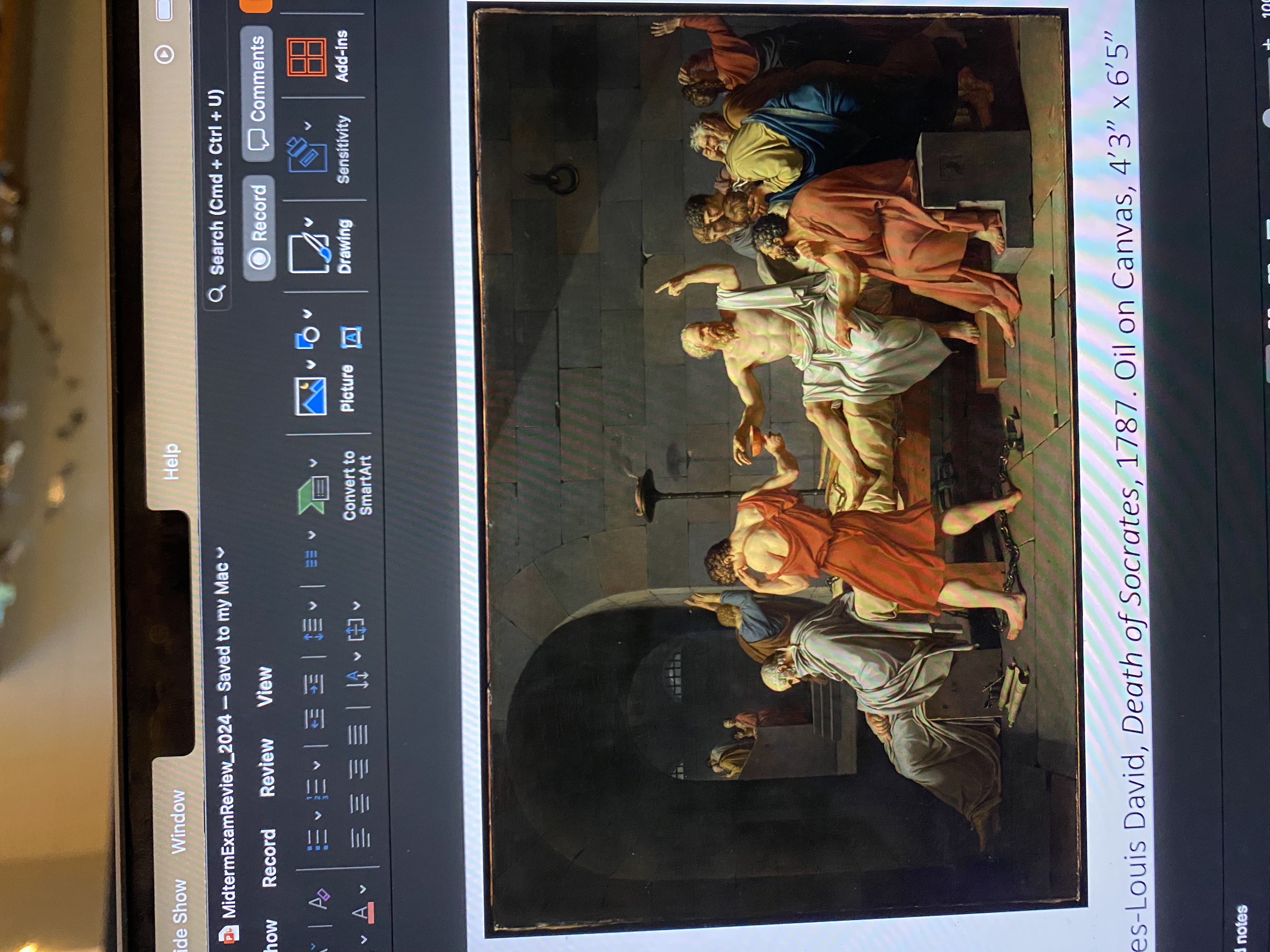
Jacques-Louis David, Death of Socrates, 1787. Oil on Canvas, 4’3” x 6’5
Socrates dies because he is so commited to principples that he would rather die than give in, accused of corrupting youth and worshiping false gods, told he has to renounse he belifs or die, hand stands out, he has to drink his own poison, wife has already said good bye (shes on stairs), followers are saying their goodbyes, guard can’t look at him, Socrates had been in prison and now off him bc hes about to die, old man plato (Socrates’ teacher), David in rome to learn, drapery looks like Greek sculpture, scene done horizonallty like Elgin Marbles on Greek and roman temples (frieze-only comes out dimesionally a little bit),
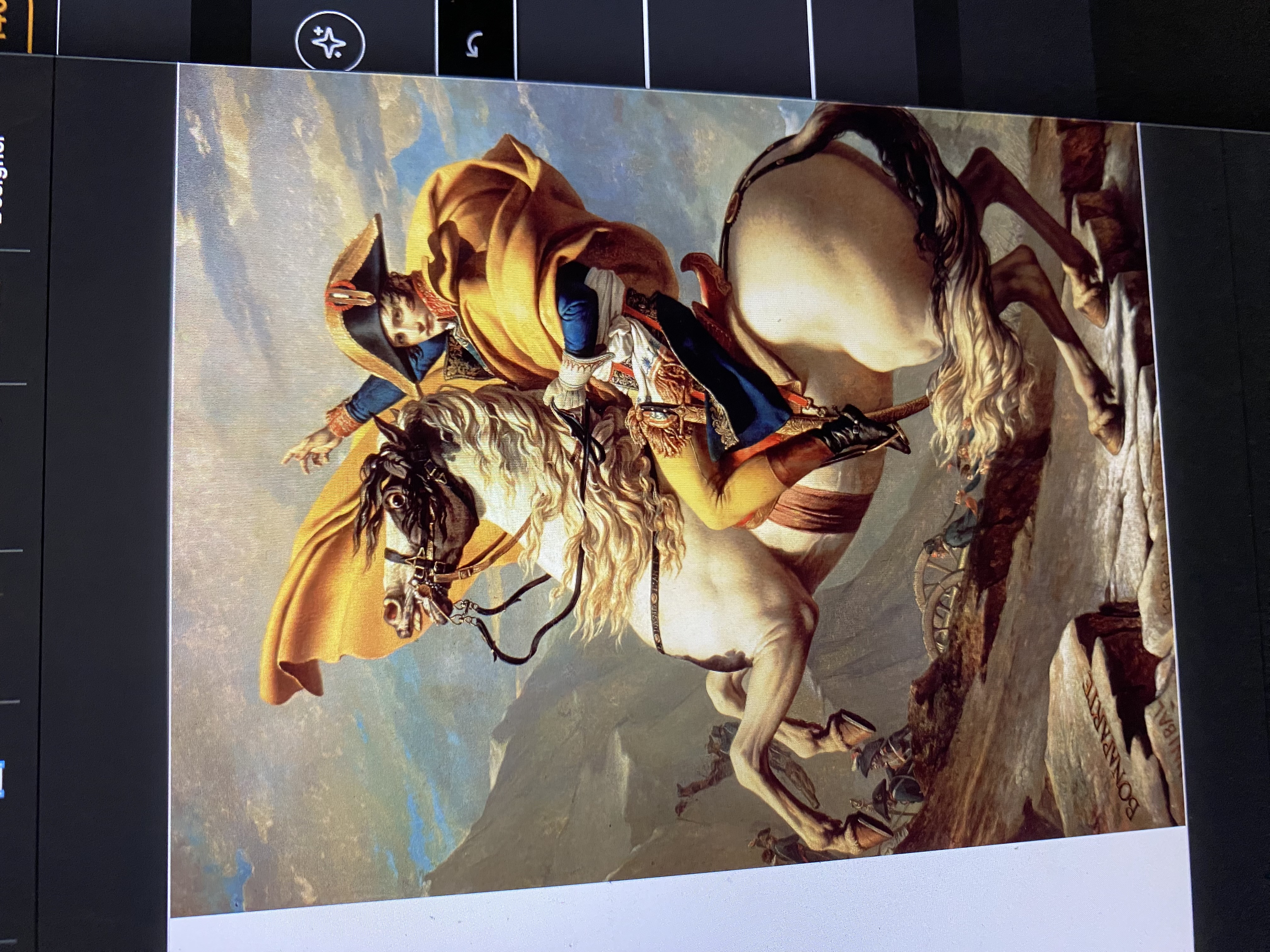
Jacques-Louis David. Napoleon Crossing the Alps at the Saint-Bernard Pass, 1800-1801. Oil on canvas. 8’11” x 7’11”
David paints napoleon’s greatest moment as general, crossing the alps called st brenard pass, difficult and dangerous, Hannical and Bonaparte in history of great generals written at bottom, horses used as power, napoleon actually rode mule, came after fighting, horse looks terrified, men are bigger than they normally would look on a horse to make man look strong and powerful, angle shows treaturous weather,
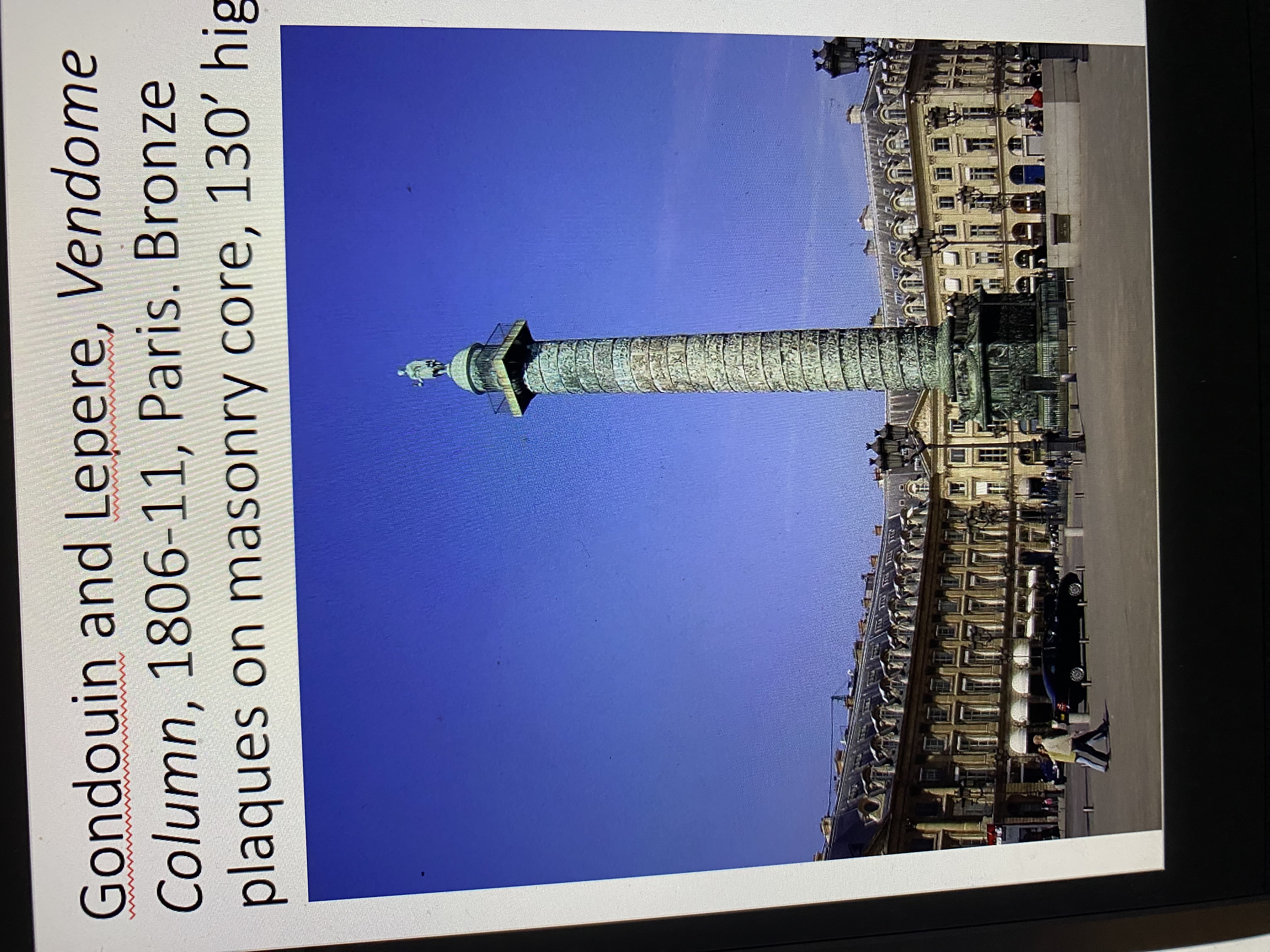
Gondouin and Lepere, Vendome Column, 1806-11, Paris. Bronze plaques on masonry core, 130’ high
Napoleon wanted to connect to ancient rome, Vendome column meant to copy trajan’s column, meant for everyone to see, commemorate military victory, narrative of military victory going up and around the column, ruler placed at top, public way to show strength, napoleon was outnumbered in war and won, put up on his birthday, napoleon didn’t attend bc after he had just beaten Austrian and wed his daughter, Vendome column plaza of Louis 16th –napoleon wanted to connect with revolutionary
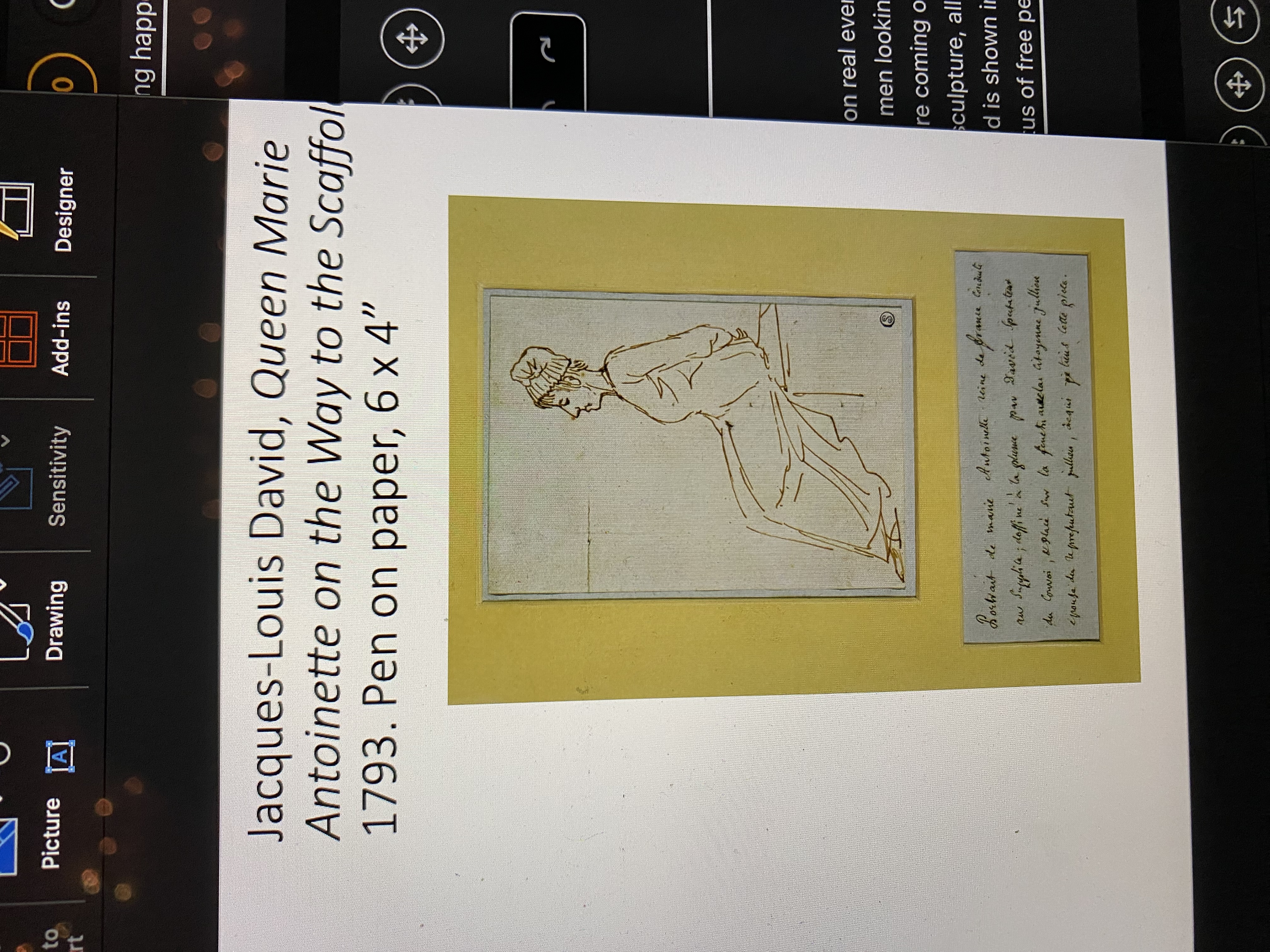
Jacques-Louis David, Queen Marie Antoinette on the Way to the Scaffold, 1793. Pen on paper, 6 x 4”
Marie Antoinette in prison, she looks common and plain, good posture, facial expression is serious and distinguished, David always wants to be on the winning team
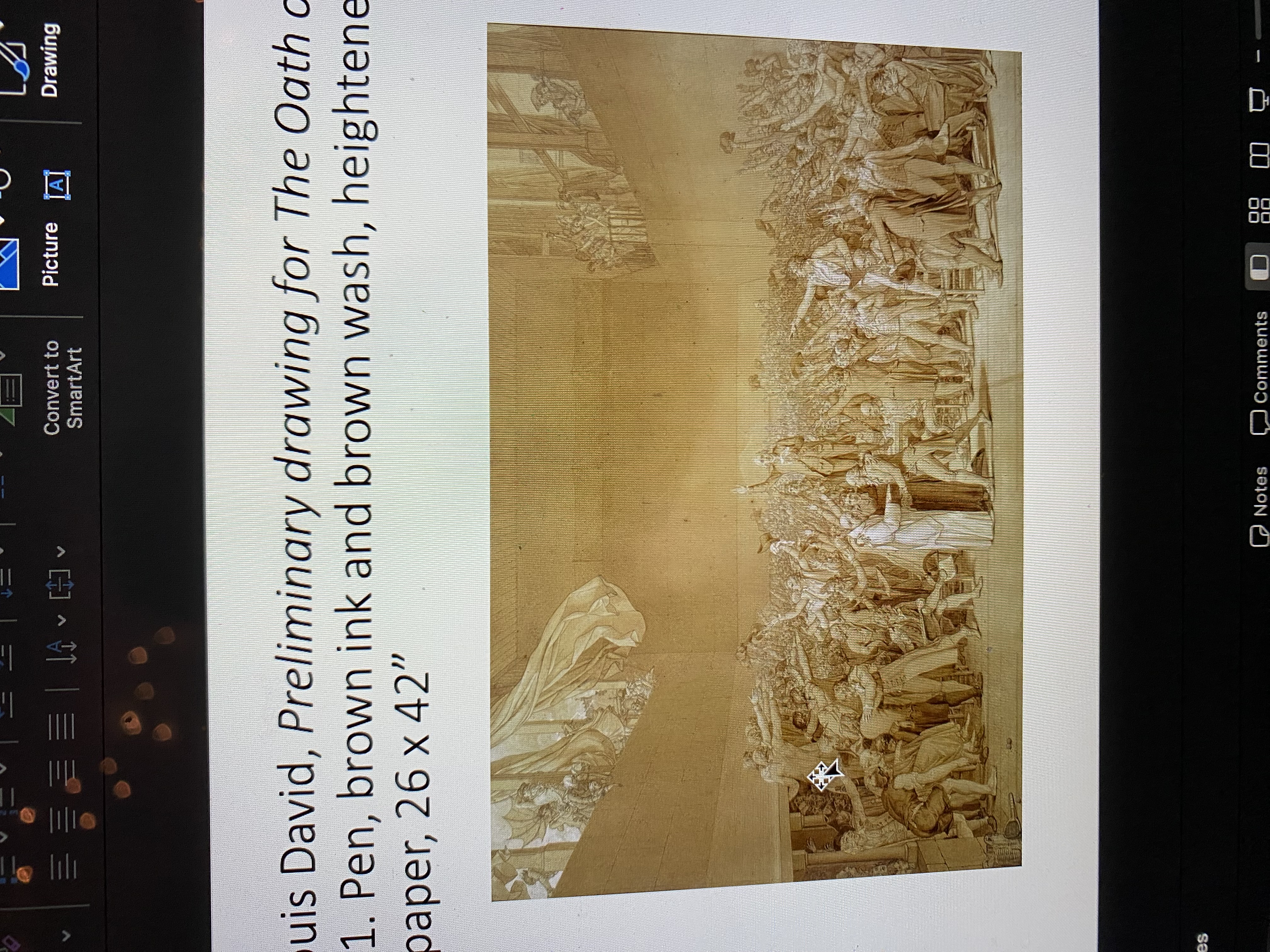
Jacques-Louis David, Preliminary drawing for The Oath of the Tennis Court, 1791. Pen, brown ink and brown wash, heightened with white, on paper, 26 x 42”
To write new constitution in indoor tennis court, never finished painting, everyone is uniting to over throw the king, monk supports, monk preist and protestant minister in front together to unite, people over flowing in window, people began fighting, decisions to start a revolution for freedom,
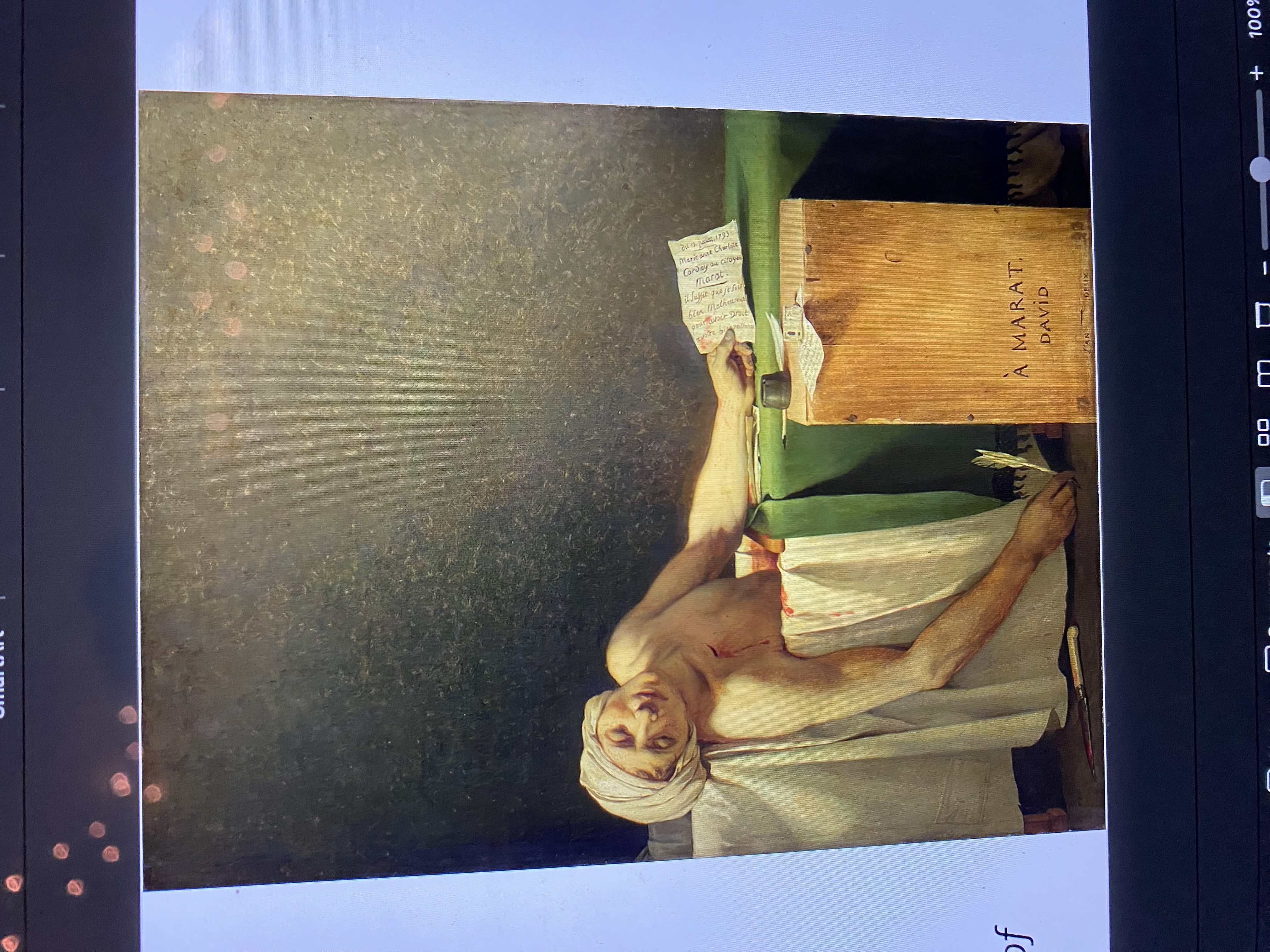
Jacques-Louis David, Death of Marat, 1793. Oil on canvas
Girodins:belived they shouldn’t over throw king, David’s friend Marat put out newspaper, belive they have to use violence in revolution, Marat was murdered, was working on publication, he had skin issues and look medicinal bath,sCharollet Corde stabbed him in bath, got caught and got head cut off, Marat became martry for revolution, fresh blood on sheets, agony in position no one has found him, still holding quil and paper, knife can be seen in bottom L, “to Marat from David” on wooden block, white head covering – fight for justice is timeless, David usually does moment before something happends, David here does the moment after something happens
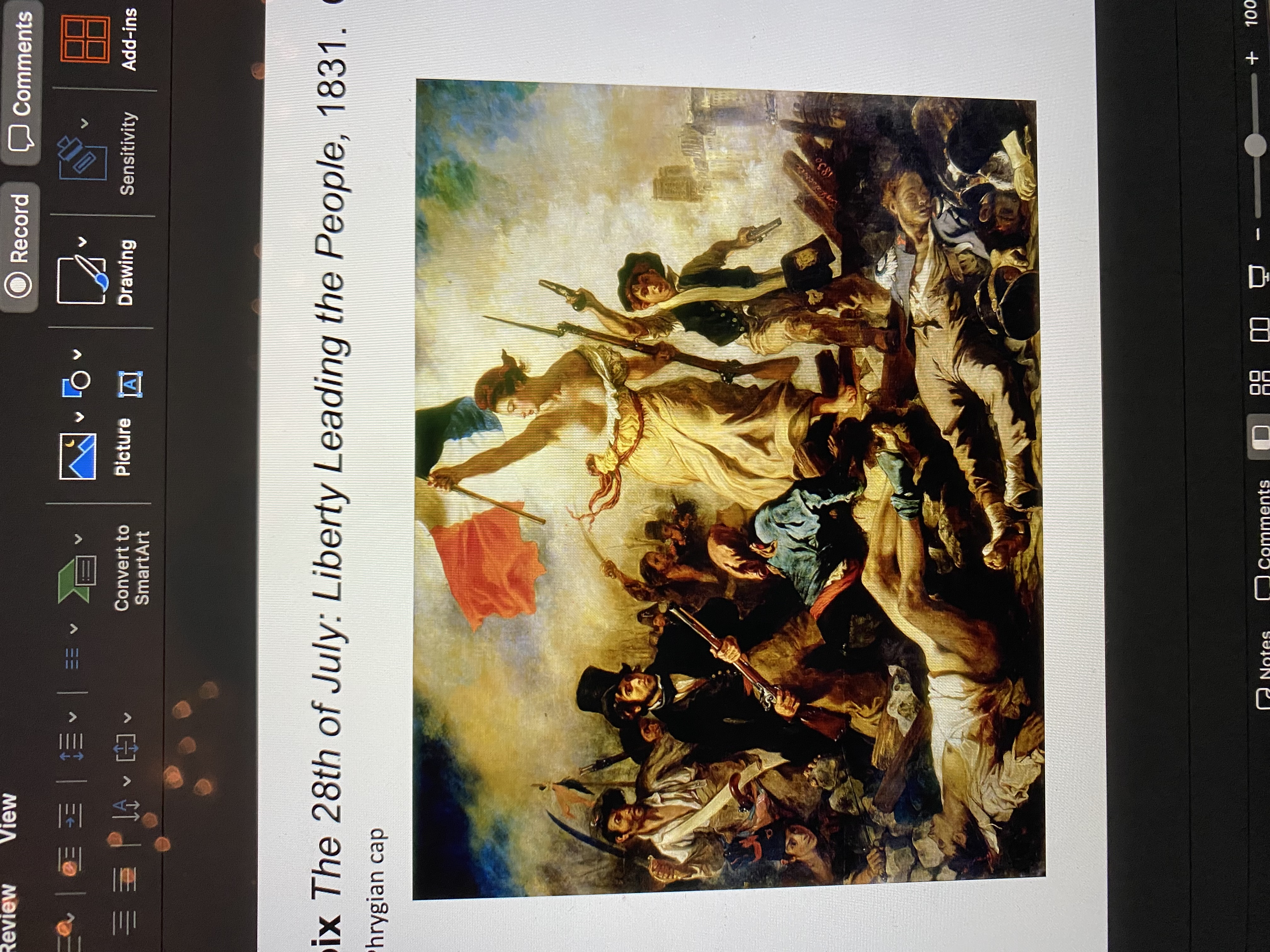
Eugène Delacroix The 28th of July: Liberty Leading the People, 1831. Oil on canvas,
8'6 3⁄8" × 10’8”.
Commemorate three day battle to over throw government, based on real event, not realistic, “Three Glorious Days”, future looking up to new republic, men looking up to women, large history painting, woman is a phantom, her clothes are coming off and she is leading the battle (doesn’t add up), she looks like a Greek sculpture, allegory-device/image meant to represent a political or moral idea, her head is shown in profile like Greek coin, cap she wears is a symbol of freedom, shows status of free people,
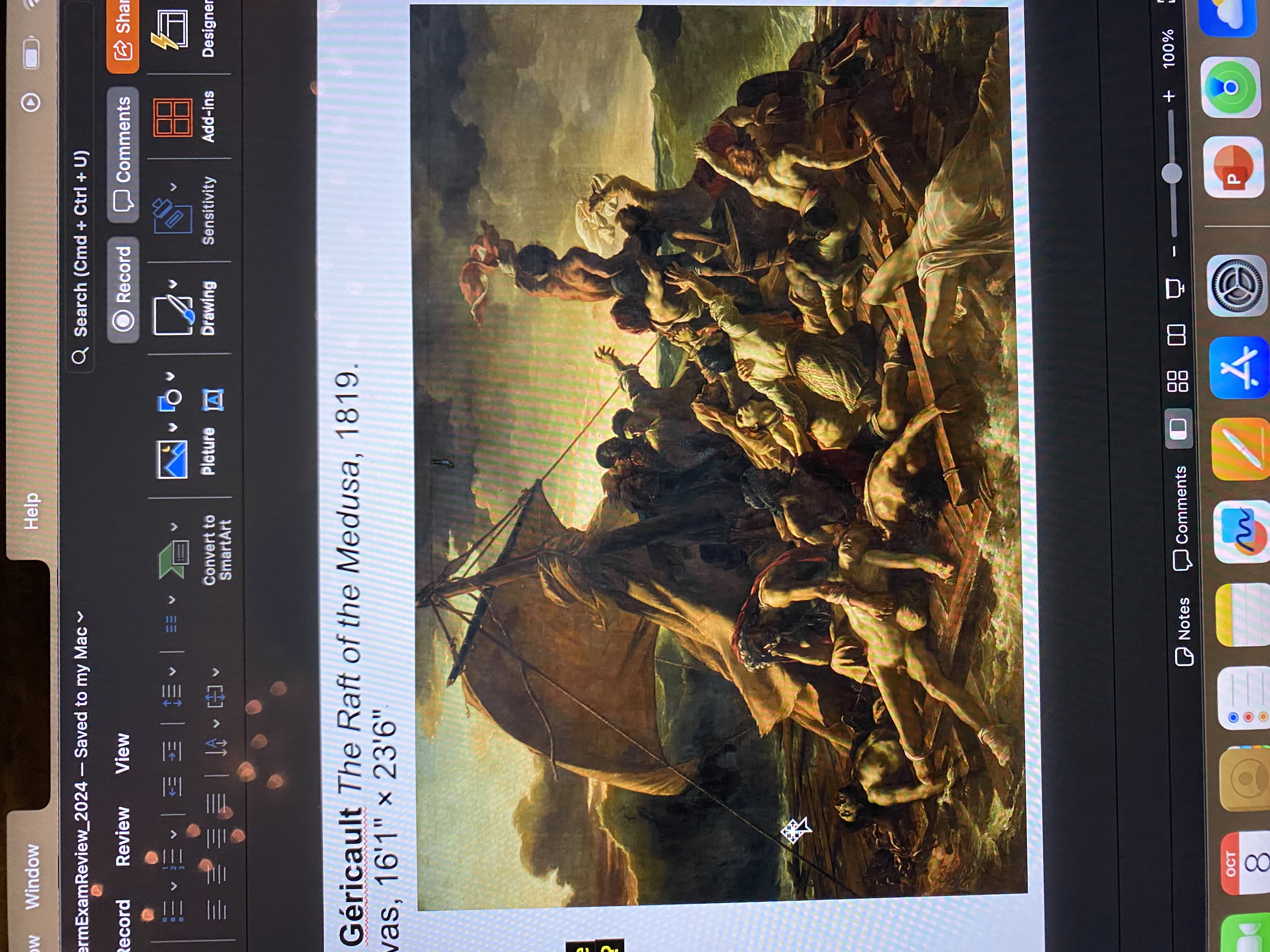
Théodore Géricault The Raft of the Medusa, 1819.
Oil on canvas, 16'1" × 23'6"
Man spotted tiny boat, waving to be rescued, gericault had to rent a studio to compelte painting, 1816 ship medusa was transporting colonist to Africa to continue slave trade, otw ship runs aground in W coast of Africa, not enough life boats, ship’s carpender made life boat for 160 people, people o flife boats lie the raft to them, raft slows them down so they cut the raft, 15 of 150 survive, recused by argus boat, brought back to France, 5 more died otw home, surviors wrote accounts of what happened on raft, cannibalism death, captain of ship was appointed bc of who he knew, he was not qualified enough, corruption in French government, triangle composition, those who have hope on right side, those who have lost hope/dying on left side, father mouring son, gericault went to morge and drew the limbs and dead bodies, men are dressed very plainly poor, missory, waves are getting larger in background, storm coming in horizon, there is no moral, wasted lives horrific things that huamns can do to eachother to suvive
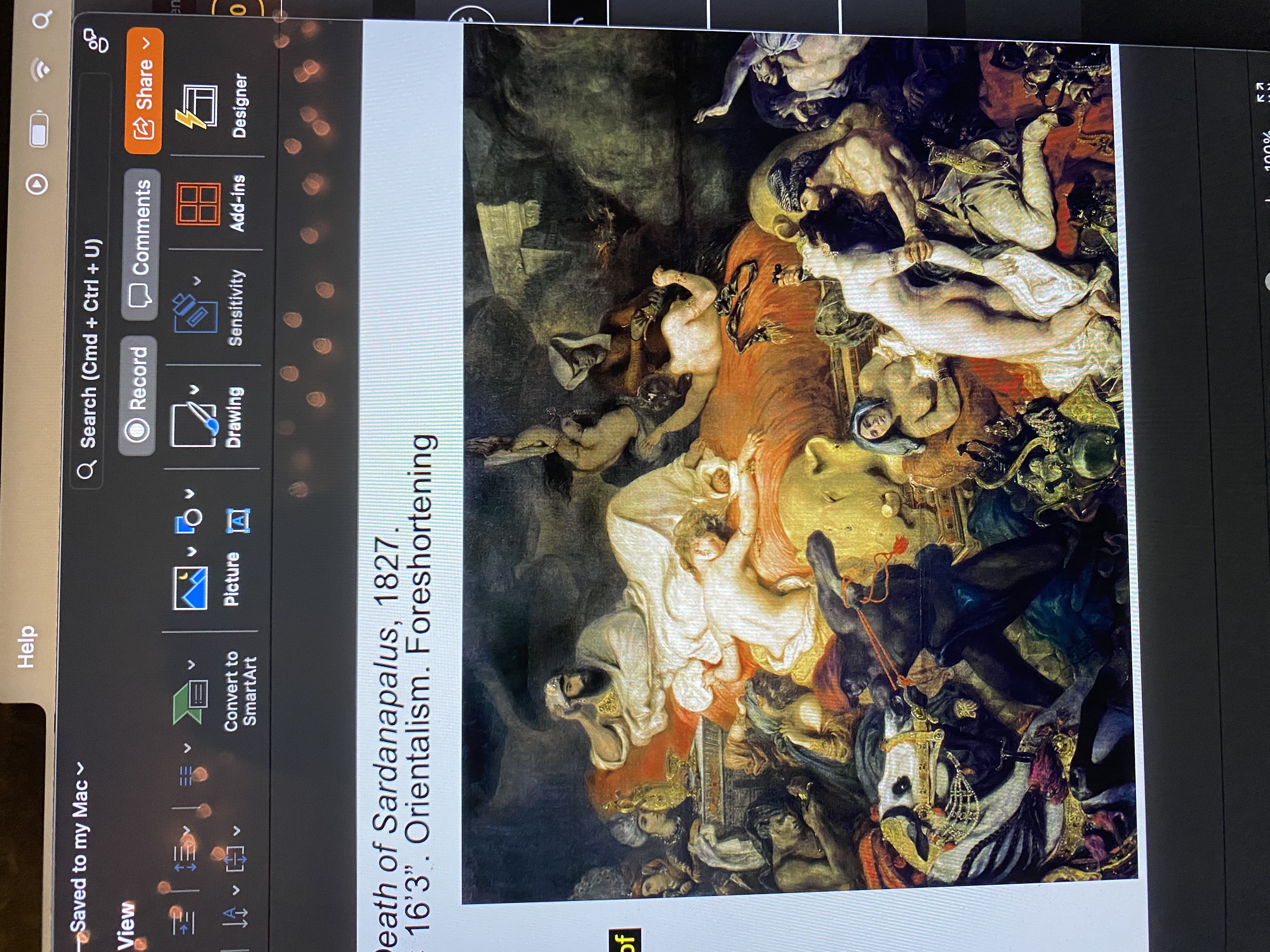
Eugène Delacroix The Death of Sardanapalus, 1827.
Oil on canvas, 12'111⁄2" × 16’3”. Orientalism. Foreshortening
Not based on current event, based on popular play, Lord Byron handsome popular wrote play based on arsyrian king, king in all white, sardenapalus found out his enemy is coming to take over his palce, he knows he will loose, doesn’t want enemy to take his horses and women and gold, orders them to kill and get rid of everything special he owns, orientalism-describe what is going on, W view of E, steriotypes of French artists-naken women, embelishment on horse, turban on head, Delacroix went to north Africa but depended on accounts of culture, 1827 salon, critizied for impagination going too crazy, free loose brush work, foreshortening-bed looks shorted and distorted to look closer toward us, no hero, disorganized, everything In movement, shadows have greens and blues
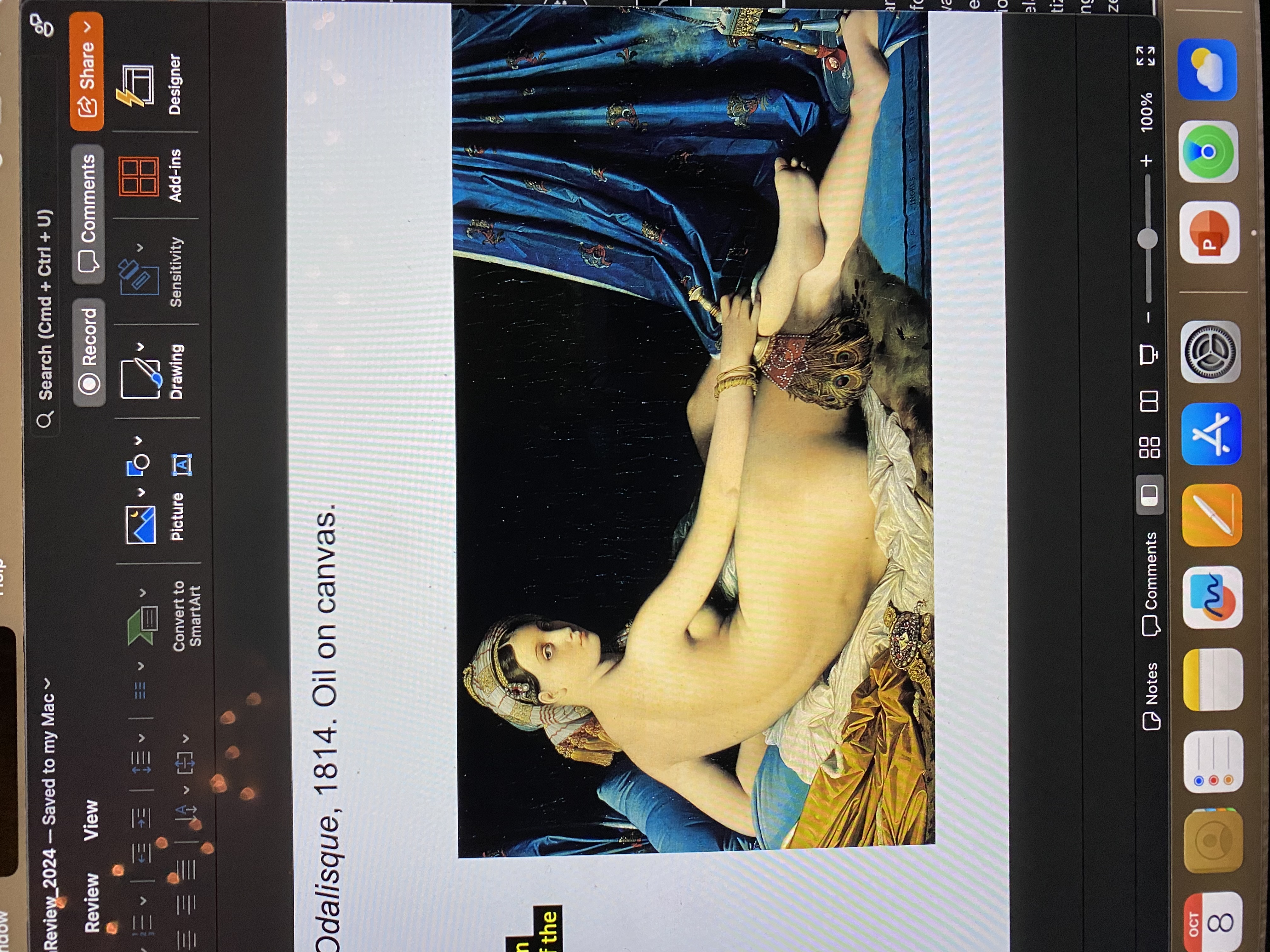
Ingres, Grande Odalisque, 1814. Oil on canvas.
Orientalism: how the east thinks about the west (steriotypes), east interested in depicting women, women not out in public a lot, there was a sense of myserty around them, the women they depic are very white, turban on her head, fly swatter shows the severe heat in here residence, turcoise color, odalisque: reclining female nude, this is an imaginary scenario, her back is too long-to make her look more elegant, no narrative context, scandalous, orientalism in neoclassic style, everything has rounded edges, pushed up like a stage
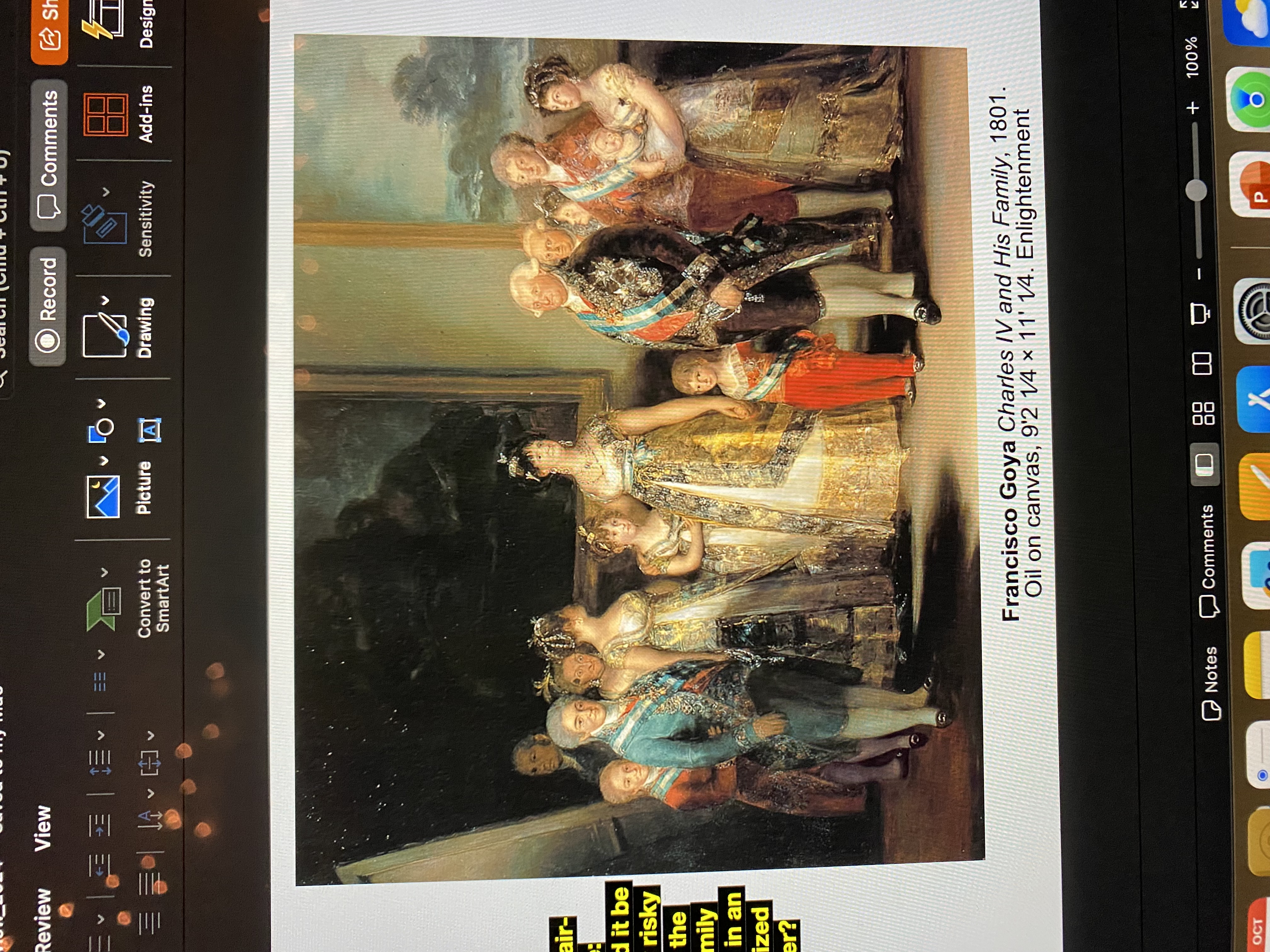
Francisco Goya Charles IV and His Family, 1801.
Oil on canvas, 9'2 1⁄4 × 11' 1⁄4. Enlightenment
King Charles the 4th with his family, unidealized portait of the royal family, politically risky, some people are hidden, men standing in front of everyone, family is separated by son, goya has put himself in back left corner, looks like the moment before a family photo, goya and royal family looking a mirror, goya is making the painting by looking at the mirror, everyone got an outline and then stood separately for the painting, mirror is infornt of everyone and goya is paiting what he sees in mirror, doesn’t idealize them, kings cheeks are redish, faces are realistic, can see folds on her neck and wrinckles, royal families belived they were ordained by god to rule, enlightenment-evolution, rationalism encourages goya to make the family look less god like, politically risky bc monarchs saw what happned in France, century of revolutions,
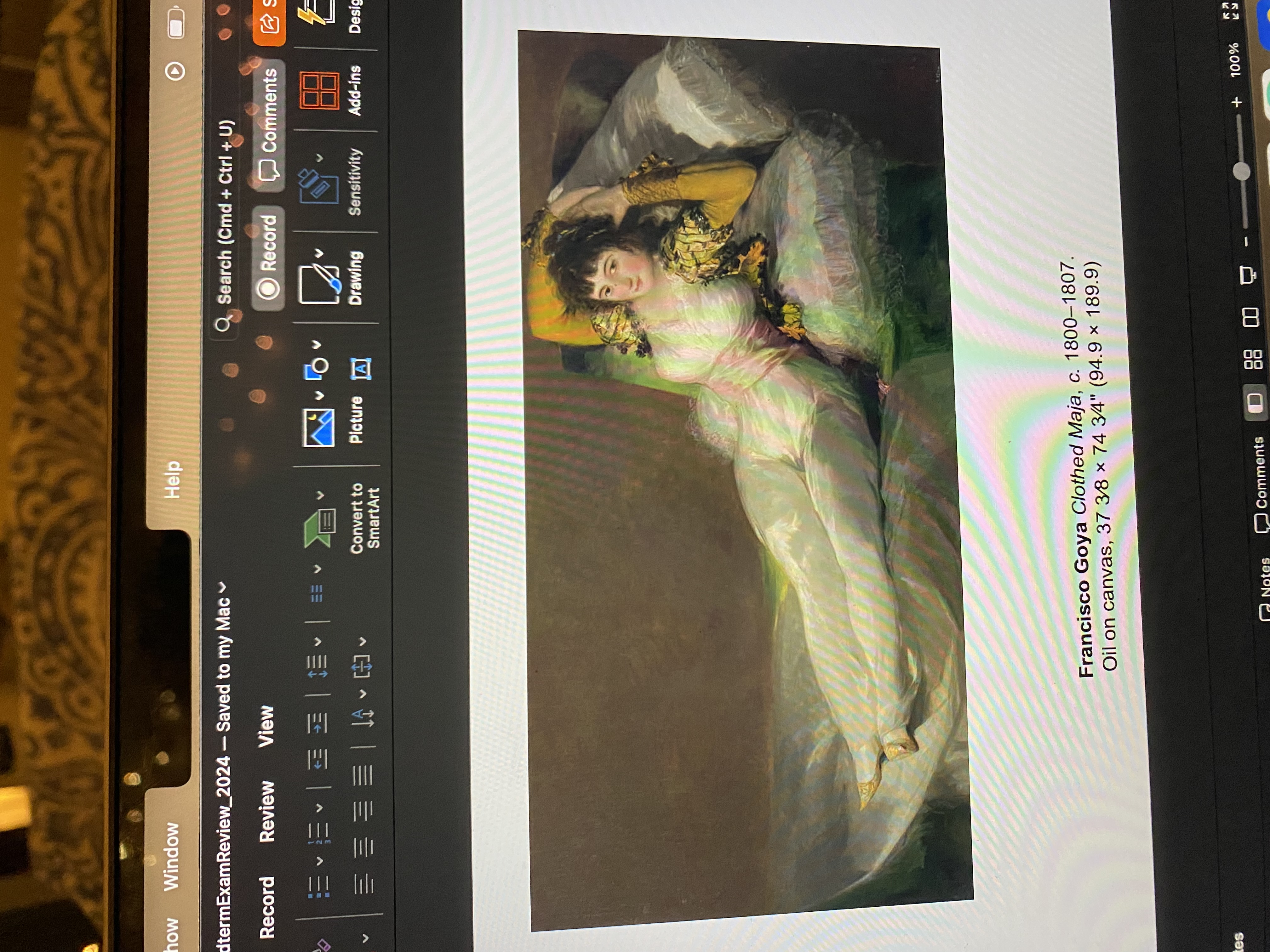
Francisco Goya Clothed Maja, c. 1800–1807.
Oil on canvas, 37 3⁄8 × 74 3⁄4" (94.9 × 189.9)
No context for why she is nude, no story, no false modesty, two elbows “sexual penetration”, no attempt to be modest, not hiding anything, laying on fancy chair, silky/velvet, high class place, strong diagonal composition, feet –hands/arms, brightest colors on top, drawn to chest, annoynmous women, thought to be duchess of holda? Spanihs painters drawn to maja’s, lower classes of Spanish society, who would dress up in costumes and act silly/funny, upper class started to dress like them-queen of spain dressing like lower class person in costume, was hanging over doorway in palace, confiscated by Spanish inquisition to end heracy, deemedobsene, modern/of the era, contemporary women
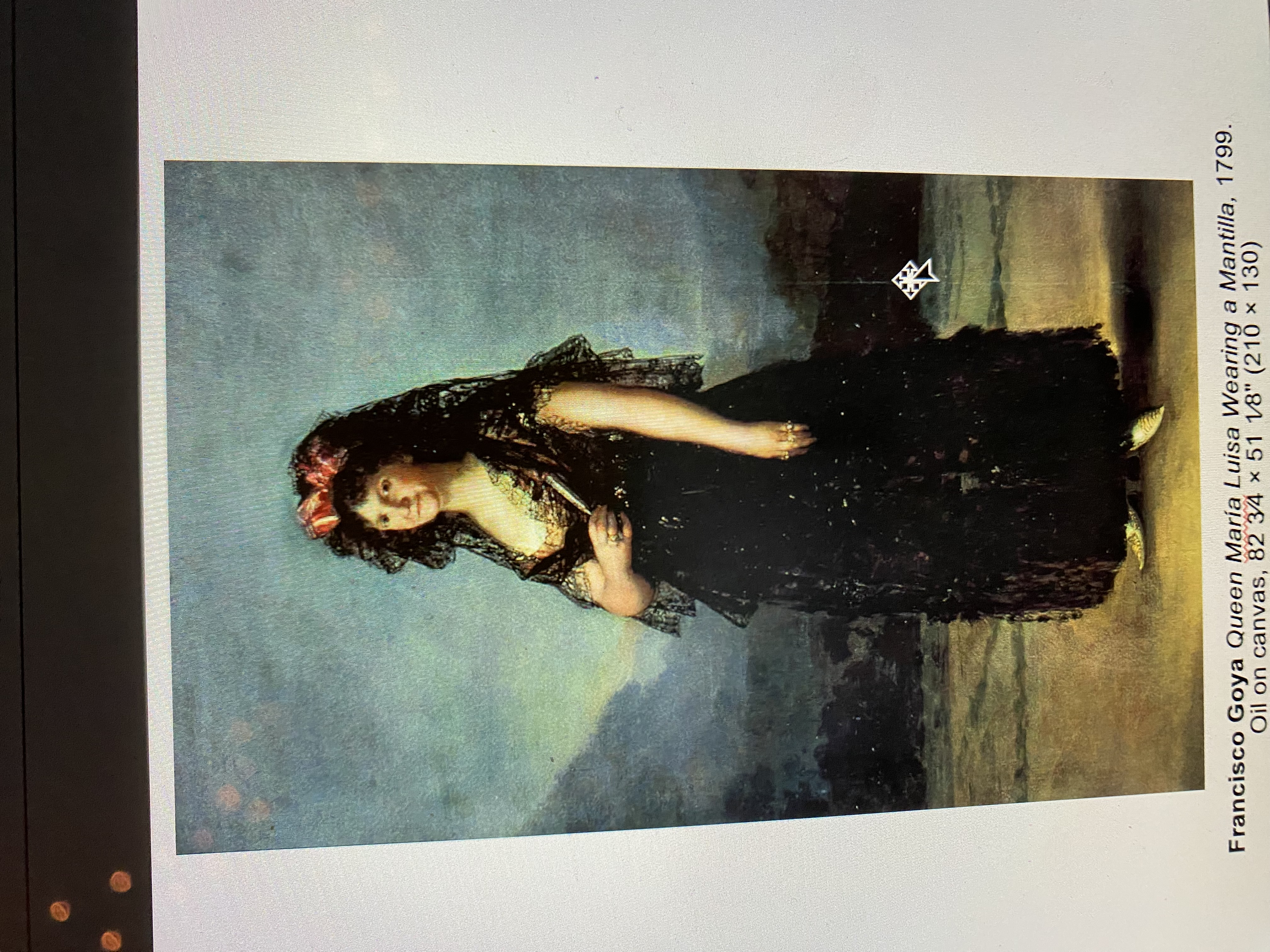
Francisco Goya Queen María Luisa Wearing a Mantilla, 1799.
Oil on canvas, 82 3⁄4 × 51 1⁄8" (210 × 130)
upper class started to dress like them-queen of spain dressing like lower class person in costume, upper class following trend, queen loved painting
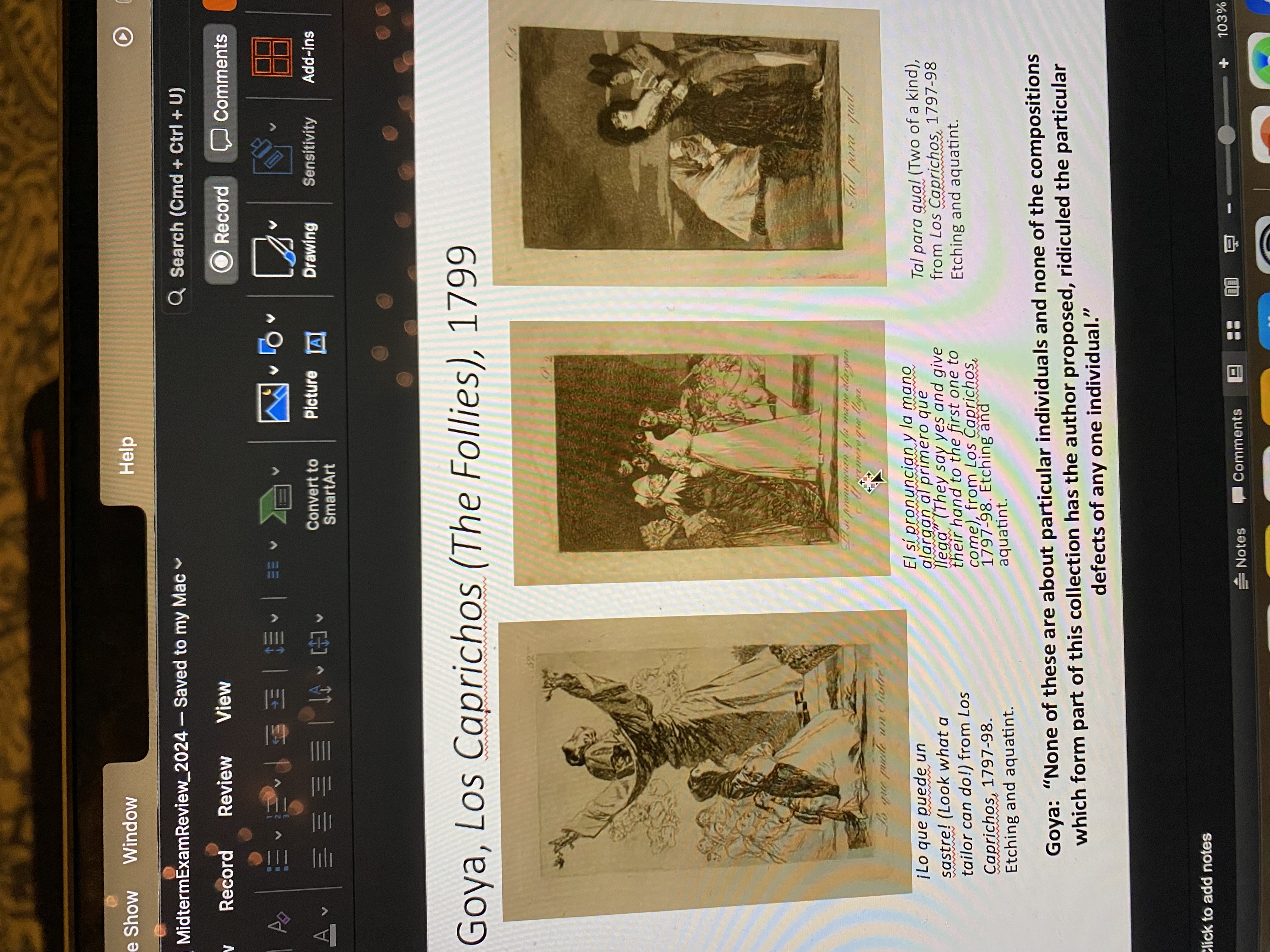
¡Lo que puede un sastre! (Look what a tailor can do!) from Los Caprichos, 1797-98. Etching and aquatint.
El sí pronuncian y la mano alargan al primero que llega” (They say yes and give their hand to the first one to come), from Los Caprichos, 1797-98. Etching and aquatint.
Tal para qual (Two of a kind), from Los Caprichos, 1797-98 Etching and aquatint.
Print series-the follies, print maker, under a theme-follies, Spanish intitutions, goes after church/king/common person, its not about you but its based on you, laughing at everyone, goes after generals, “look what a tailor can do”-tree, fear of ghost, work of tailor making clothing, critique of superstition, “they say yes and…”- she is marrying an old ugly men, critiquing the marriage, “tow of a kind” –prostitution, man is about to pay for her services, if person owned one of these books-could get in trouble with Spanish inquisition,
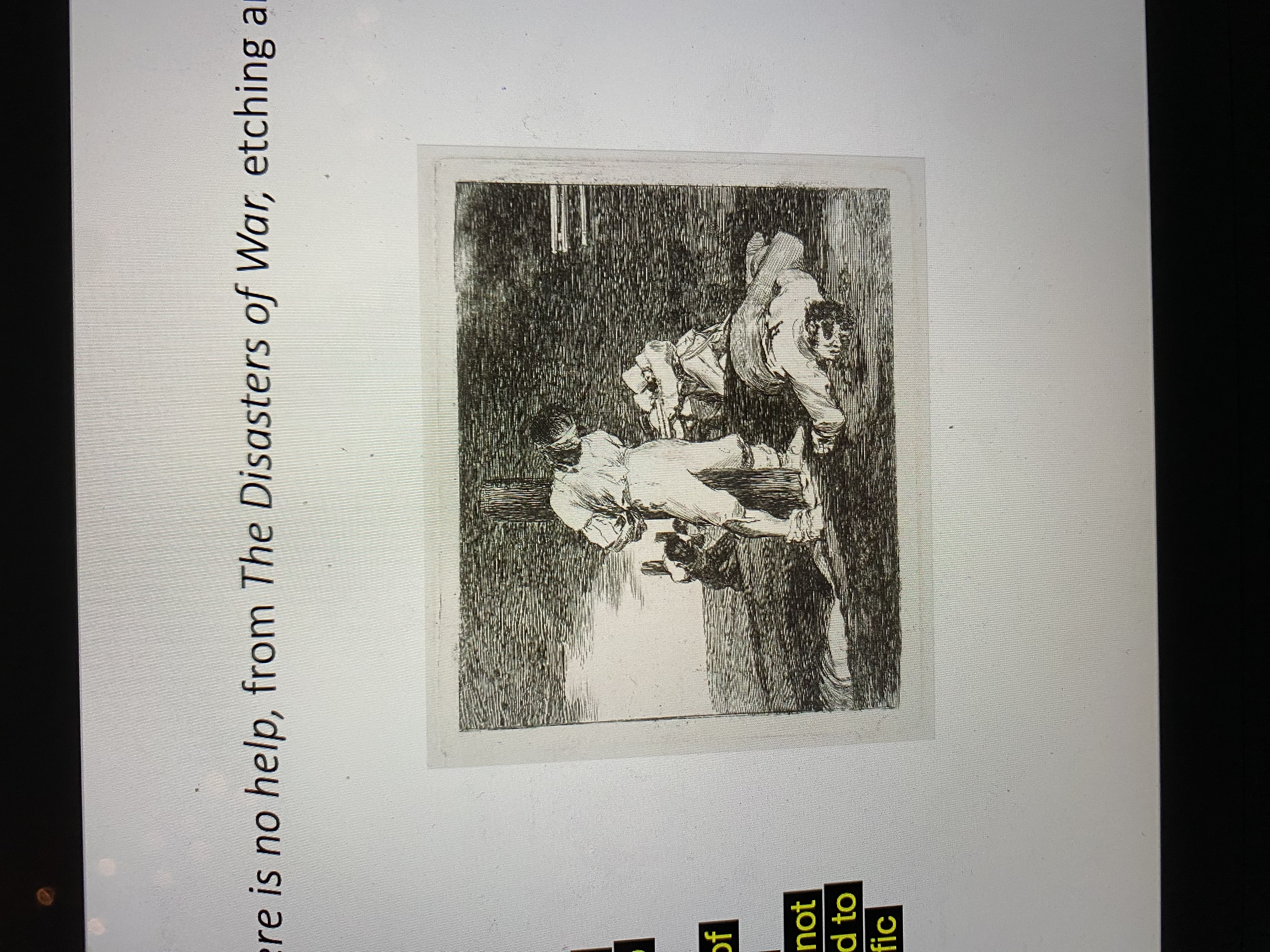
Goya, And there is no help, from The Disasters of War, etching and drypoint, 1810.
French under napoleon occupy spain, napoleon invads in 1807, violent protests against French, documents horror, only one print shows heroic action, the other 81 show violence and suffering, not puplished till 35 years after goya’s death
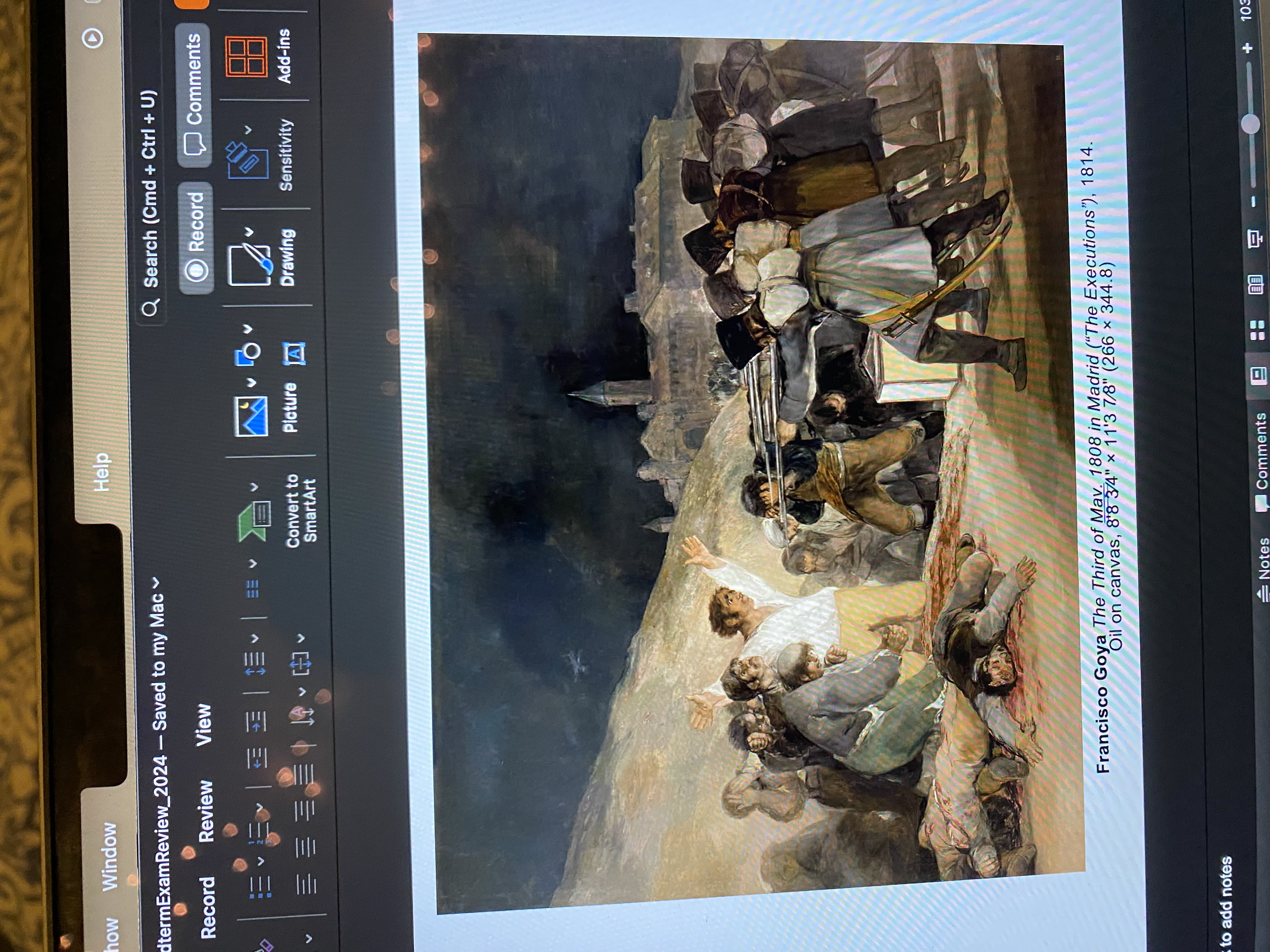
Francisco Goya The Third of May, 1808 in Madrid (“The Executions”), 1814.
Oil on canvas, 8'8 3⁄4" × 11'3 7⁄8" (266 × 344.8)
Rise up against Spanish, French soldiers on right, turned away-no face, anynyous, executioner vibe with hats, can’t have empathy for those you cannot see, supposed to feel empathy for Spanish-man with hands up, giving up but guns still pointed at them, see faces and feel the same emotions, blood on ground, crowched and scared, christ like pose, vulnerability, white flag of surrender, light source on man, setting in background tells us we r in spain, contemporary history painting,
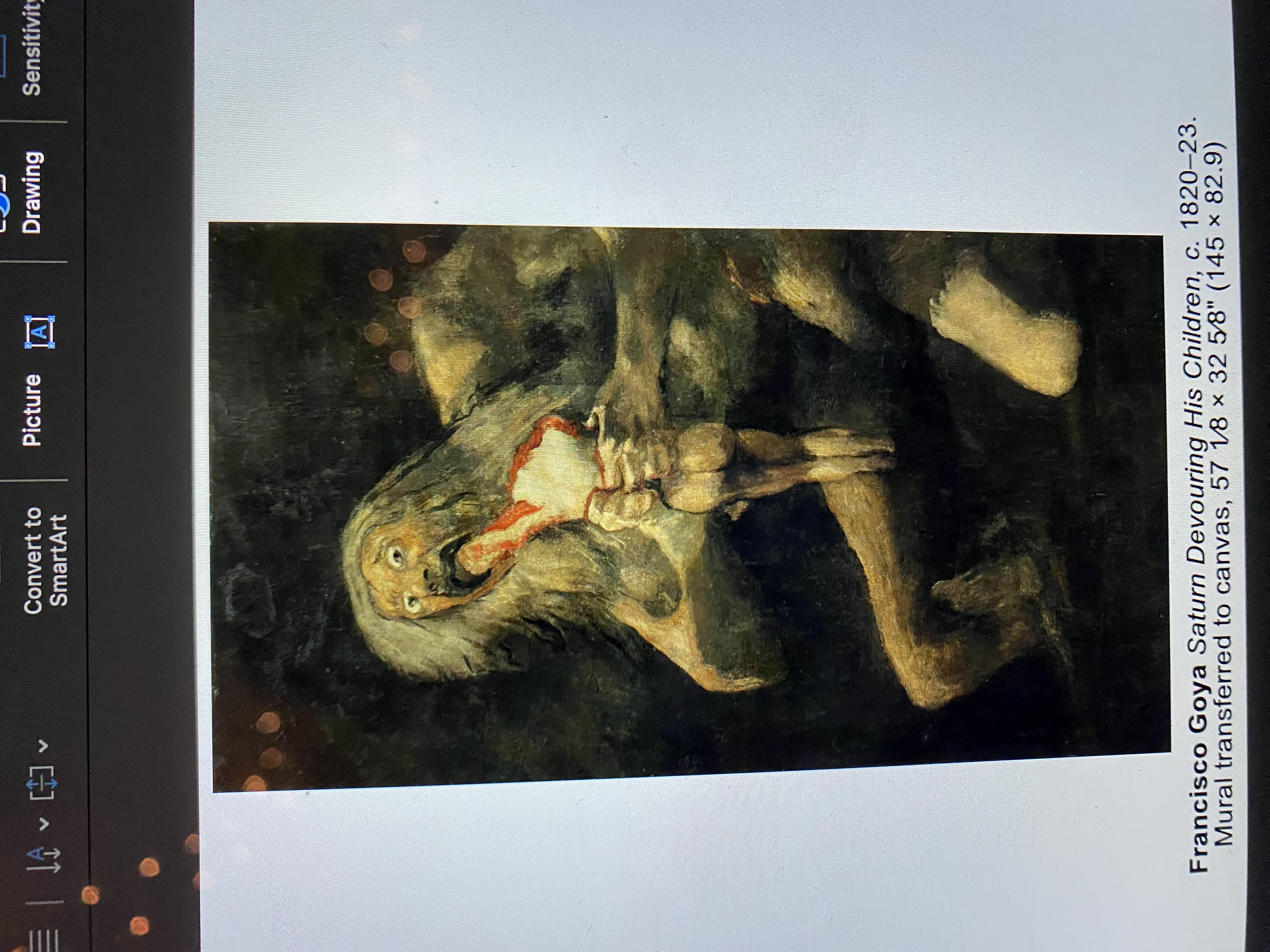
Francisco Goya Saturn Devouring His Children, c. 1820–23.
Mural transferred to canvas, 57 1⁄8 × 32 5⁄8" (145 × 82.9)
mural transferred to canvas, was in his own home, ”black paintings”-painted on the walls on his home, Saturn was profesized that one of his sons would dethrone him, eats sons as they are bonr, misses one-Jupiter, Saturn is dethroned bc he was trying to reverse his own fate, Jupiter successfully dethrones Saturn, Saturn messes with his own fate and looses, politicians only want to have power-becomes desire to stay in power, not about helping community, limited color palet allows red to stand out, scared animal caught in act of doing something horrible, scared reluctancy, Abraham and isaac called to him by god, animalistic, hair is like main, hands are like retracted claws, legs look thin like an ape, try to make him look not like a human
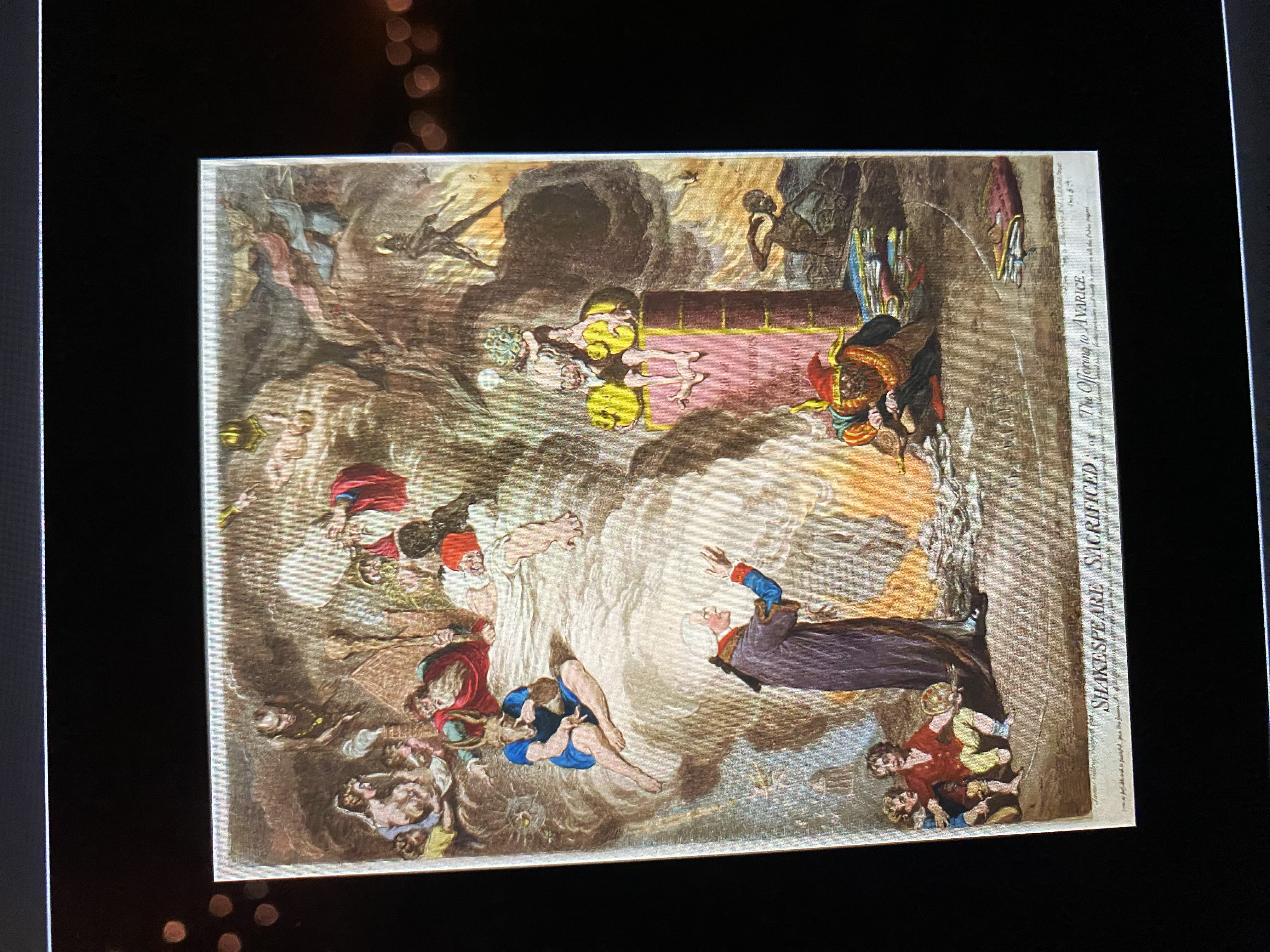
James Gillray, Shakespeare sacrificed; -or- the offering to avarice, 1789. Print
England 1789, shakespear, print, gillray is popular in GB, critique of Boydell had a gallery in popular area of London called shakespear gallery, he found artisit and said I would like you to make paiting related to shakespear, make prints and sell them, people come pay to see paintings, all of shakespears works into the fire, boydell being greedy, sitting on shakespear book, holding money bags, sacrificing beauty of shakespear for personal gain, boydellwas alterman of London, getting too big for riches, trying to do too much, gillray wanted to be an engraver at gallery, gillray makes this after turned away from job, make lesser version of shakespear and make money form it
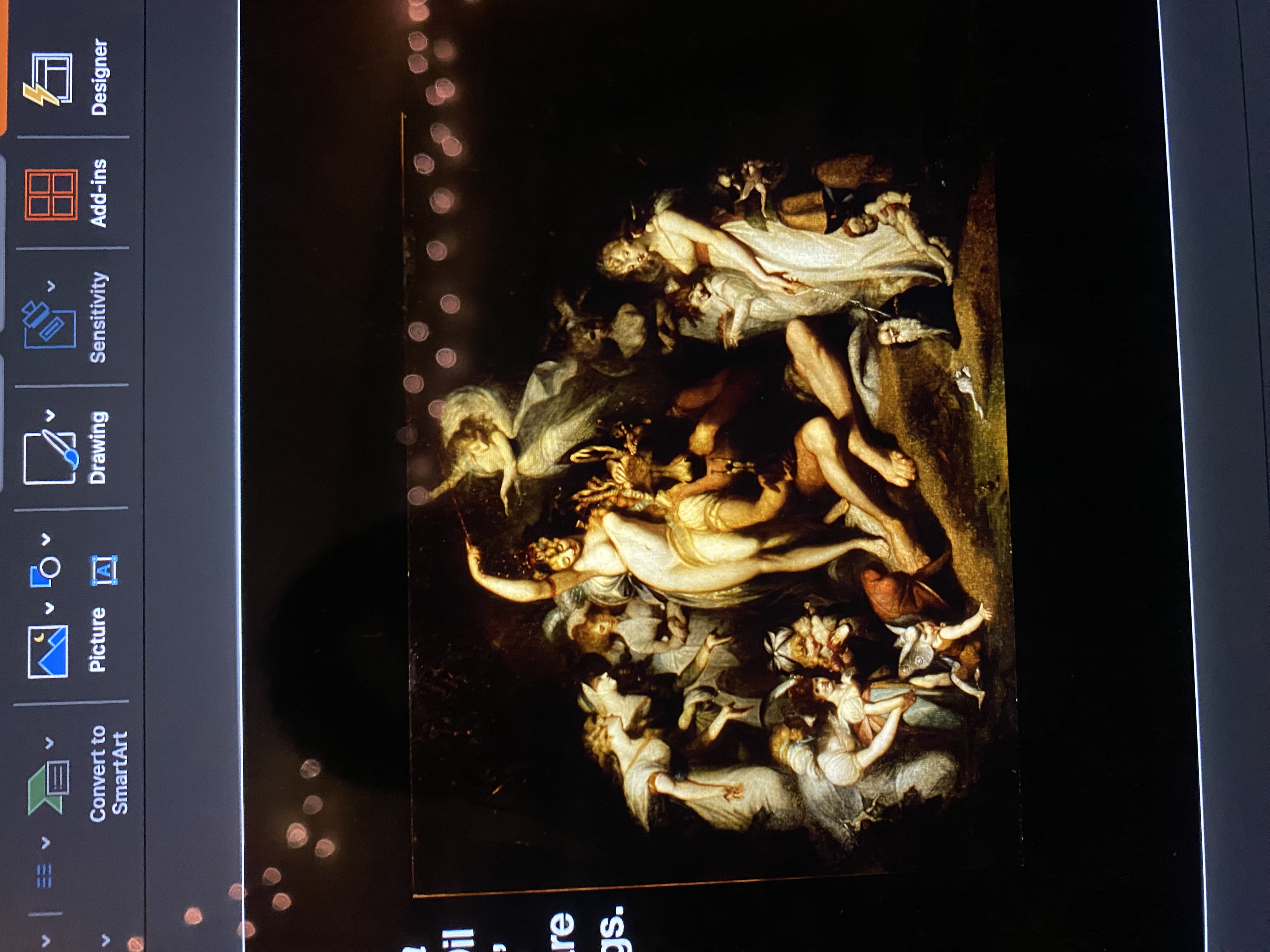
Henry Fuseli. Titania and Bottom, 1790. Oil on canvas. 7’1” x 9.’ Boydell’s Shakespeare Gallery. Fairy paintings. Engravings
Swiss artist in London, boydell’s favorite painter, beautiful color and tone, scene from a mid summer nights dream, bottom/queen falls in love with man with asses head, “fairy paintings”, darker subjects, creepy figures thru out, weird muscular babies, man on leach, 1804 gallergy closes, wars in France, subscriptions drop, supply chian drop, cannot continue sale
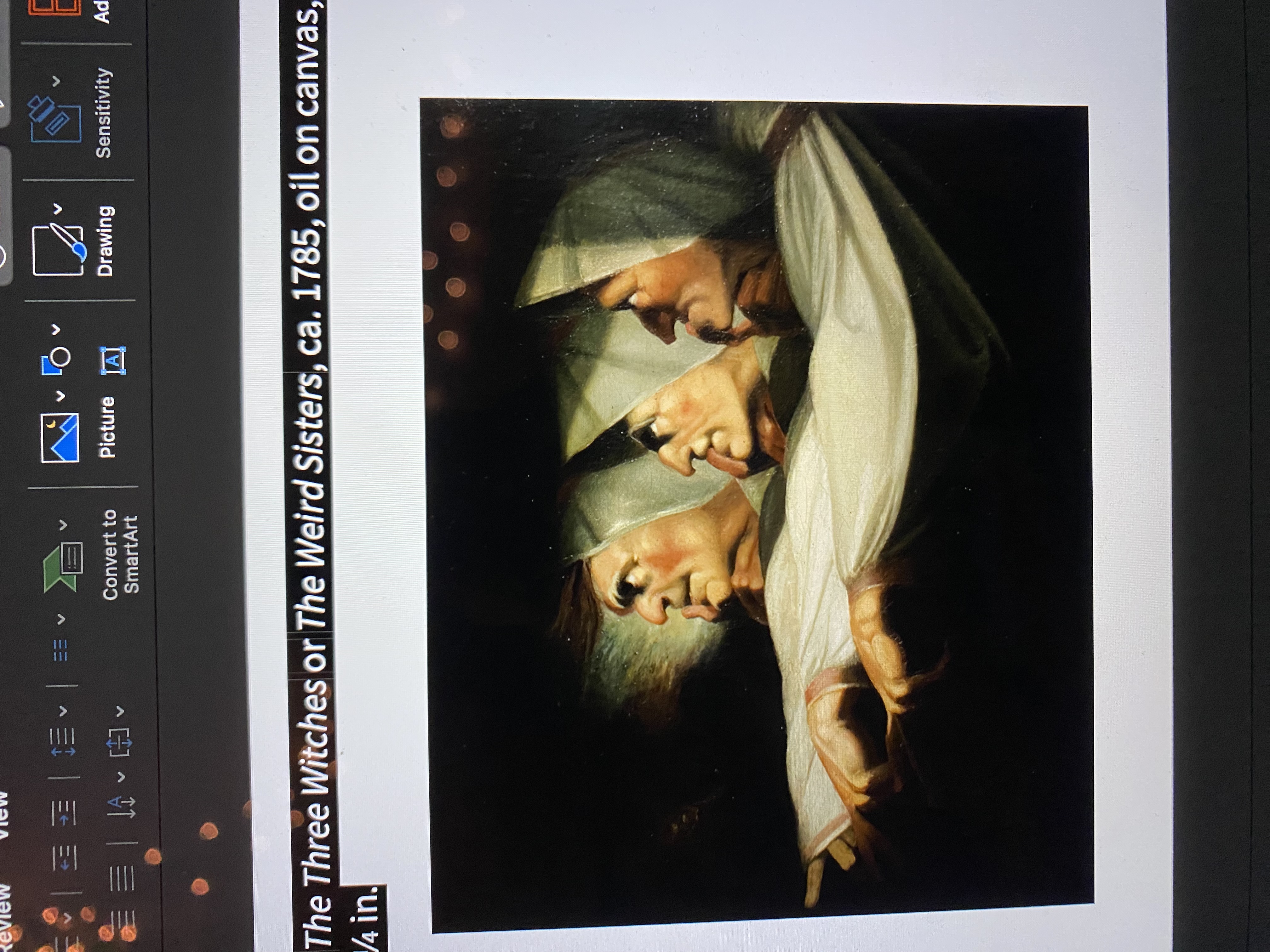
Fuseli , The Three Witches or The Weird Sisters, ca. 1785, oil on canvas, 24 ¾ x 30 ¼ in.
Three witches/weird sisters, McBeth play, elderly/masculine face, witch nose/hoocked, have beards, hideous looking, was popular, multiple versions made, dramatic moment where witches tell MacBeth his fate
Print after the painting, Smith is the printer, smith spent 7 years in rome studying art, profile view looks like roman emperors on coins, orinter maker added hairs and tounge,
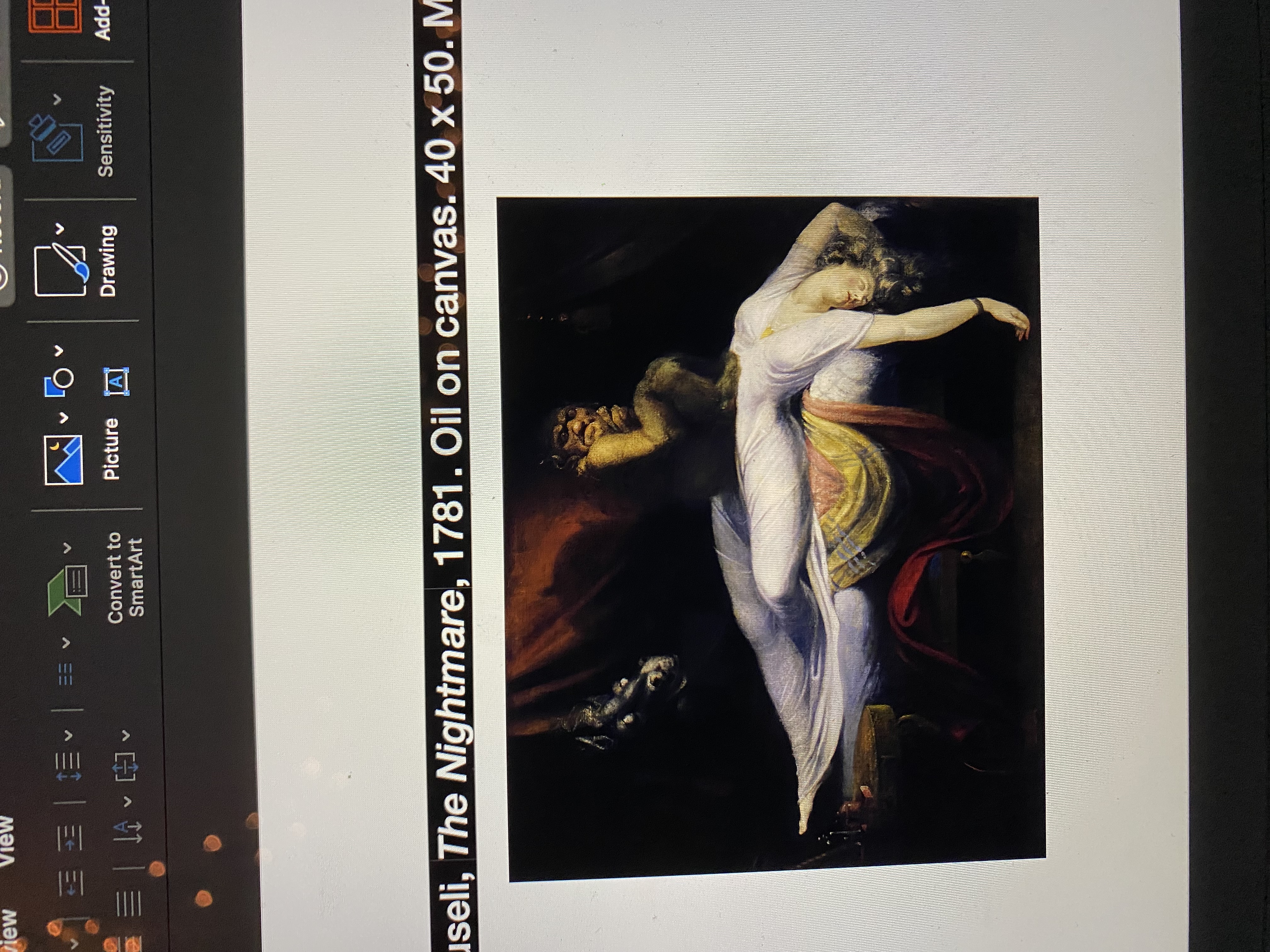
Henry Fuseli, The Nightmare, 1781. Oil on canvas. 40 x 50. Mara
Darker than a female nude, this got fuseli his reputation and known for style, mara-refers to an evil spirit, figure on top of women, she is sleeping/death/poisoned, horse on side, dramatic red curtains, mara-monster belived to cause monsters, he is condensed, in shadows, women-makes her look holy, women is falling off be d and in distress, body could almost be nude bc clothes are so tight, montainmodesty, sexual assult, bursting eye, she is over her abdomen, stares out like nothing he can do, black stalonefor symbol for penetration, thru curtain, intense emotion
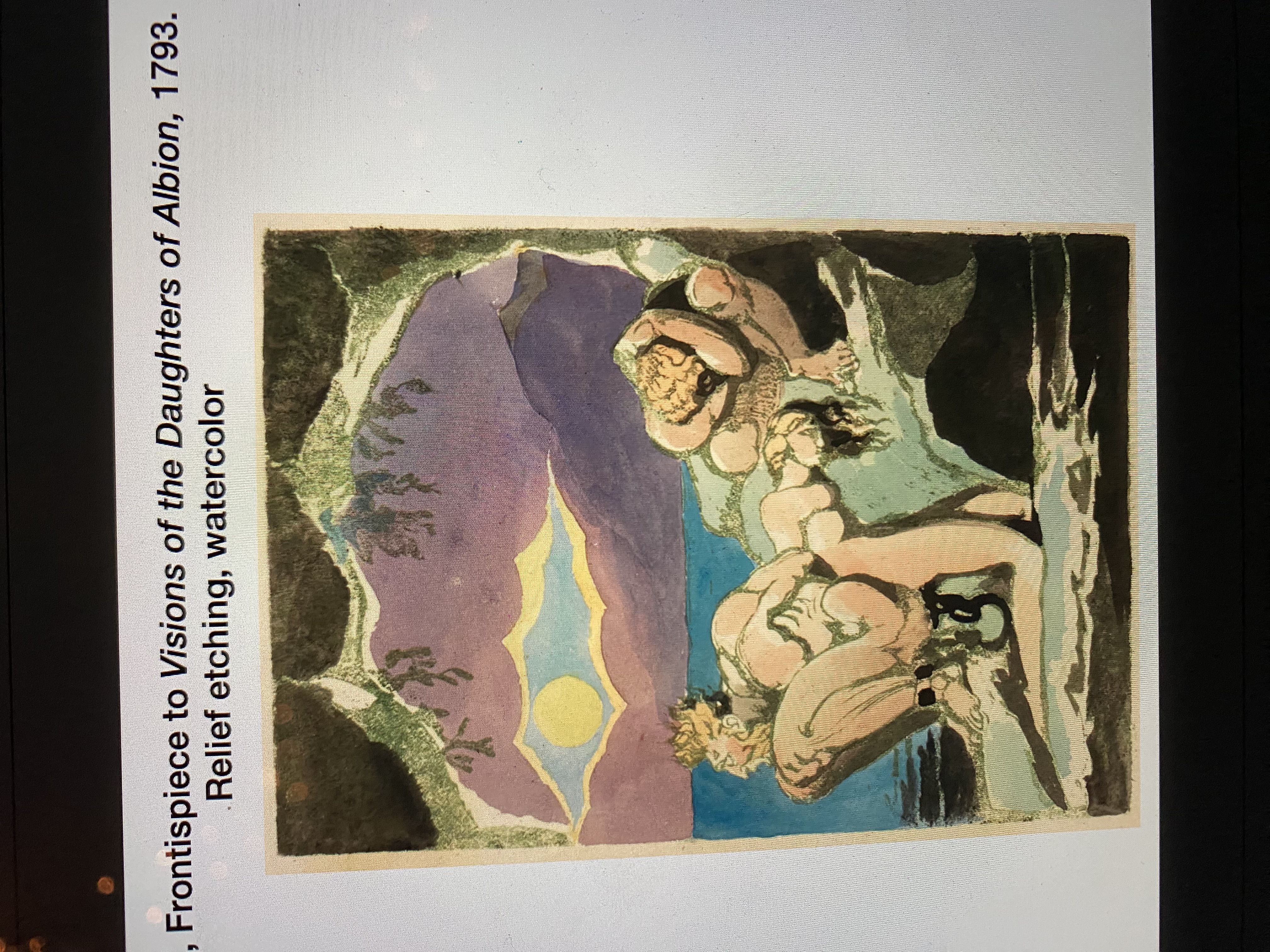
William Blake, Frontispiece to Visions of the Daughters of Albion, 1793. Relief etching, watercolor
Mythology, tied up to women, sexual assalt, lover at top won’t have her anymore, cannot contain terribleness of humanity, he is beliver in womens rights and abolitionism, hes an outsider artis, made own ideas, art could change world for the better, not well known at his time, Blake had visions that influenced his work, invented new type of printing, could print his books on his own, illuminated book-illustrated, chains-british women ar chained to tradition/taken advantage of, he is antislavery, early advocator or womens rights, three chracters are comtemplating horrors of violence and inequality
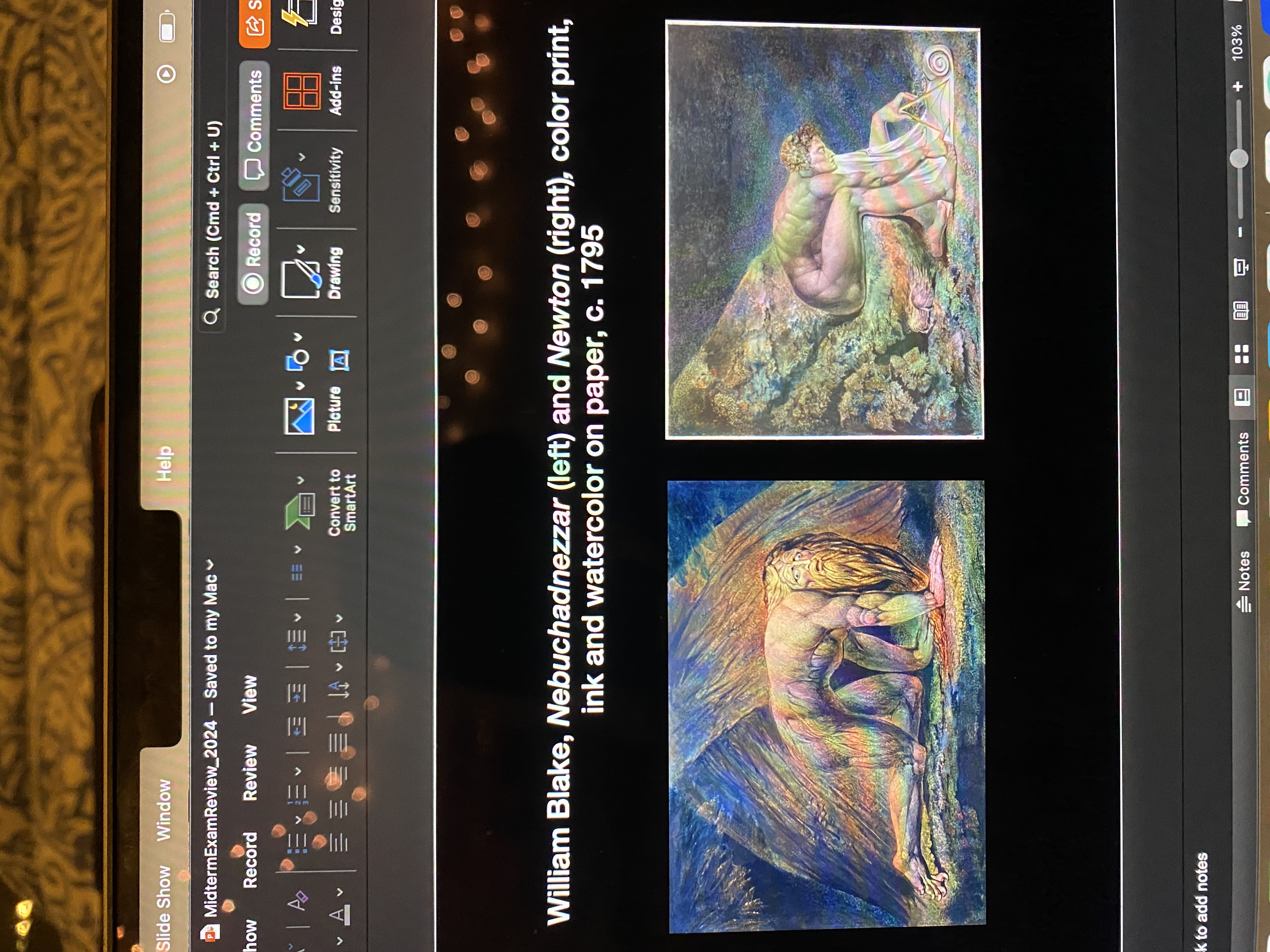
William Blake, Nebuchadnezzar (left) and Newton (right), color print, ink and watercolor on paper, c. 1795
Nebuchadnezzar-book of Daniel, villan driven mad, forced to live as an animal for his excessive pride, wild posture, face is surprised, in cave, on all fours, connecting him to his environment, Sir Isacc Newton-young, based off figure from Sistine chapel, croched over, sit on rock, newton is hyper focused on his compass, has limited view of the world,desiged as a pair, two opposites of spectrium, become animalistic-too in touch with nature, ignore nature get hyper focued on self

Thomas Girtin, Guisborough Priory, 1801. Watercolor, 26” x 19.”
Topographic study. Vertiginousness
Girtin died at 27 yr old, copy and not interesting, artist pays attention to some object-topographic study, exaggerates some things to make it clear, scale with people-larger than life building, not actually that tall in oerson, vertiginousness-vertigo and vertical, cause sublime, hyper verticalilty, if on top of tallountain-envokes terror and awe (sense of verticalility), go to sites related to English history
spiritual/religious paintingbc it reminds us of our smallness in the world, emphasis on religious structure and our small part in the plan, towering nature-closer to god
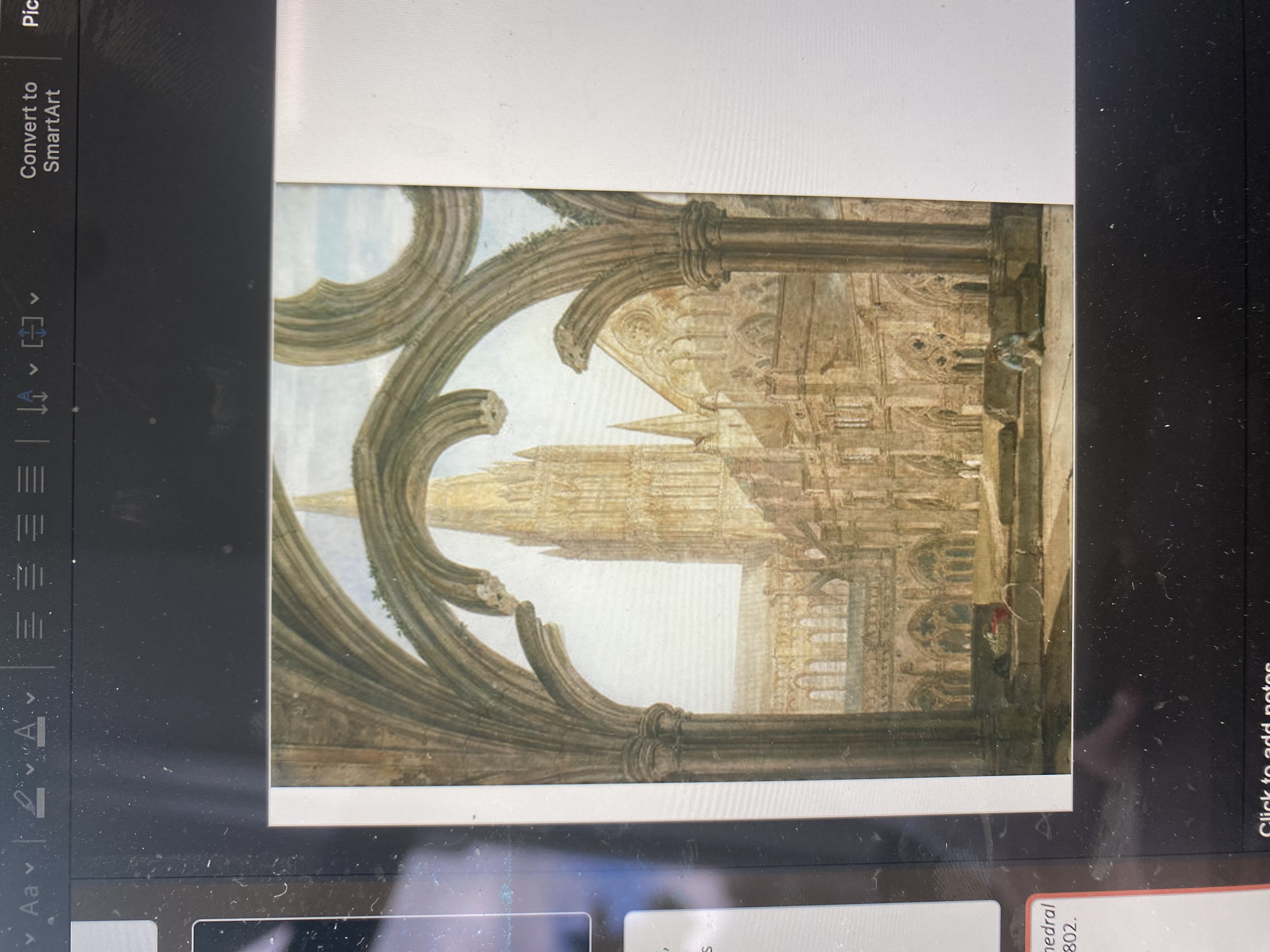
J.M.W. Turner, Salisbury Cathedral Seen from the Cloister, ca. 1802. Watercolor, 26.5 x 19’’. Topographical painting
Chiaroscuro
Turner is trying to elevate watercolors, perpective looking thru a window, person is used to show how large the building is, composition shows it photography esc, not normal landscape, tell narrative, shows decay, shows moss on structure, not image of perfection, boy has hoops that he’s playing around with, boy went to the market, got distracted, not image of past, image of present because of age and current scenery, asked turner to make accurate views of cathedral, not missing out because image hints at what we are missing, creat dark darks and light lights, chiaroscuro is hard to get dark color, contrast with light illuminating tower
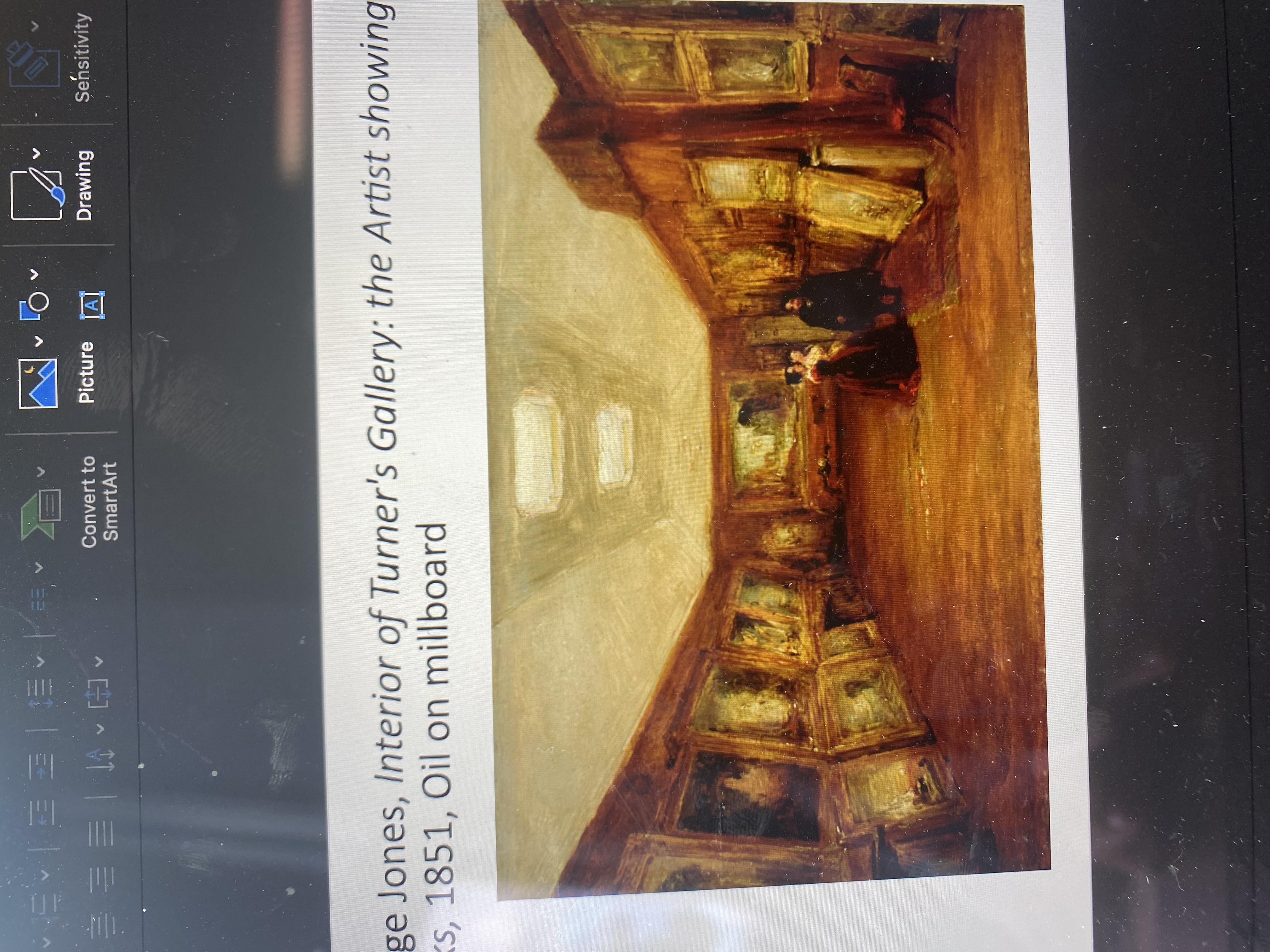
George Jones, Interior of Turner's Gallery: the Artist showing his Works, 1851, Oil on millboard
Exhibit own work in own gallery, not by Turner, Turner showing guests around, opens own work, at national salons-crowded paintings could be placed everywhere, put paintings low so everyone could see and show/sell more
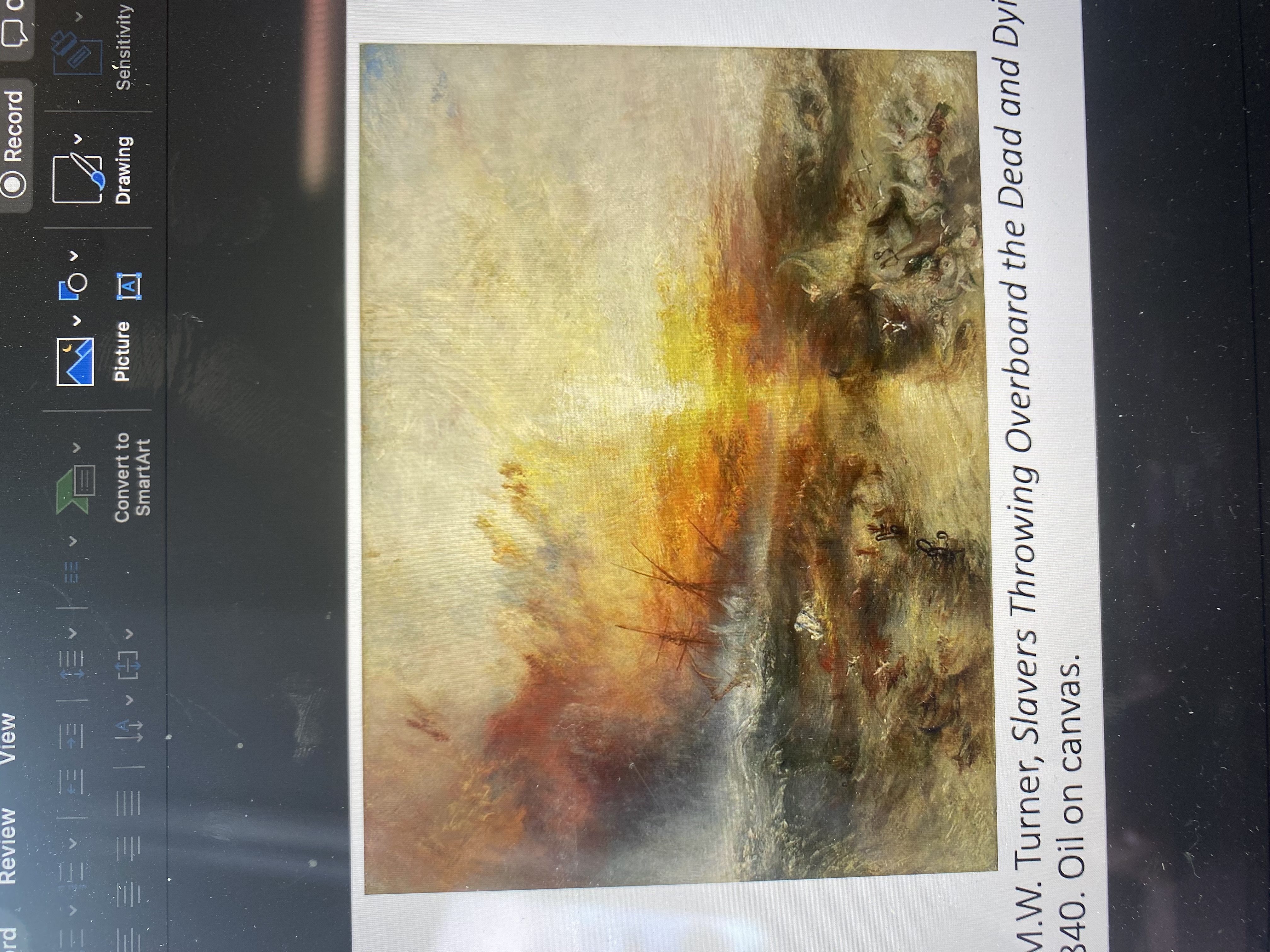
J.M.W. Turner, Slavers Throwing Overboard the Dead and Dying, 1840. Oil on canvas.
Ship, birds and fish eating foot that has chain on it, larger fish in back coming, reds are evoking blood, ocean is horrible pale white color, based on event, slave ship- (insurance) could collect insuance money for people on board if they went overboard, slave traders would throw sick and dying over board lying that they jumped so they could collect money, collect money on slaves, slaves considered goods, britin had outlawed slaves in colonies in 1833, example of additional corruption, Ruskin was first owner of painting, criwute of slavery as a whole
Sea is unforgiving, violent depiction, paralle with slave trade and sublme, horror of humanitys
sublime
strongest emotion we are capable of feeling, terror and pleasure
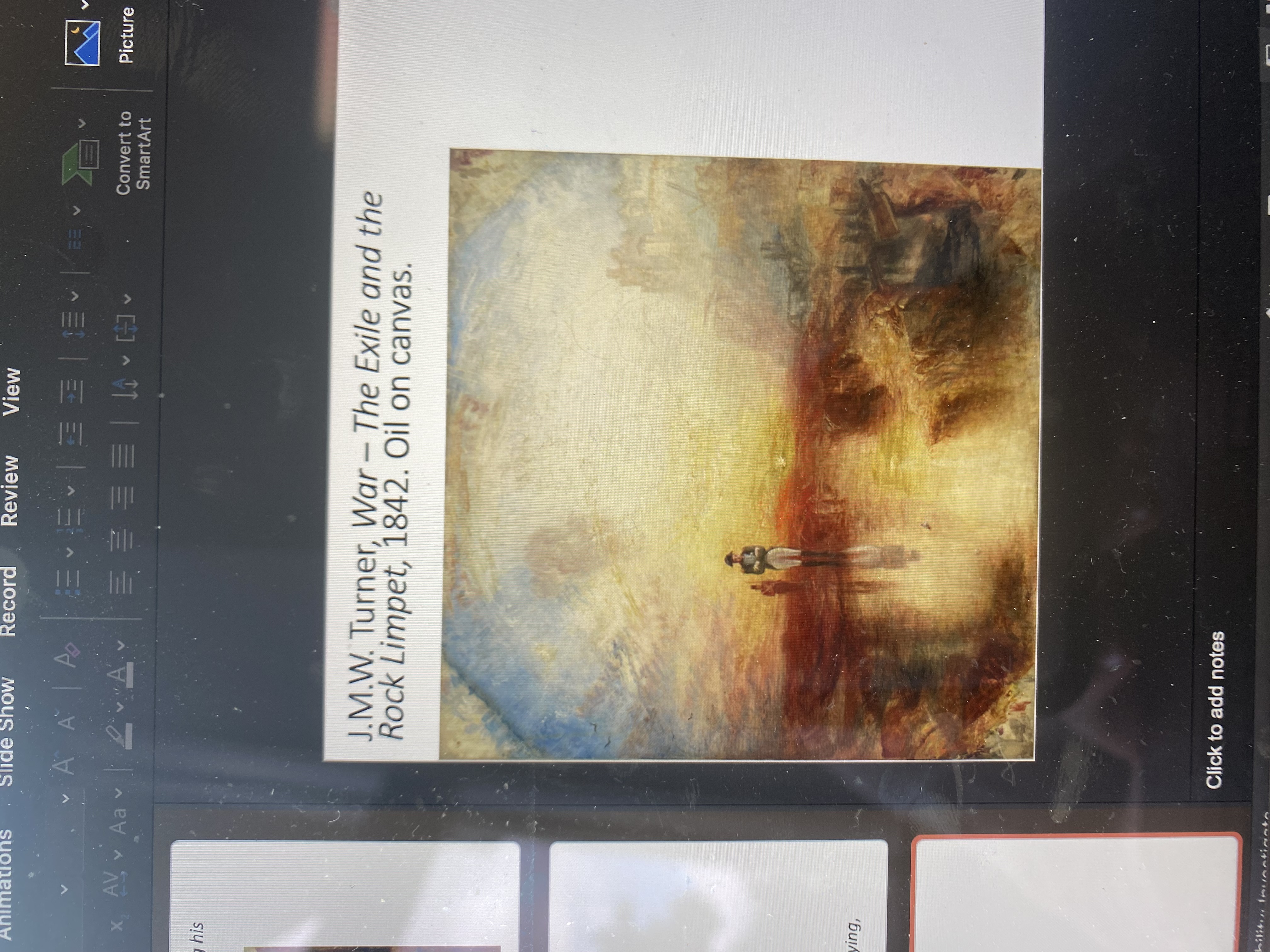
J.M.W. Turner, War – The Exile and the Rock Limpet,1842. Oil on canvas.
Images related to napolean, exhibited as pair as War and Peace, criticied for looking unfimished, Turner makes them look sketchy or unfinished because it captures sablime more, blending of water and sky, humans and nature, not clear on seperations, napolean is exiled twice, he died in second exile, ashes returned to France on right side, naoloan alone with guard, documentative not celebratory, landscape is more celebrated than napolean, shows pointlessness of it all, napoleandies alone, ends as ashes, sunset evokes blood red-sea of blood he himself created that led to his exile, both commemorative, outbreaks of emoition in dark balcks, on right year that one of Turner’s friend died too, turner became abstract, trying to create mood, exact locations and people don’t matter, something evoked no matter subjects

J.M.W. Turner, Rain, Steam and Speed – The Great Western Railway, 1844. Oil on canvas. Foreshortening
Technique of foreshortening, train looks like its fast and coming at us, behind train is foggy and blurry-looks fast references being there in realty, narrow in back and wide up front, distortion makes object look closer to viewer, turner interested in moder technology, new bridge, trail could go 60 mph, exciting for time, looking towards London, was a bunny in bottom right, industrialization over take bunny (nature metaphor)
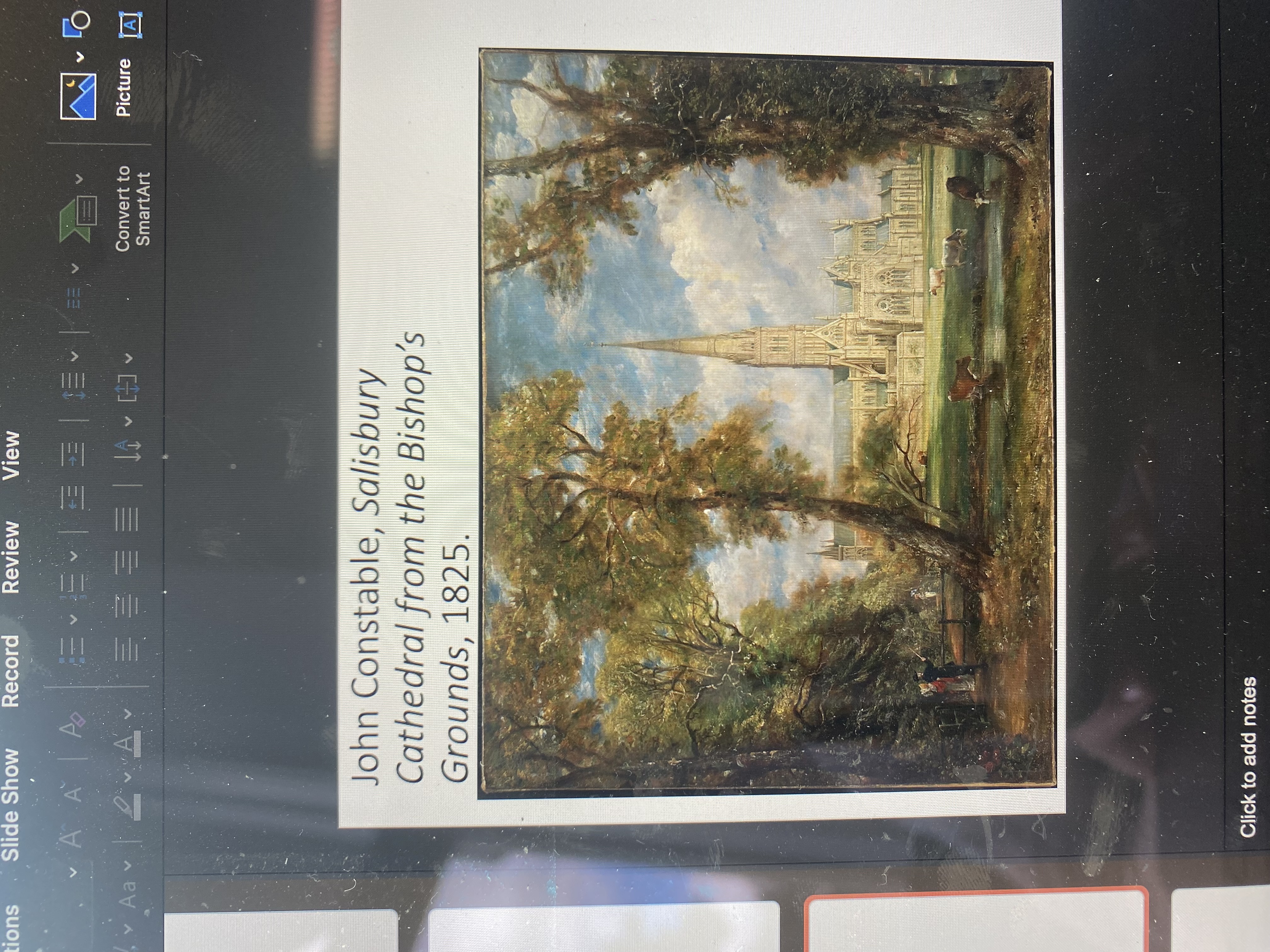
John Constable, Salisbury Cathedral from the Bishop’s Grounds, 1825.
Comparison with Constable, both show same building, topographical study, for bishop of salsbruy, both romantic painters, interested in typographic studies, emotional responses to nature, constable rarely left town, he is obsessed with his area, constabe shows more nature, constable uses trees to mimic the cathedral, cows used to show pastoral settings, particularity-emphasise a sense of place, he never left England, capitalize nostalgia, when cities get bigger-want to get out of city to relax, escape like vacation
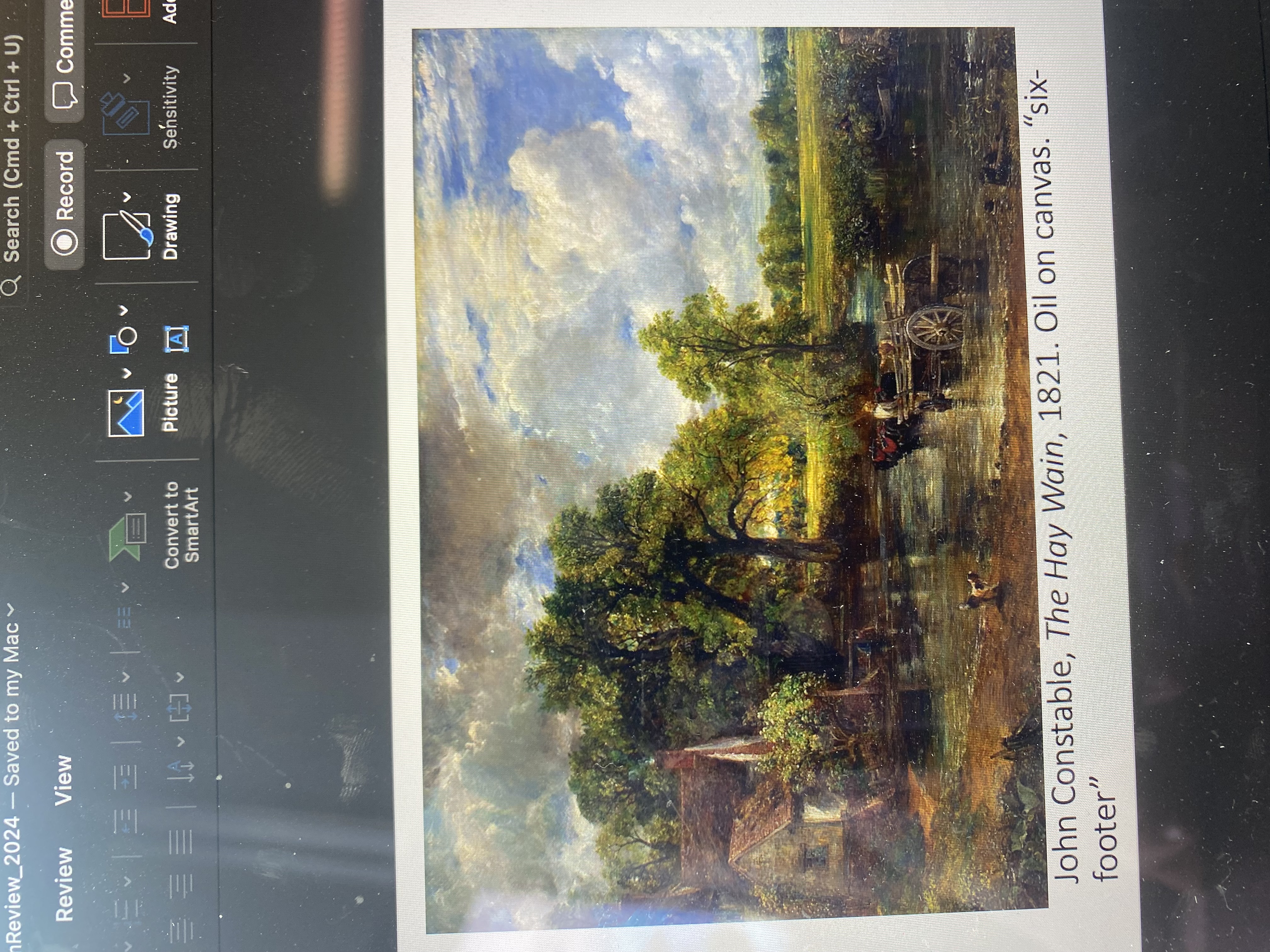
John Constable, The Hay Wain, 1821. Oil on canvas. “six-footer”
Challenge what a landscape can and will be, mirror of nature-so accurate, water too calm, sky to detailed, grass glowing
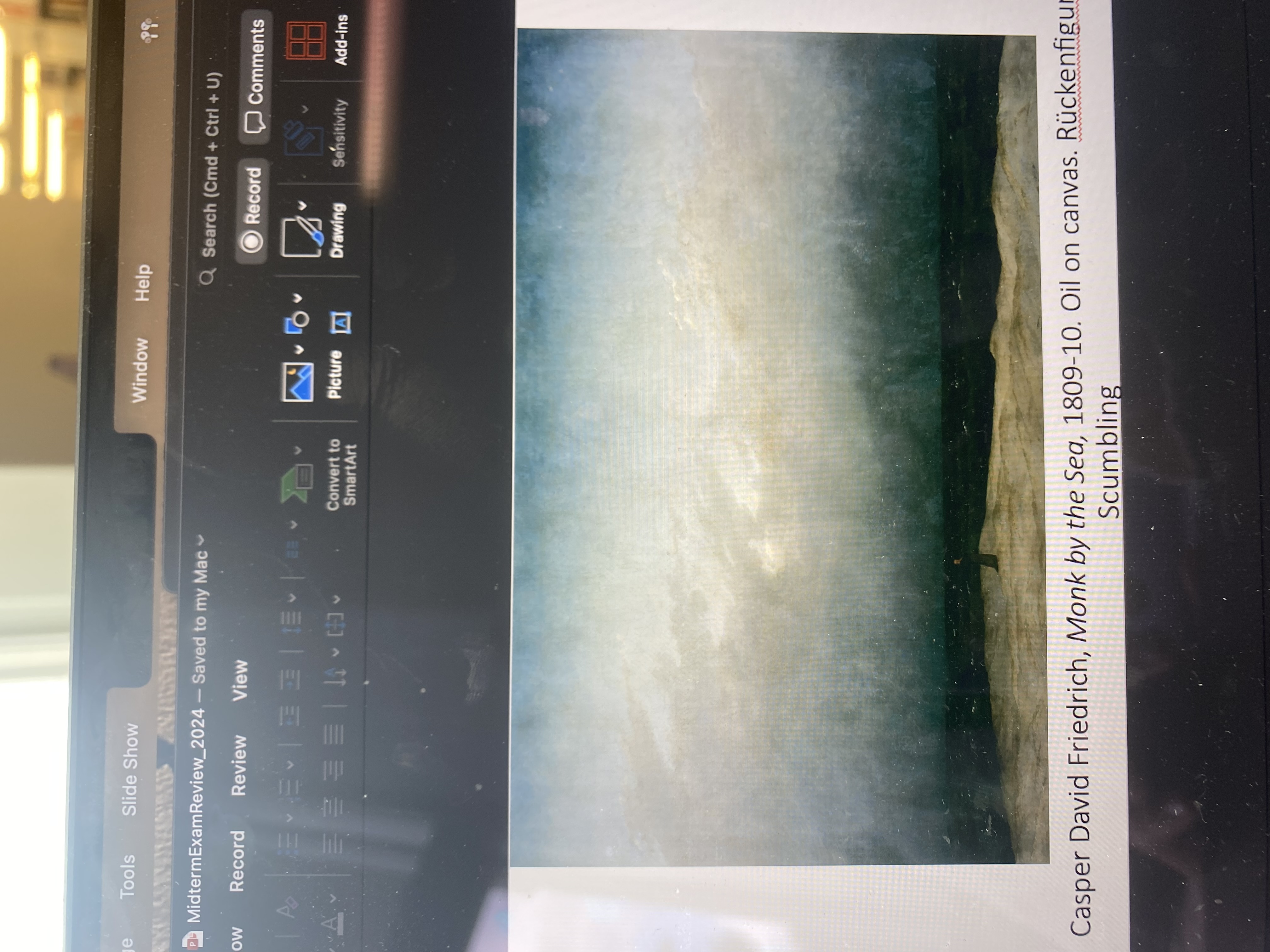
Casper David Friedrich, Monk by the Sea, 1809-10.Oil on canvas. Rückenfigur. Scumbling
Sense of singularity, need to cultivate self, can be around people all day but cannot talk to anyone, dark figure/man shown from back, determines the scale, adds story line, abstract landscape without the man in. it, sense of sublime, contemplate landscape, friedrich didn’t like nasareians, to ask simple when we have moved on as a society will convince/please no on, painting is so radically modern, maybe supposed to be Friedrich/poet/pastor who gave sermons on shore we are not shore, prompts us to look at something different, void of ocean, horizon line is super low, when one color is applied in thin layers to make hasy effect
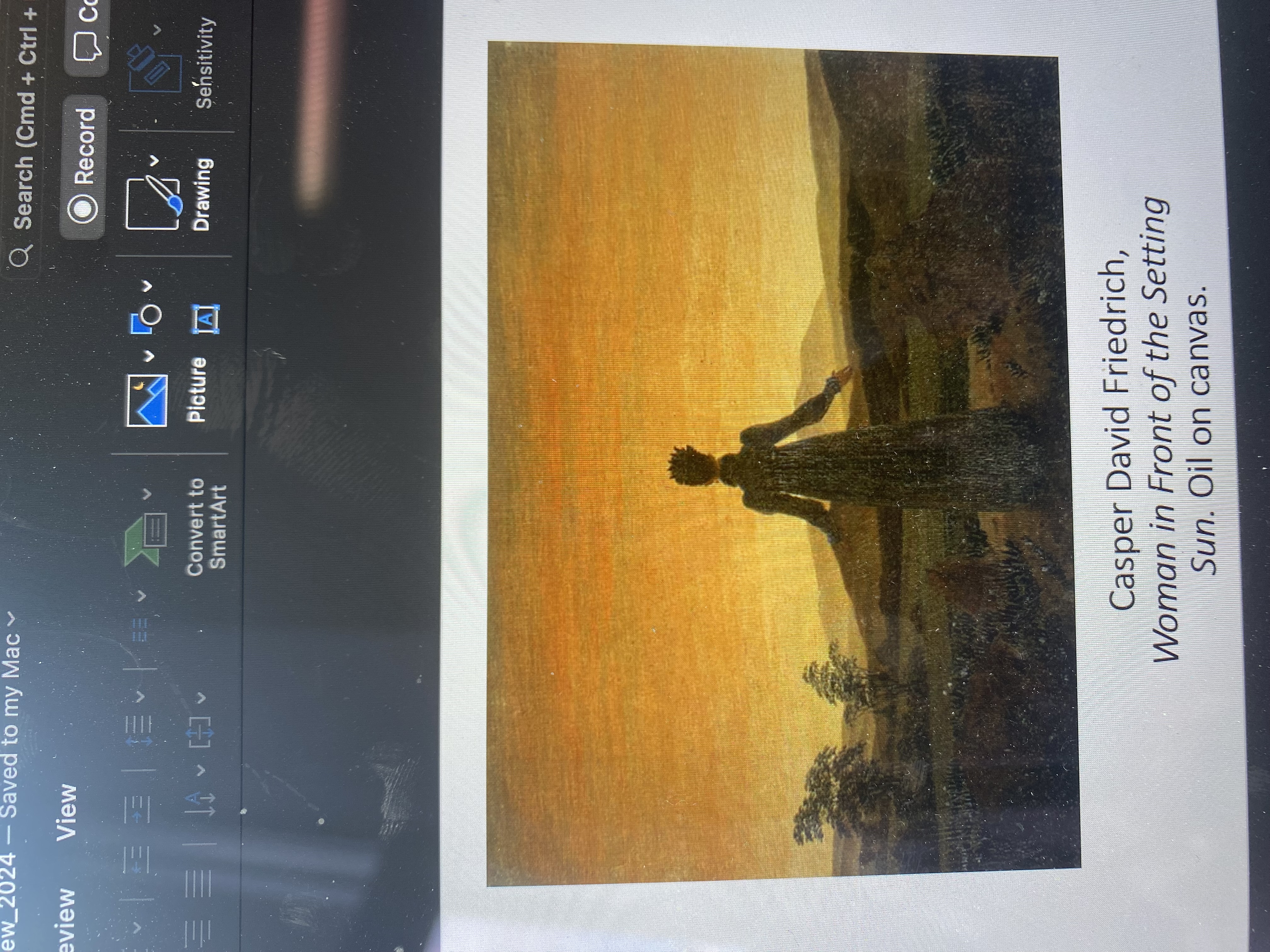
Casper David Friedrich, Woman in Front of the Setting Sun. Oil on canvas.
Model caroline bromer, hand gestures are analyzed as awe, embrace sun, prayer almost, large rocks in foreground, could be symbols of Xian faith, prehistoric rock tombs, reference to death
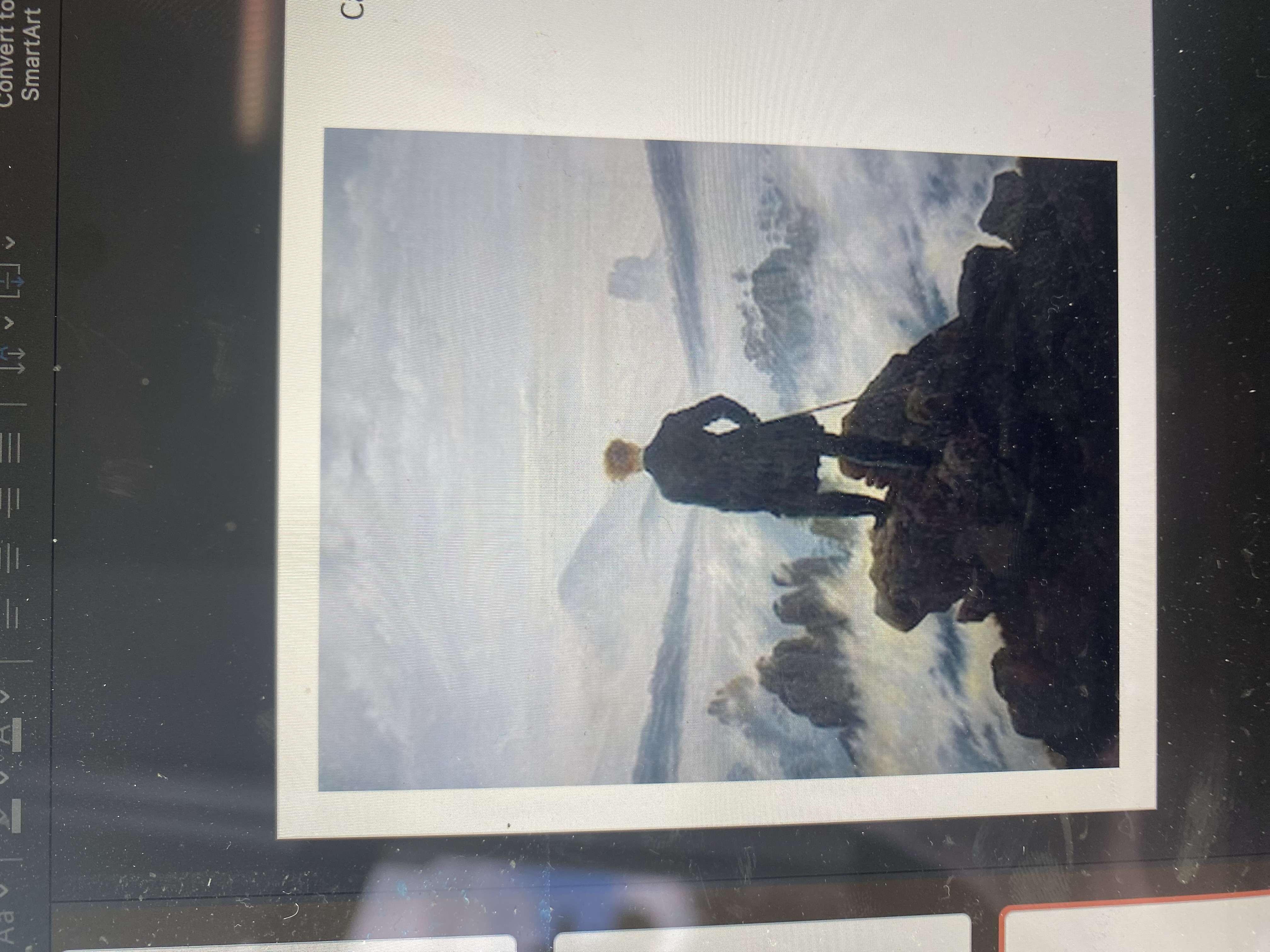
Casper David Friedrich, Wanderer Above the Sea of Fog, 1818 Oil on canvas
Sublime, vast nothingness, usally aren’t above the clouds, makes it to the top-human capability, becomes even more overwhelming, Friederick was hitlers favorite artist, lost popularity for some time because of it
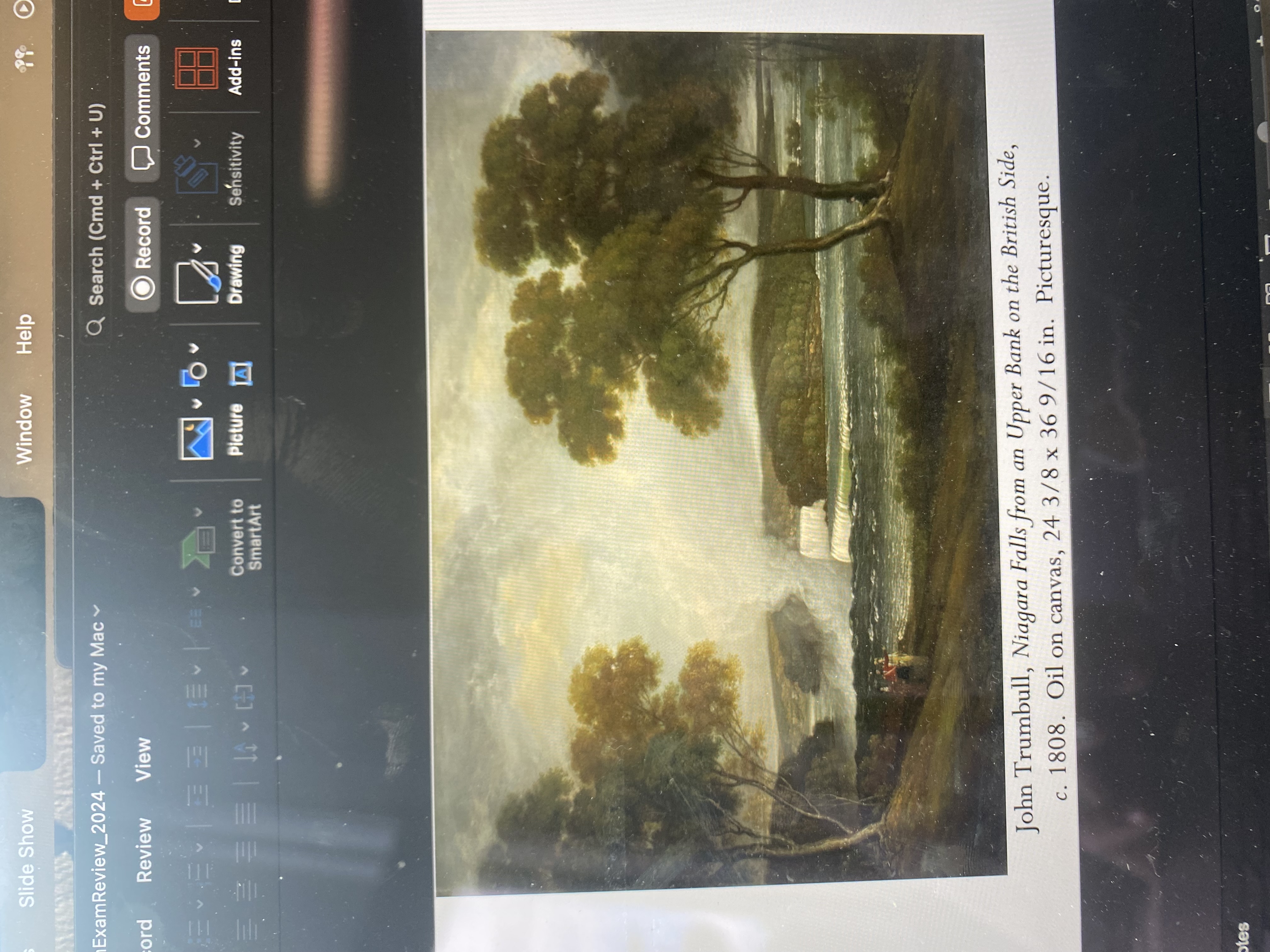
John Trumbull, Niagara Falls from an Upper Bank on the British Side, c. 1808. Oil on canvas, 24 3/8 x 36 9/16 in. Picturesque.
Niagra falls, •Depictions of the American landscape become a major source to interest to American painters in the early 1800s
•“Christianized naturalism” - Conflation of God and nature
•Landscape tourism
•Working with landscape traditions of the beautiful, the sublime, and the picturesque
•Hudson River School
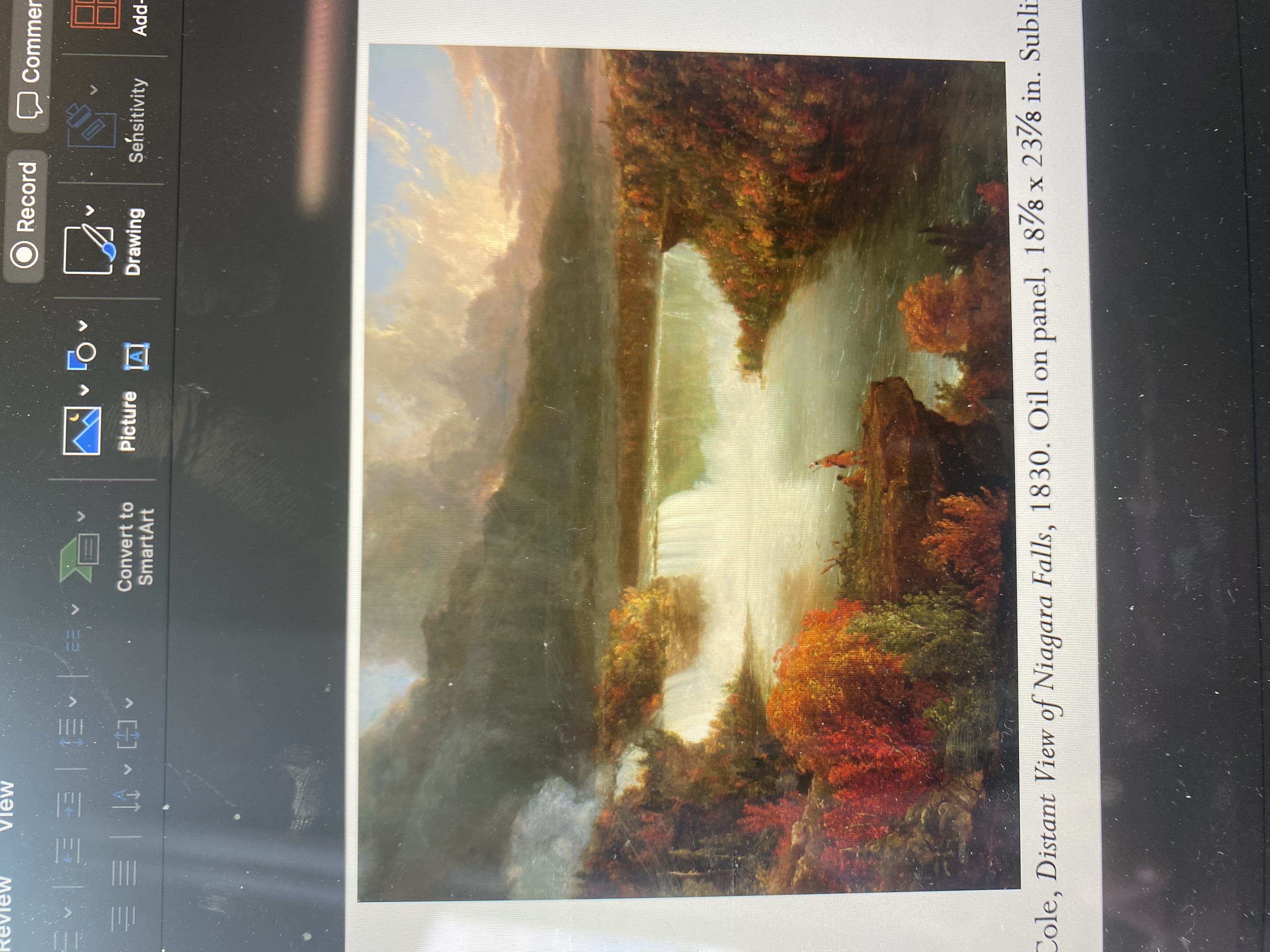
Thomas Cole, Distant View of Niagara Falls, 1830. Oil on panel, 18⅞ x 23⅞ in. Sublime.
In the fall, more expensive postcard, people wanted something to bring home with them, niagra falls, tacking sketching trips and make composition, tru new York state and Canada, “wildness” is the native americans, two native americans, the vanishing race-belive they were all dying out, factories and hotels at falls, revomed all of it for painting, environmental aspect of industrialism he is concerned about
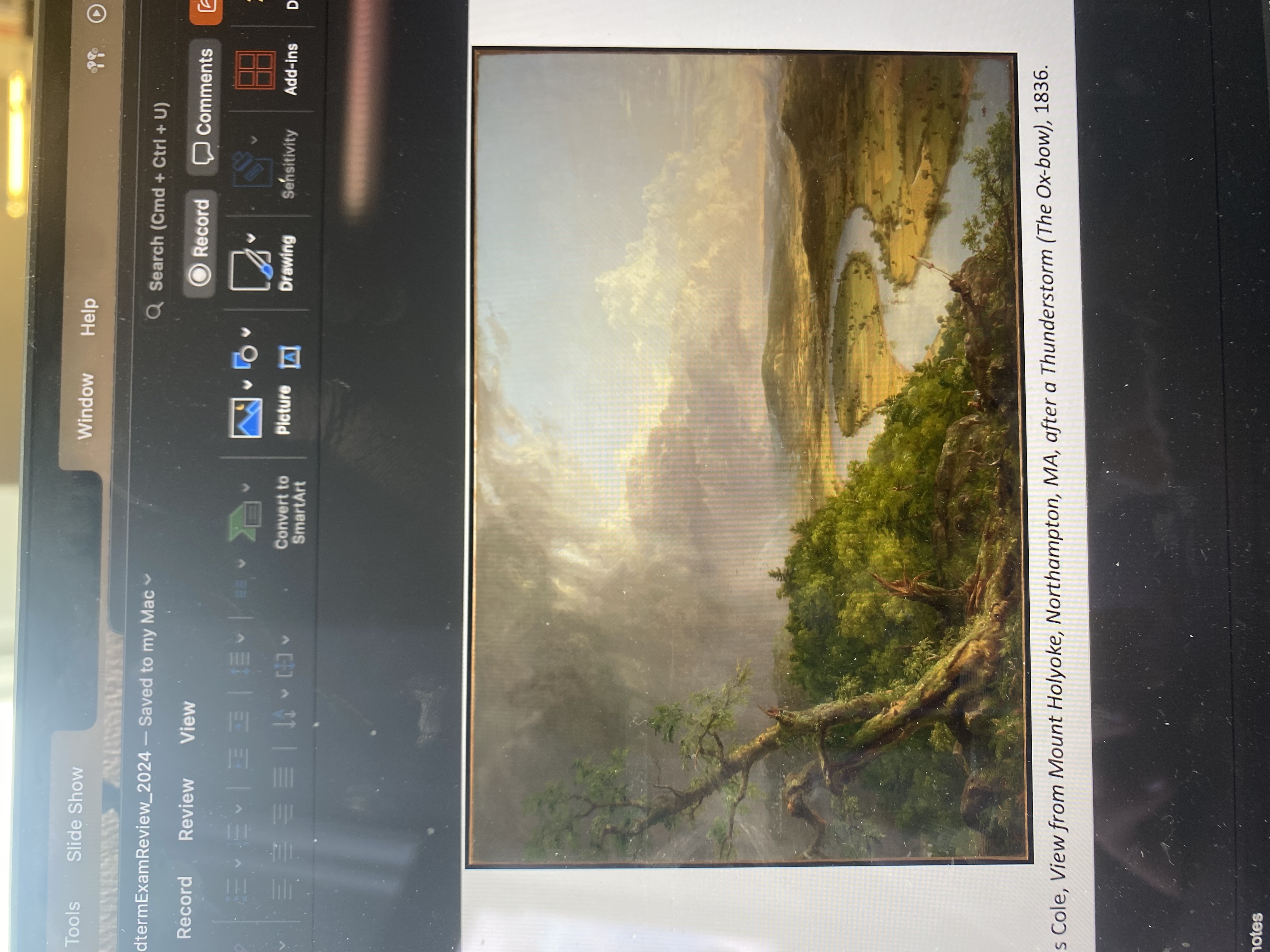
Thomas Cole, View from Mount Holyoke, Northampton, MA, after a Thunderstorm (The Ox-bow), 1836.
Depict what was really there, hes not intense, wants to get genral part right,
White umbrella, a person coming up the hill with easle to paint, see the land is organized like farm land, boat in water, smoke coming up from house, left side is wild and untaimed, right isde is near bright and organized, humans try to taimnature, to get people to think bigger about hwaat America can be, very American

Asher B. Durand, Progress (The Advance of Civilization), 1853, Oil on canvas. 58 ½ x 82 ¼"
Commisioned by railroad executive, propaganda, railroad was in negative light, railroad brought gambling and prostitution, need to bring positive view of rail road,
Left, three Indians, everything is dead, broken trees, the end for them, they are looking towards progress, domesticated animals do farm work for them, steam coming off a port, telegraph wires, communication, old reality and new reality, idea of varishing Indian, all native anericans are going to vanish—desinty,
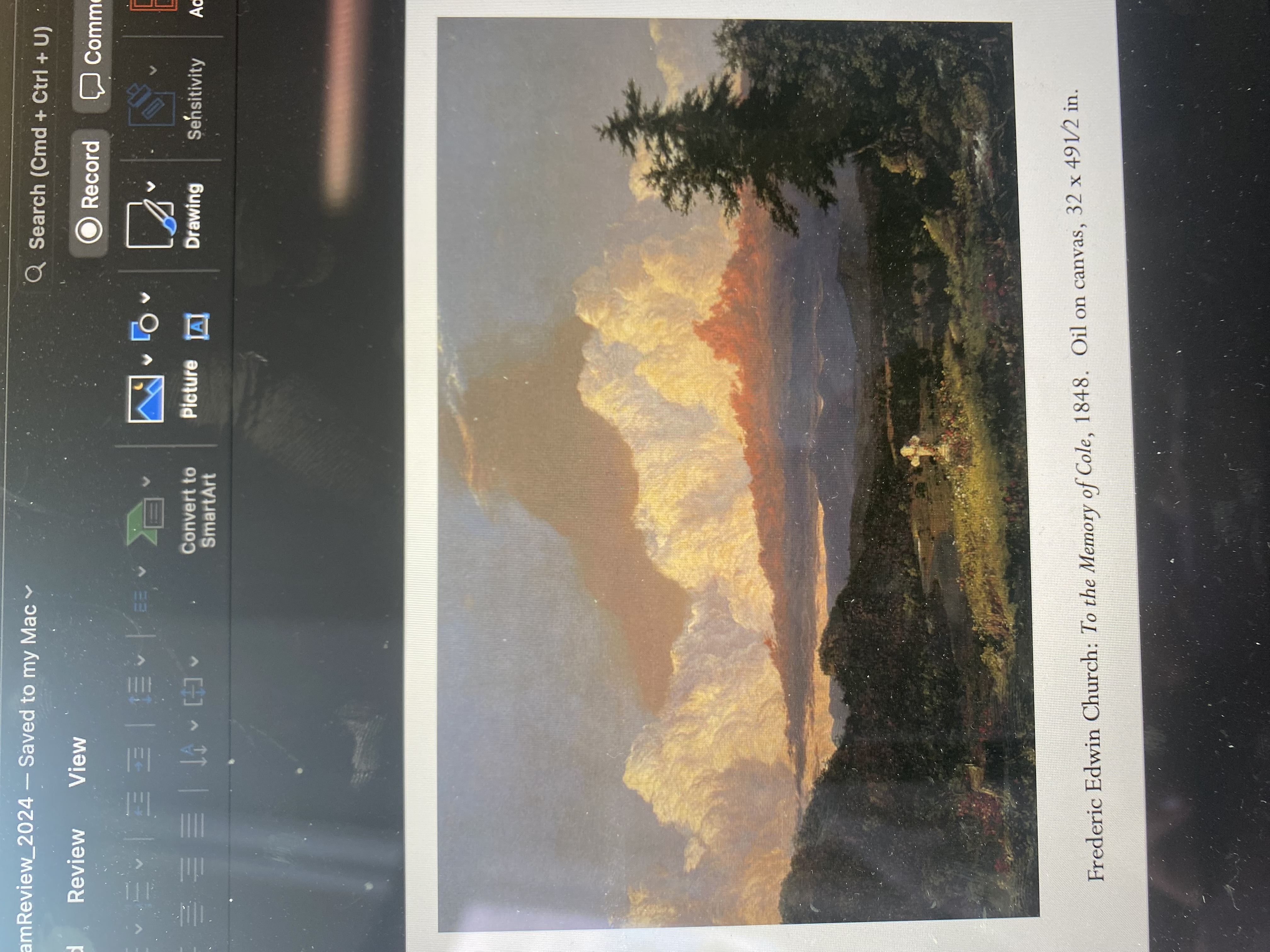
Frederic Edwin Church: To the Memory of Cole, 1848. Oil on canvas, 32 x 491⁄2 in.
Painting made in memory of Cole, tribute, cross, Chruch was Coles’ first and only student, Coles’ favorite site, beautiful clouds, tradition of picturesque, nothing terrifying, wildness with idealized landscape
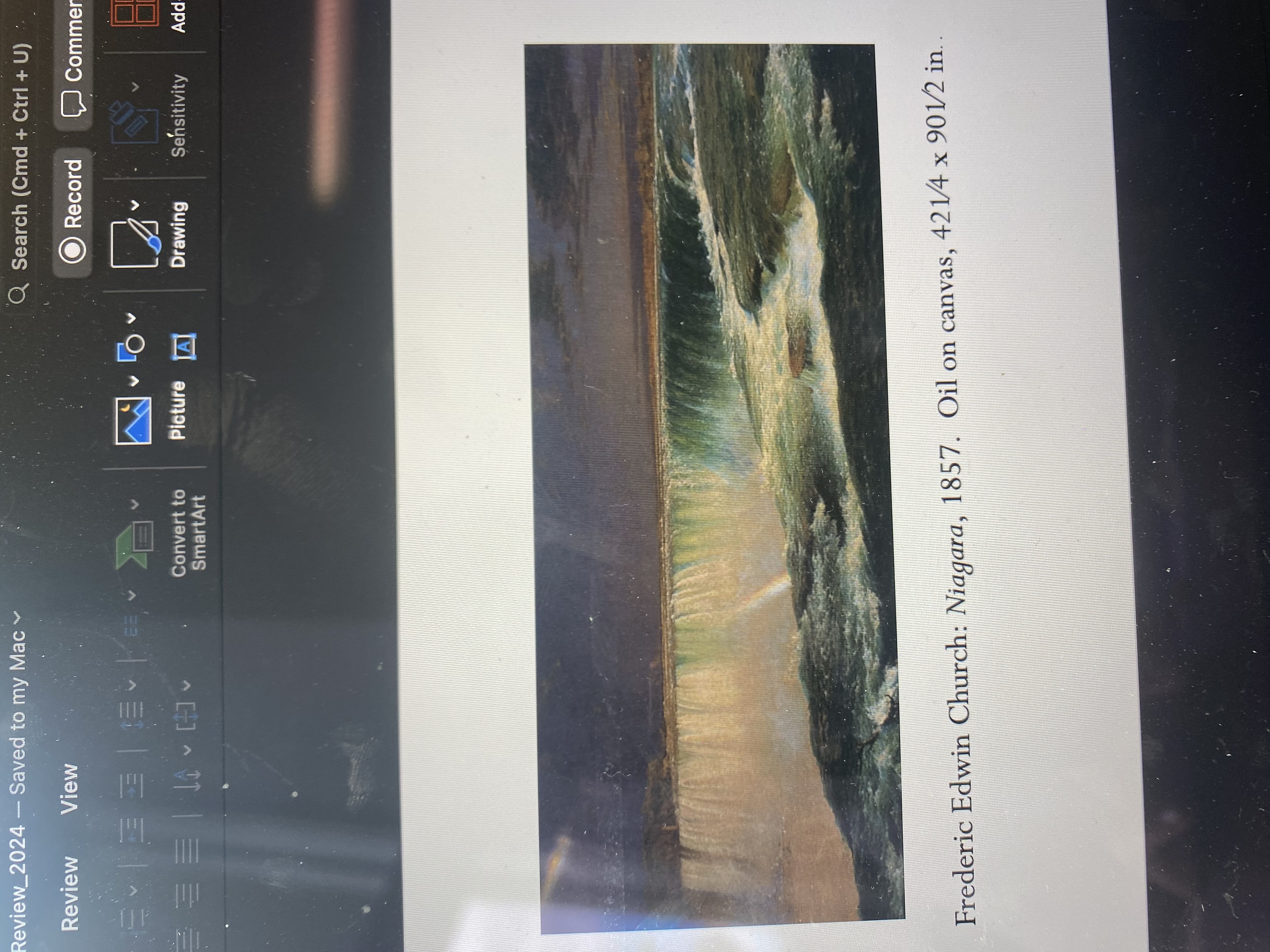
Frederic Edwin Church: Niagara, 1857. Oil on canvas, 421⁄4 x 901⁄2 in. .
Terrifyingly loud, any moment can slip and fall, panaorama landscape, toured in US and britian, people willing to pay to see landscapes that glorify united states
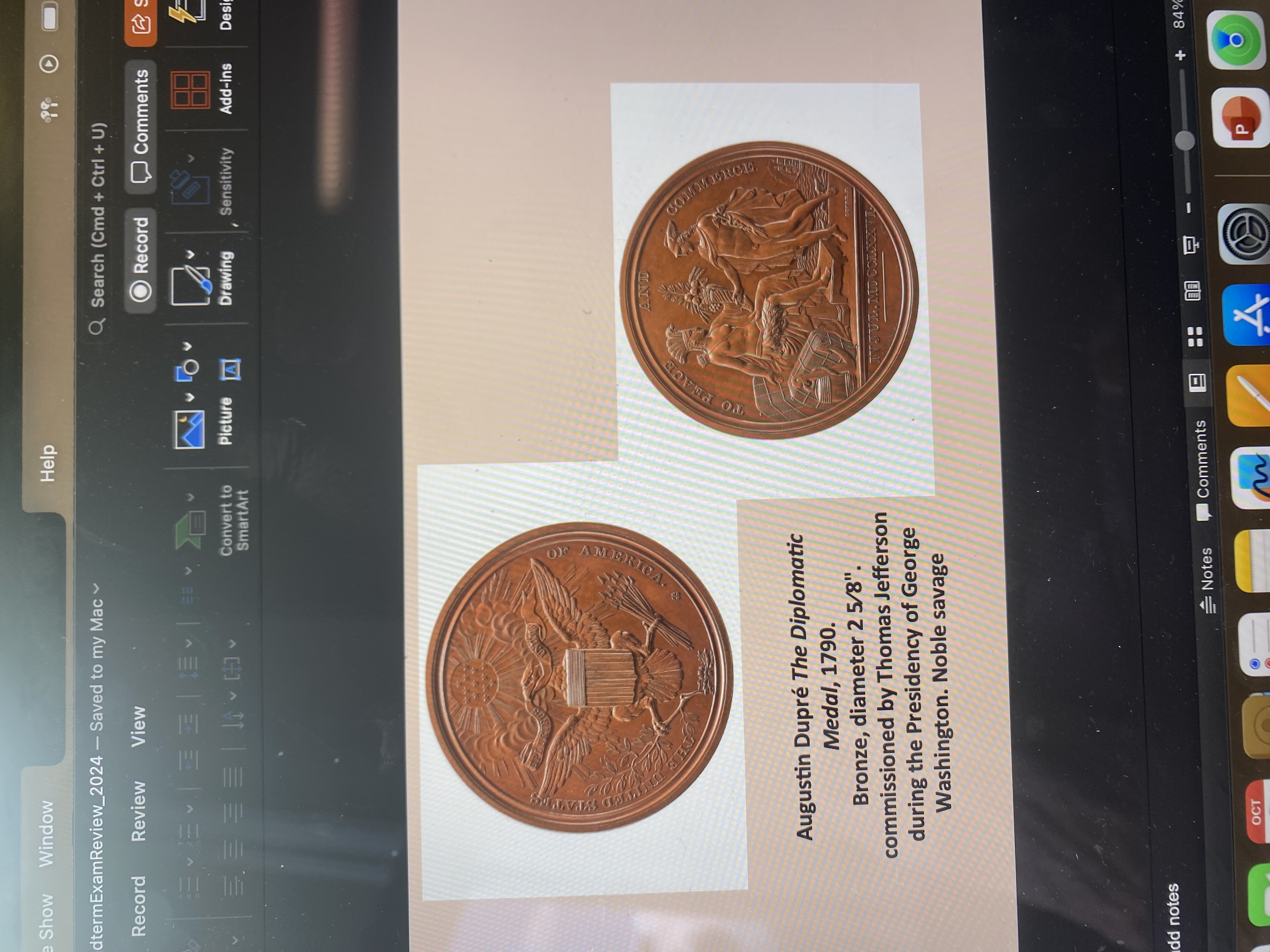
Augustin Dupré The Diplomatic Medal, 1790.
Bronze, diameter 2 5⁄8". commissioned by Thomas Jefferson during the Presidency of George Washington. Noble savage
NA forced to move form their lands, people are dying under manifest desinty, whites are destined and should take over land that is theirs, symbol of NA to distinguish themselves form other ERU countryies, what is different about US- NA, show up in American life, bronze metal, the noble savage, uncivilized, to justify taking their land, seated queen on left, receives cornucopia from Mercury, symbols of commerseand trade, boat, ocean, large packages, “to peace and commerse”, queen depicted in profile Like roman coins), almost on same level as Greco roman gods, Mercury is not seated so he looks “higher” than the queen, savage part-she doesn’t have shirt on, uncivilized, nonXian, wear skirt made of natural materials, eur artisits visualize world thru aligorical figures,
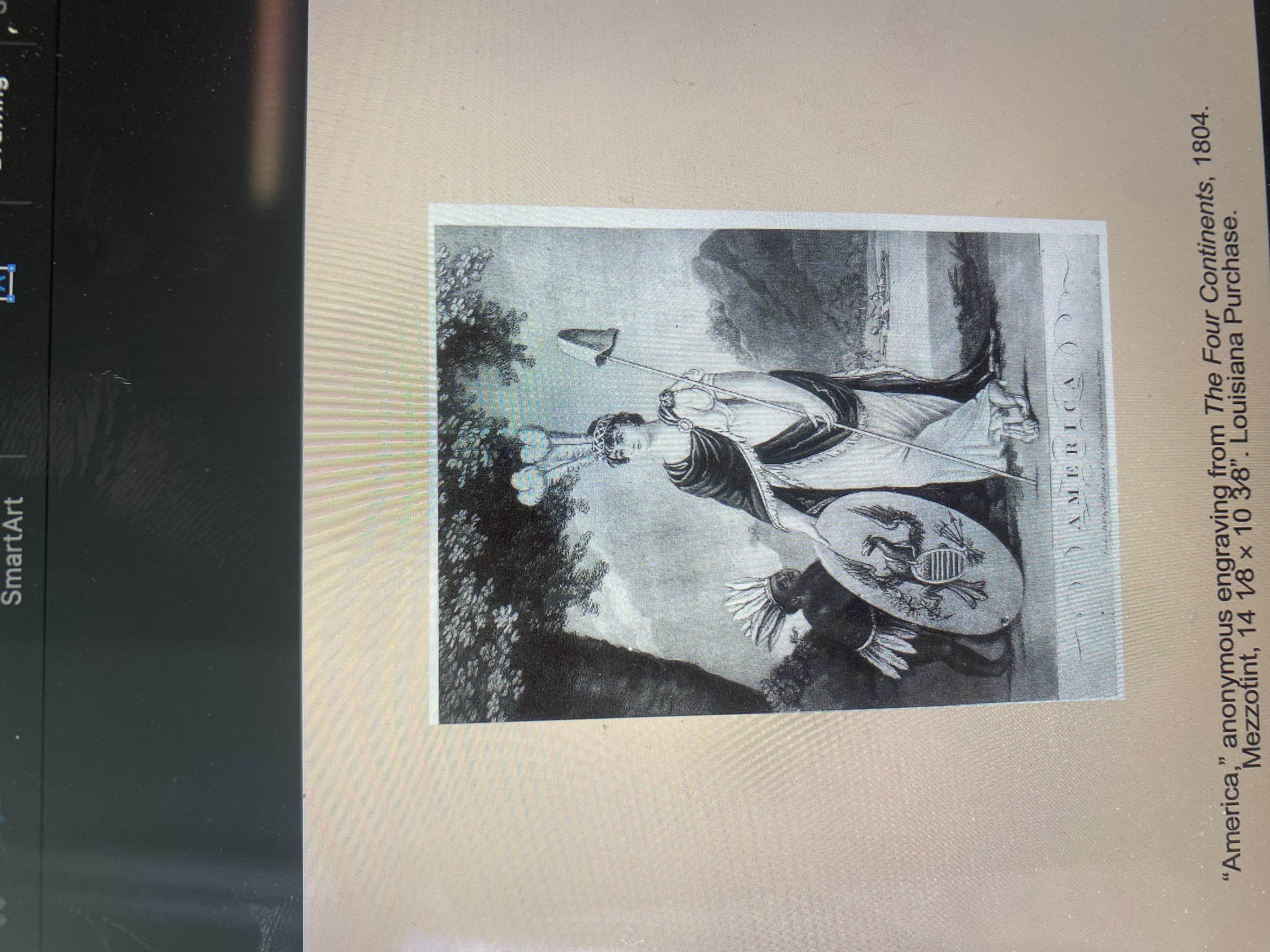
“America,” anonymous engraving from The Four Continents, 1804.
Mezzotint, 14 1⁄8 × 10 3⁄8”. Louisiana Purchase.
America is clothed, feathered headdress, trade and commerce happening in background, Americas look younger, darker skinned depicted to need to be civilized,ouisiana purchase doubled the size of US, France sold, good deal for US, territory 50,000-100,000 people lived there, free/enslaved blocks, NA< French residence
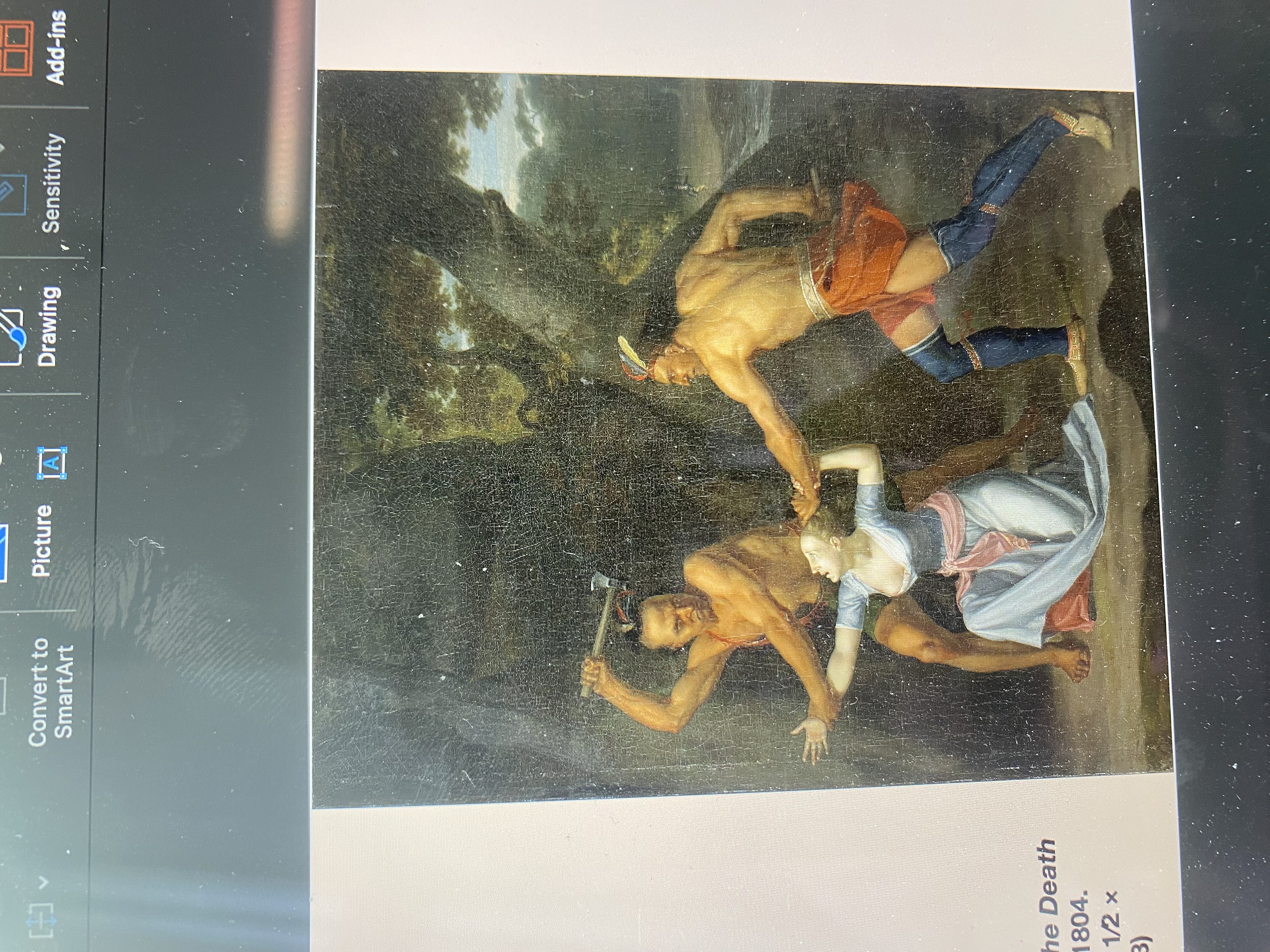
John Vanderlyn The Death of Jane McCrea, 1804.
Oil on canvas, 32 1⁄2 × 261⁄2" (82.5 × 67.3)
The death of jae mccree, by president Jefferson, mohawk men kill british women, british hire mohwadks to defeat the American colonists, Jame mccree was engaged to someone in biritsh army, she was thought to be killed by NA in 1777, true story, back of paiting on right, tiny figure, her man is too late, killers were never found, resulted in decrease of confidence of british to protect own army, most of the captives of british on American frontier usually were indiengous peoplenot French, NA violent, now murdering young women, totally helpless, look strong and powerful, scalping about to happen, associated with intense violence, landspcaes have looked notthreatening portaying NA,
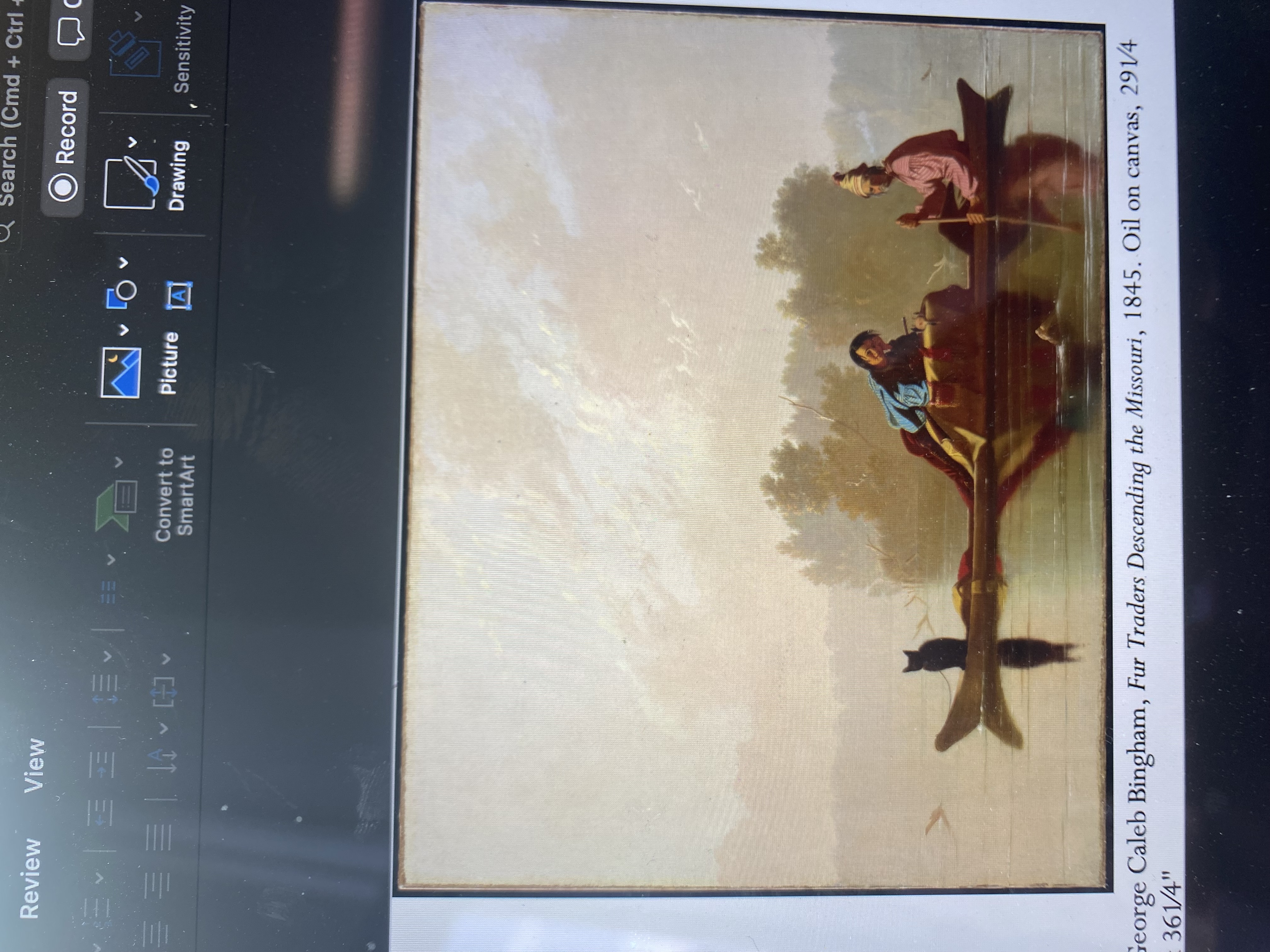
George Caleb Bingham, Fur Traders Descending the Missouri, 1845. Oil on canvas, 291⁄4 x 361⁄4"
People travel on missisppi/Missouri river, fur traders, began career as portraitist, most popular thru colonial America, known for series of genra scenes, specific type or scene of everyday life, genra scene on the river (everyday life, not necessarily important events or people), original title “friend trader and half breed son”, marry indigous women to espablish relationships to trade furs, trade and expansion is resulting in successful commerse and not violence, inter marriag, title changed to make it more palatable to every day americans, idea of half breed son has darker hair and skin, painter is known to make paitnings very tranquil and glowy, 1840s is nostalgic, fur tradeis now industrialized
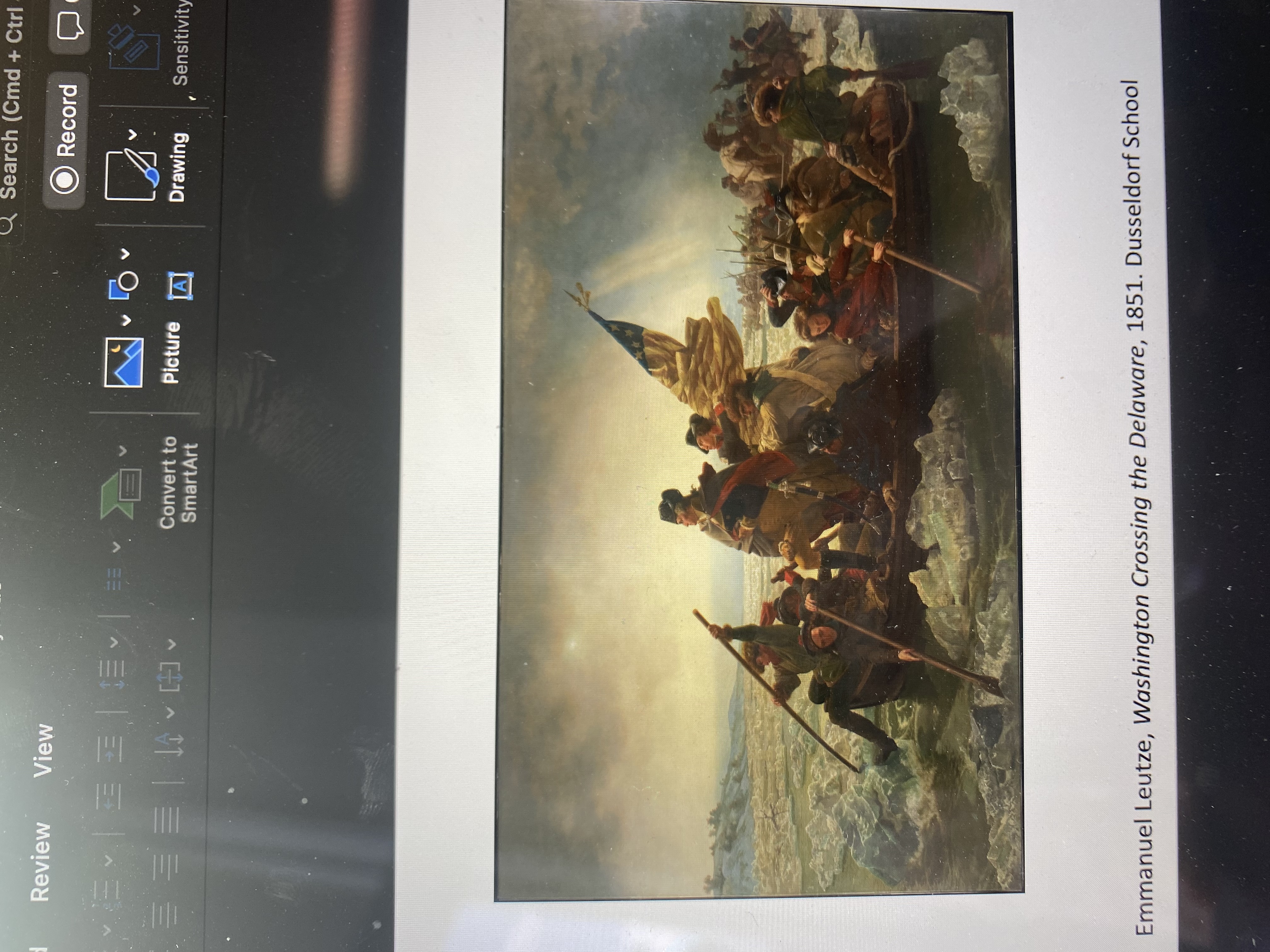
Emmanuel Leutze, Washington Crossing the Delaware, 1851. Dusseldorf School
Washington did not cross Delaware in 1851, done later, dusseldorf school-leading center of germna art and education, german artists work in style, dusseldorf school style I is large and in charge, dramatic, painted while he was in Germany, enourmouse size, 16-20 ft, theatrical, cluttered, overly sentimental, winter, all had to join together to make revolution happen, horses on boats in background, little scared, preview of what will be strong men on hourses, fur trader on right, wearing a native American shoulder patch, Washington is tallest, wearing horman clothing, similar to Washington ehind, common looking men, long train of boats, Washington is in profile, warmer colors mark things that are man made, boat/flag/clothing, cool colors mark weather and setting, everything is subordinate to Washington, triangles lead to him, evern flag is angled away, attack on dec 25 1776, surpise attack, amer lost several battles to british, gave americans hope, made 75 years after bettle
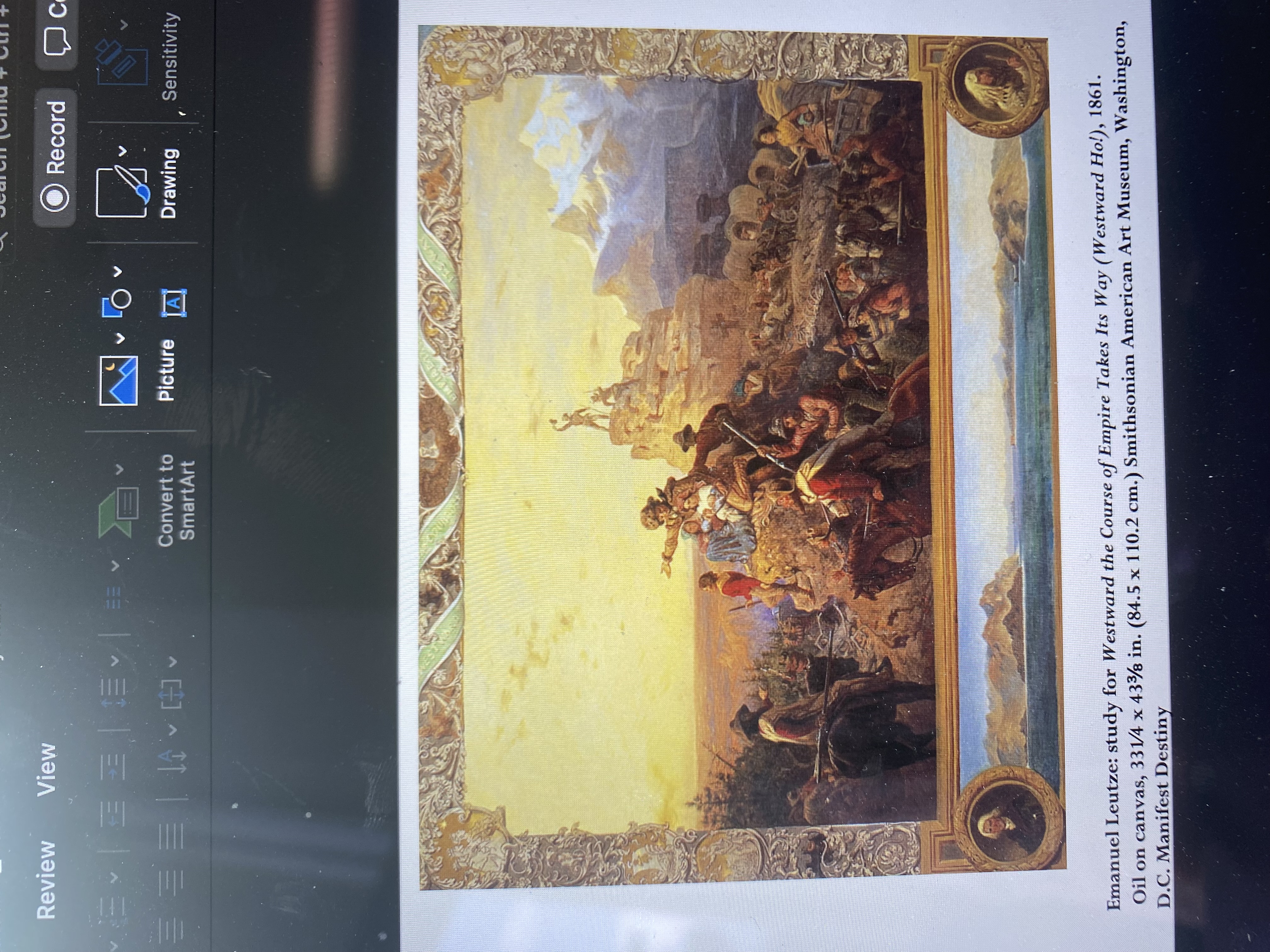
Emanuel Leutze: study for Westward the Course of Empire Takes Its Way (Westward Ho!), 1861.
Oil on canvas, 331⁄4 x 43⅜ in. (84.5 x 110.2 cm.) Smithsonian American Art Museum, Washington, D.C. Manifest Destiny
two copies, empire takes it way, one in DC and one in capital building, supposed to show American relife that us had American beauty, promise for better future, mission to settle and civilize rest of country, story telling, procession, dramatic, snowcapped moutains, plains, idealised image, pointing out, three person family group, fur hat evokes settlers, life on a prarie, many types of people, family is supposed to look like holy family, idealized many, meant to do this, clear their way to which no one has every been, left is golden and warm, right Is dark and difficult, skelton on right, worked hard to get there, supposed to be horse skelton, broken wagon wheels, two medalisn at bottle Daniel boom, west coast is ultimate destination, sanfrancisco bay was ultimae goal
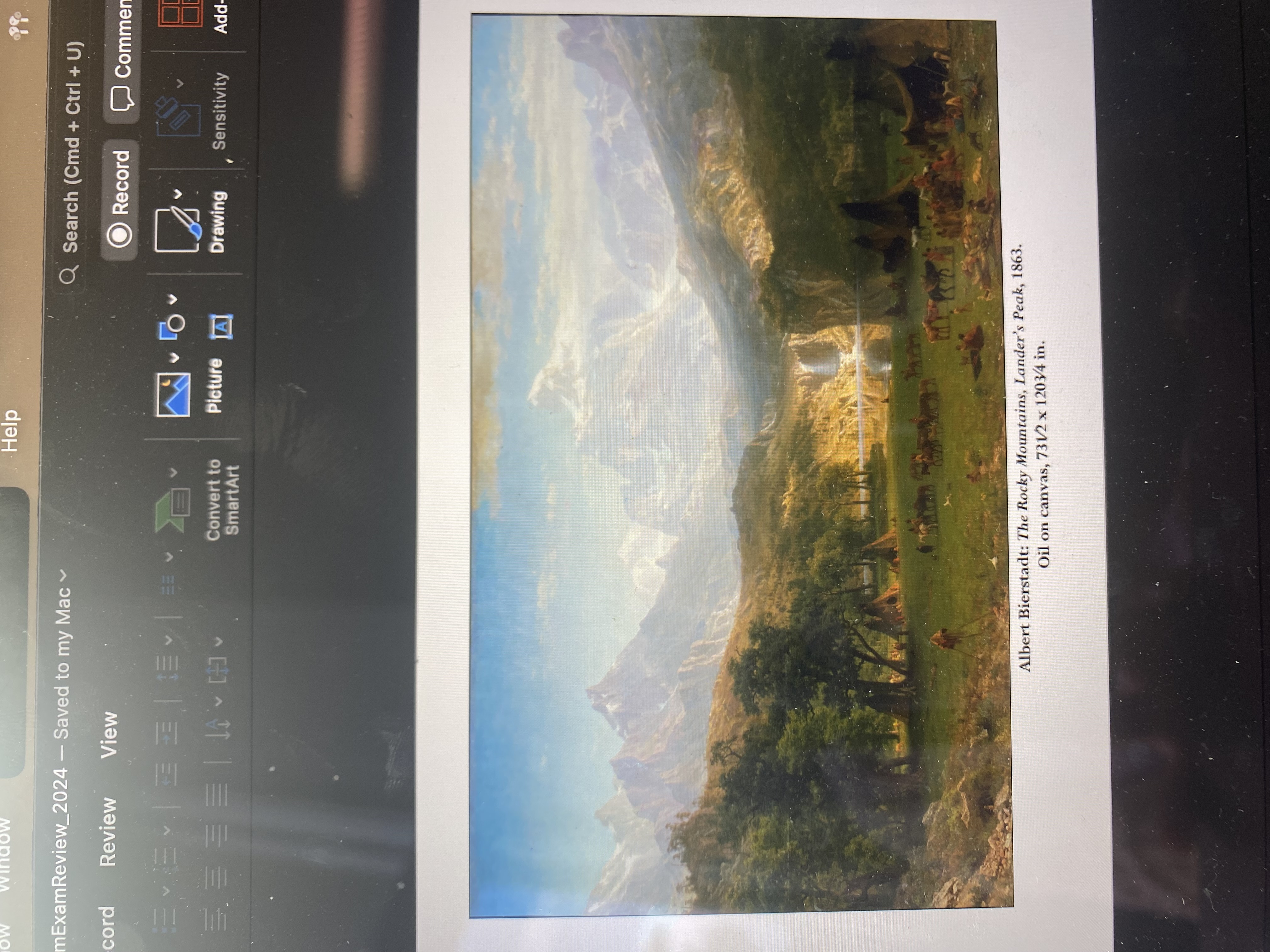
Albert Bierstadt: The Rocky Mountains, Lander’s Peak, 1863.
Oil on canvas, 731⁄2 x 1203⁄4 in.
Luminous, shape American vision for west, he would put his work in a dark room and charge people for it, 1859 accompnayed government exposition to nekraska terrifory, he actually went to this place, he painted in NY, pioneer going west gives us image peaceful calm, vibrant colors, abundant in animals and water, garden of eden look, America as “new Jerusalem”, there are native americans, so tiny they do not seem threatening, easily conquerable, not permenant sructures, looks more like alps, not all exisited together in one place, is action happening, people are passive, no actively engaed, this will go away (vanishing race), bison had been decimated, made it for 25,000 dollars, artisist eventailly bought it back when he could afford it and give it to his brother
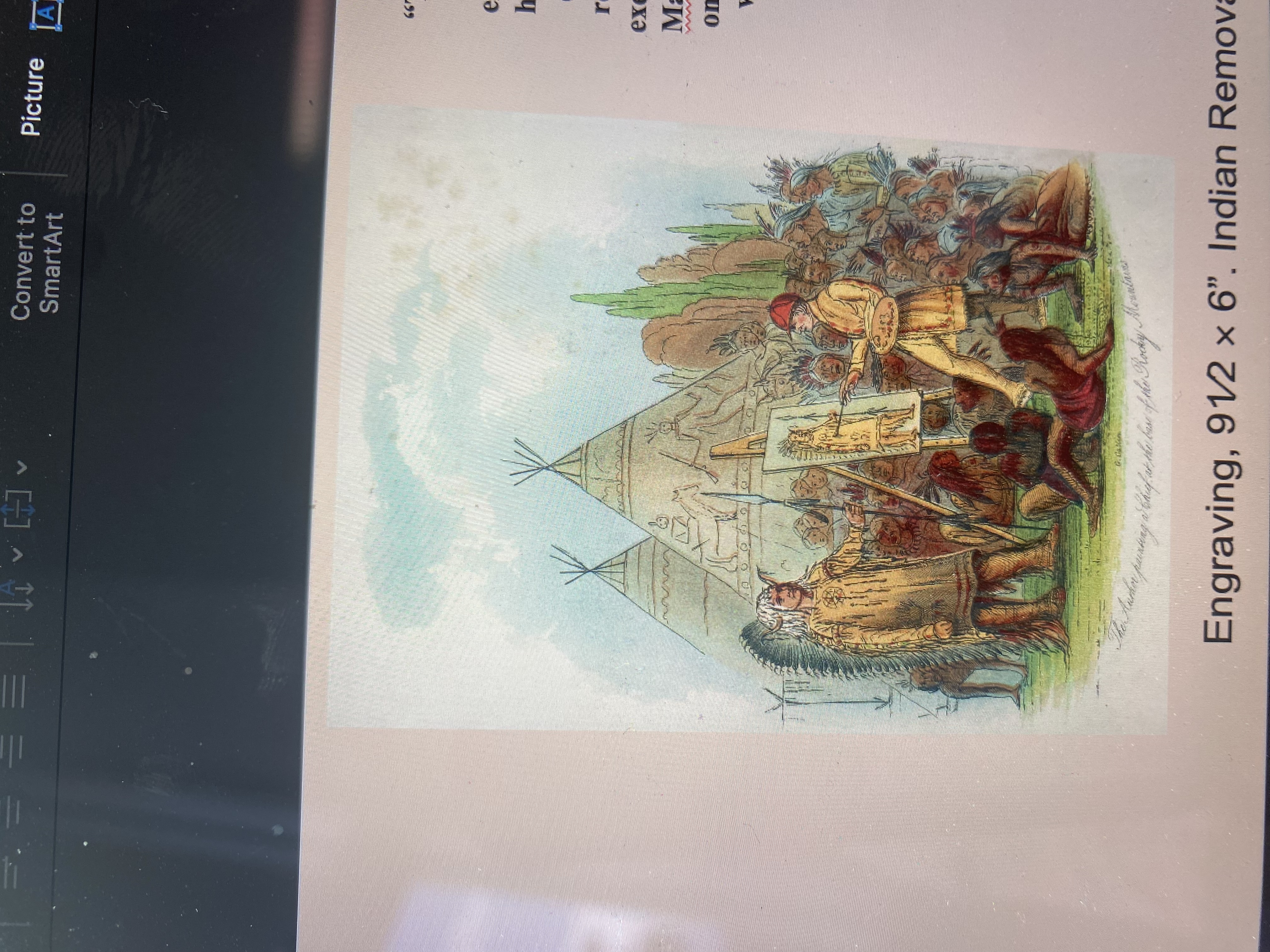
Catlin: Catlin Painting the Portrait of Mah-To-Toh-Pa—Mandan, 1857–69.
show that the Indians were peaceful, not totally accurate because they didn’t like in Tps, includes himself in painting to make himself look more special and peaceful, painting a portrait of the leader at the same time
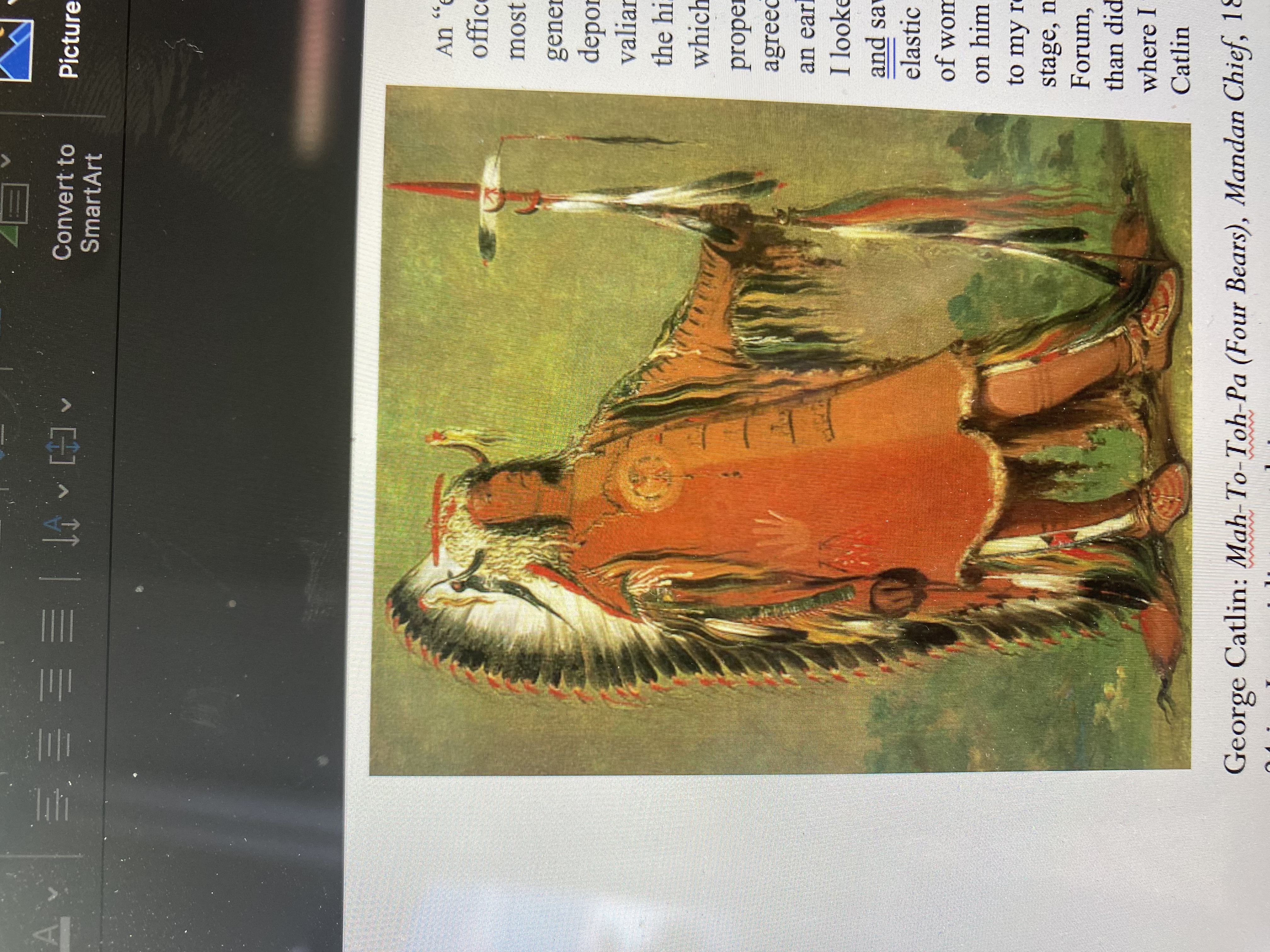
George Catlin: Mah-To-Toh-Pa (Four Bears), Mandan Chief, 1832–34. Oil on canvas, 29 x 24 in. Imperialist nostalgia
impralist nostalgia, same chief with horns, long quote abouthow extordianry chief was, handsome brave valliant, battles hes won is represent in clothes, imperlialistsnostalgia, evoke anxient rome, with great leaders of history, defined imperialist nostalgia as longing for ”other” culture when colonizer killed it, longing for something you destroyed, for economic or religious gain, nostlaiga is innocent, nostalgia makes us inoocent
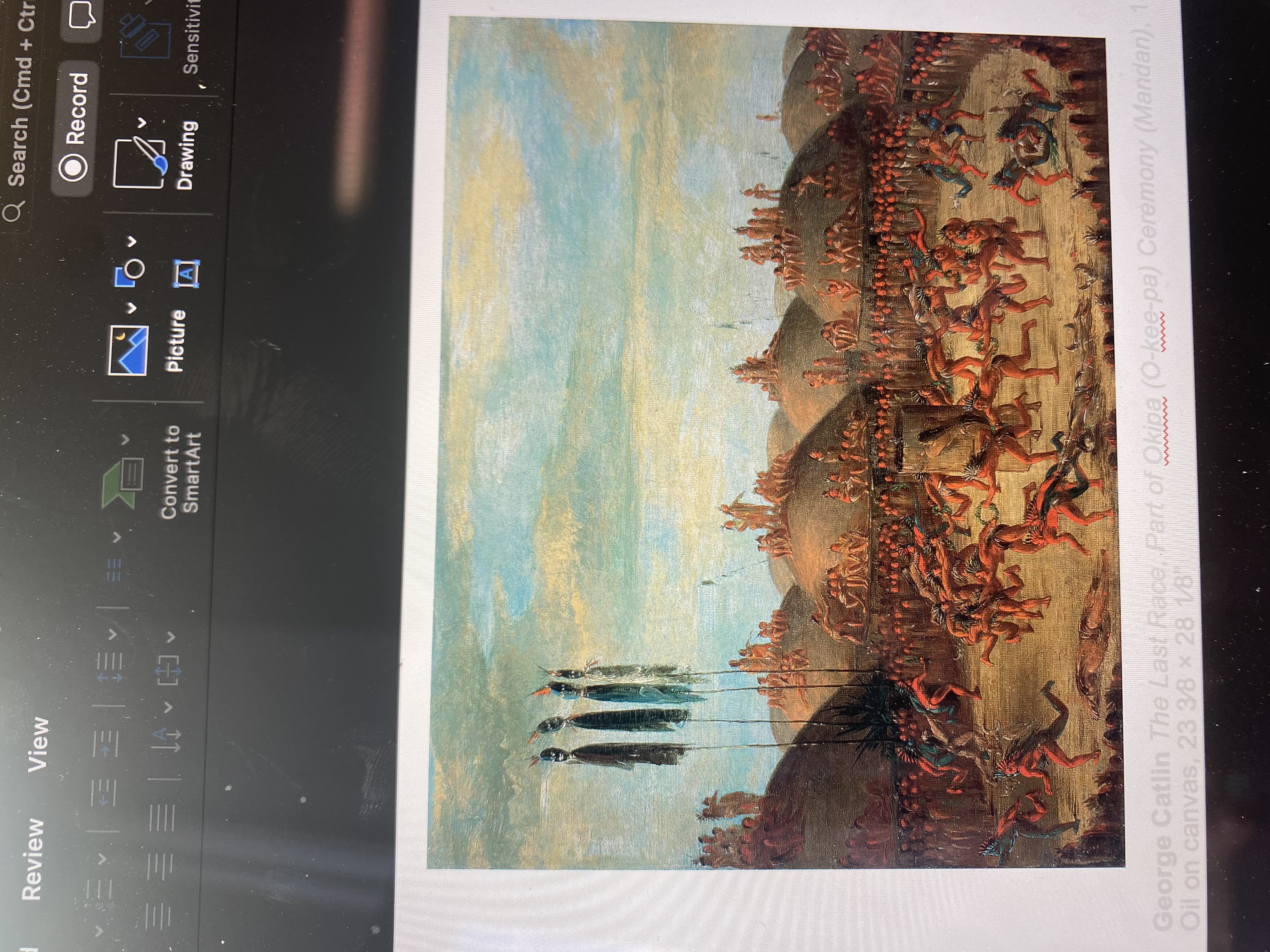
George Catlin The Last Race, Part of Okipa (O-kee-pa) Ceremony (Mandan), 1832.
Oil on canvas, 23 3⁄8 × 28 1⁄8”
Depict ceremony, 4 day ritual, men got innitalted, strong and smart men, unusual for someone like Catlin, that he was able to see it, men go to medicine lodge and didn’t get any food, suspended from roof by cord on chest, do bold dance for bison and fertility, painting marks end of ceremony, dance, men are released of medicine lodge, pale form absenence, run around big canoe, tribe washed out by small pox, document something that might disappear
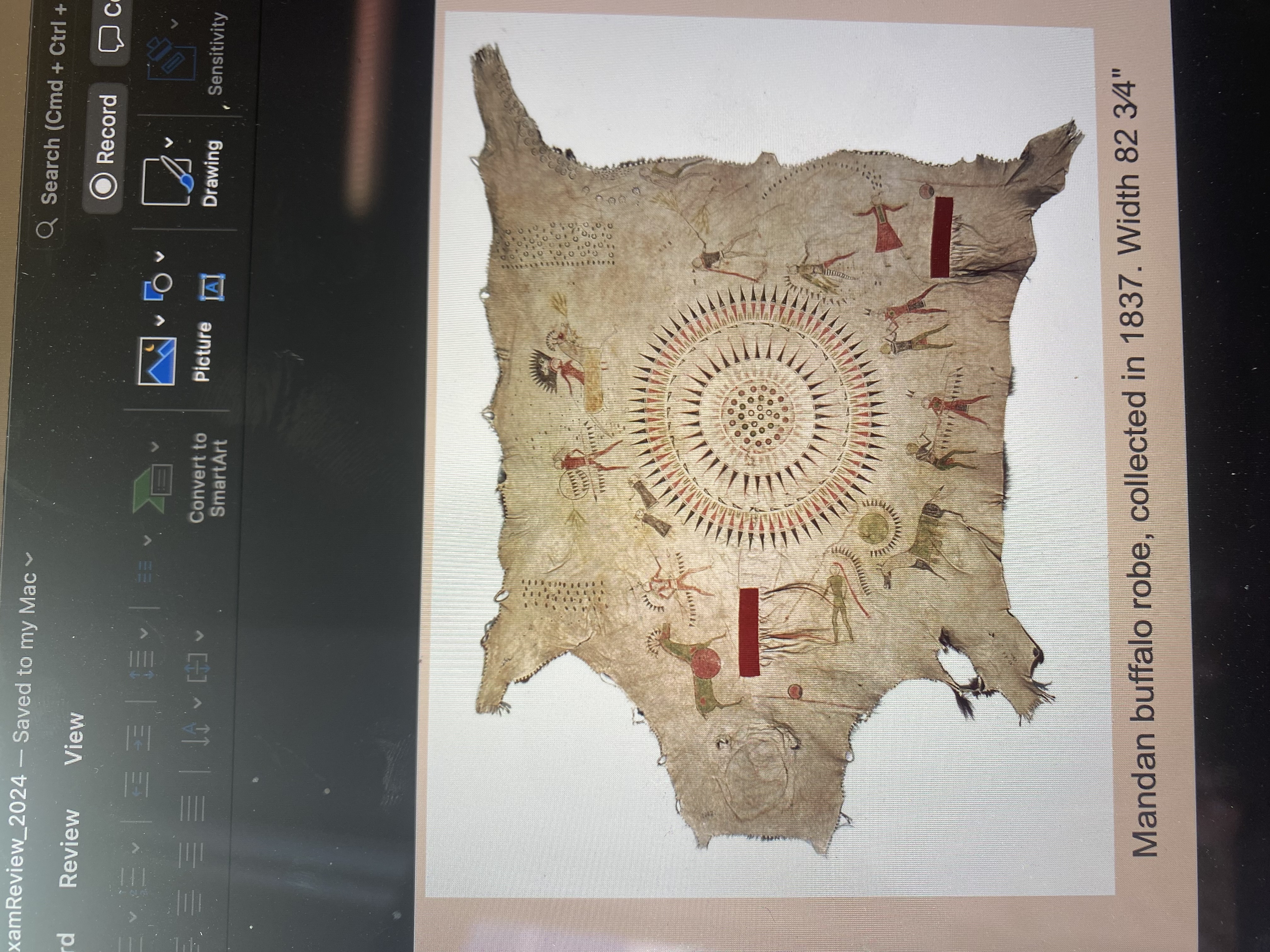
Mandan buffalo robe, collected in 1837. Width 82 3⁄4"
Highly decorated with drawing, had to mark calenders and seasons, biographical seasons as warrior, serve as aid from memory, part of ceremonies and ritual purposes
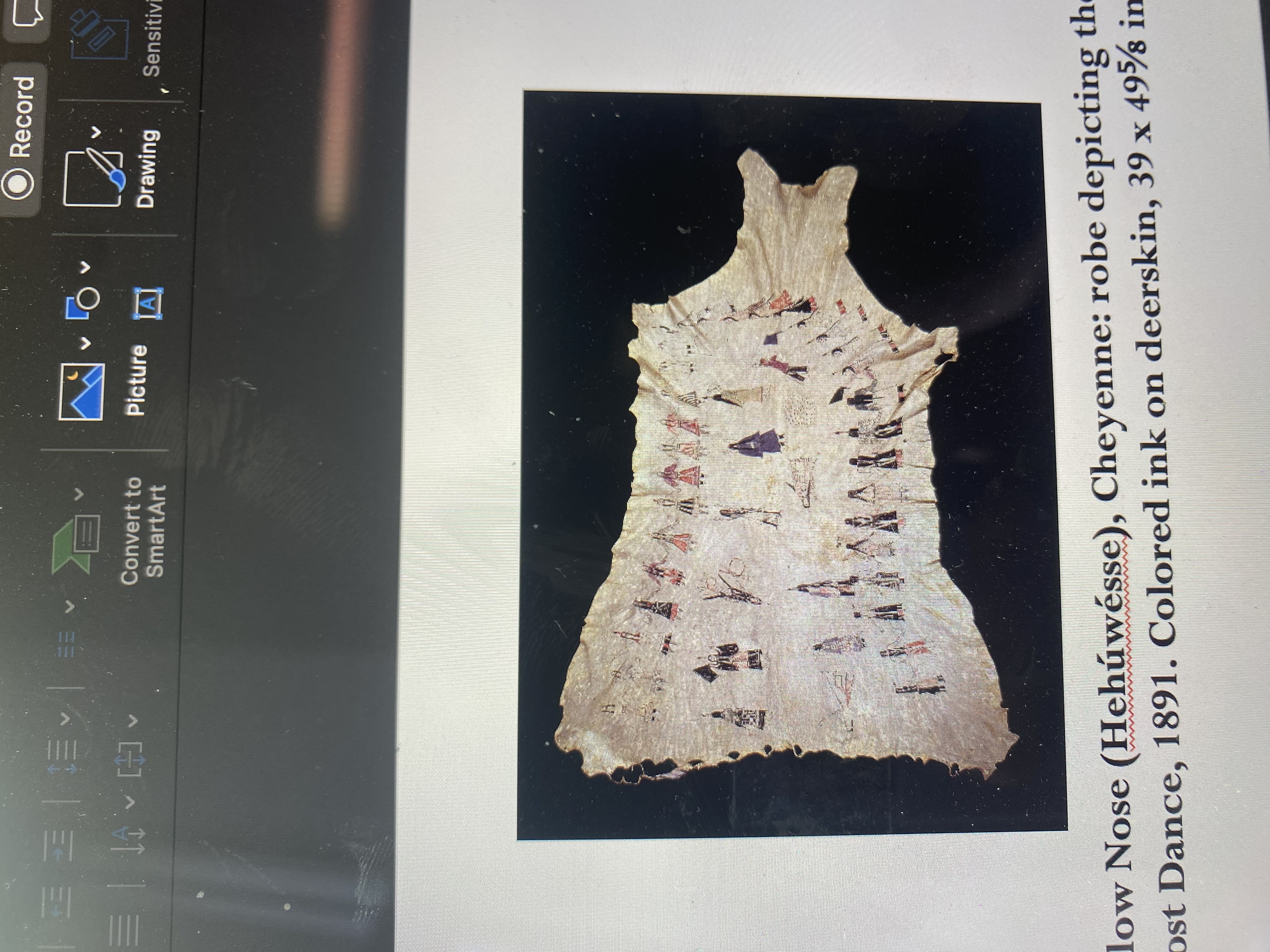
Yellow Nose (Hehúwésse), Cheyenne: robe depicting the Ghost Dance, 1891. Colored ink on deerskin, 39 x 49⅝ in.
Robe depicting robe dance, women prepared them, men painted their success in battle, prophecy that whites would leave and NA would egt land back nonviolently, NA faced issues and ghost dance is revived, could bring about time of peace by doing this dance, grew across tribes, performed ghost dance so time of peace would come, bring buffalo back. US army afraid and stepped up their agressivness, Yellow Nose was captive when he made this, costume was individualized, attention to hairstyles, wave hancurchifs
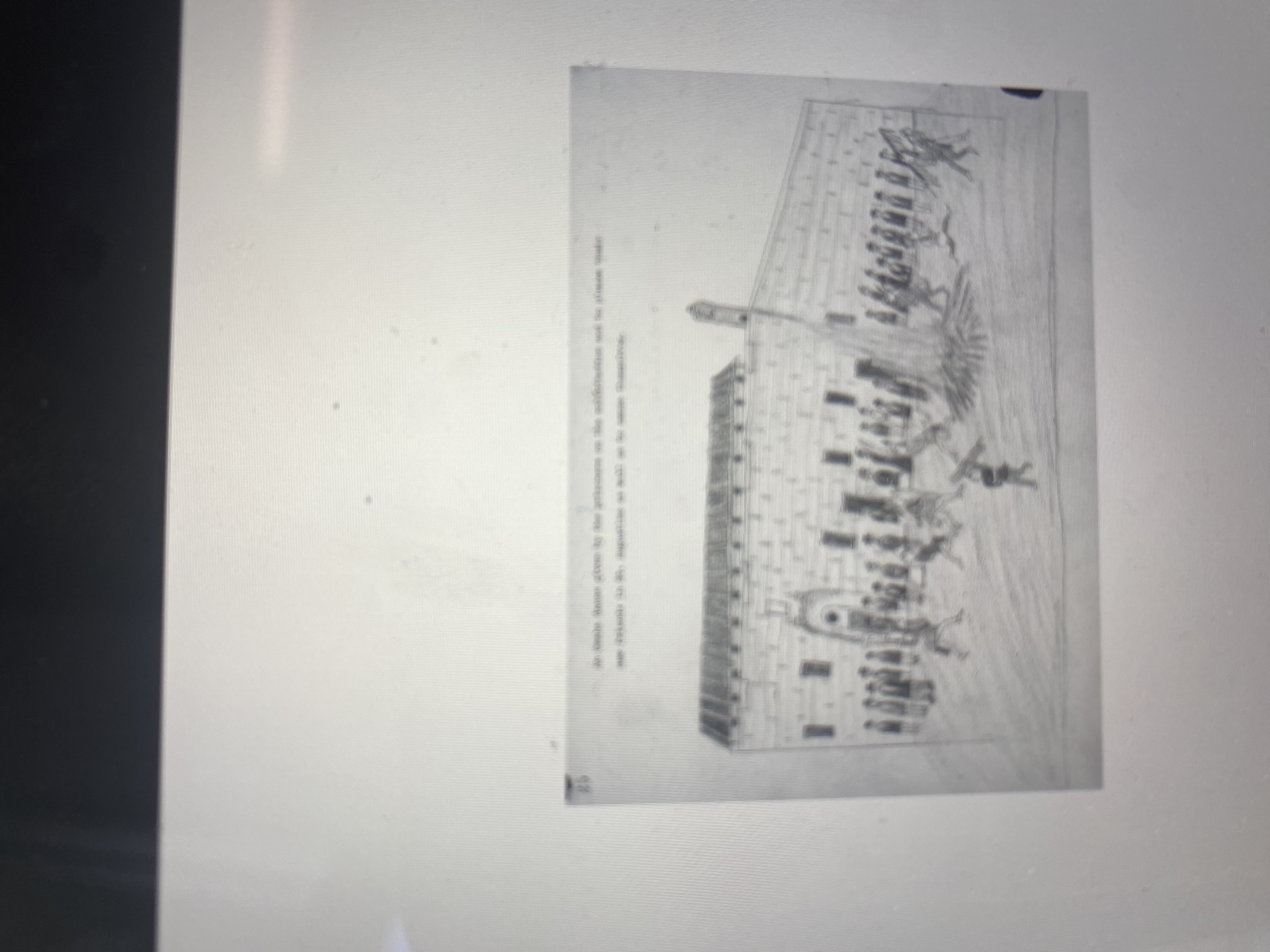
Drawing of a dance performed at Fort Marion for a white audience. By Zotom or Etahdleuh, 1875– 78.
Maintina traditional cultural tradition, people would be invited to see, pretend buffalo hunts, night firelight dances, show put on for audience, NA culture exploded, things are made for touritis, songs are not proformed by native people without permission of owner, can transfer rights to other people, song is personal property, prisoners exchange rights of songs and dances, meaningful expression of culture,
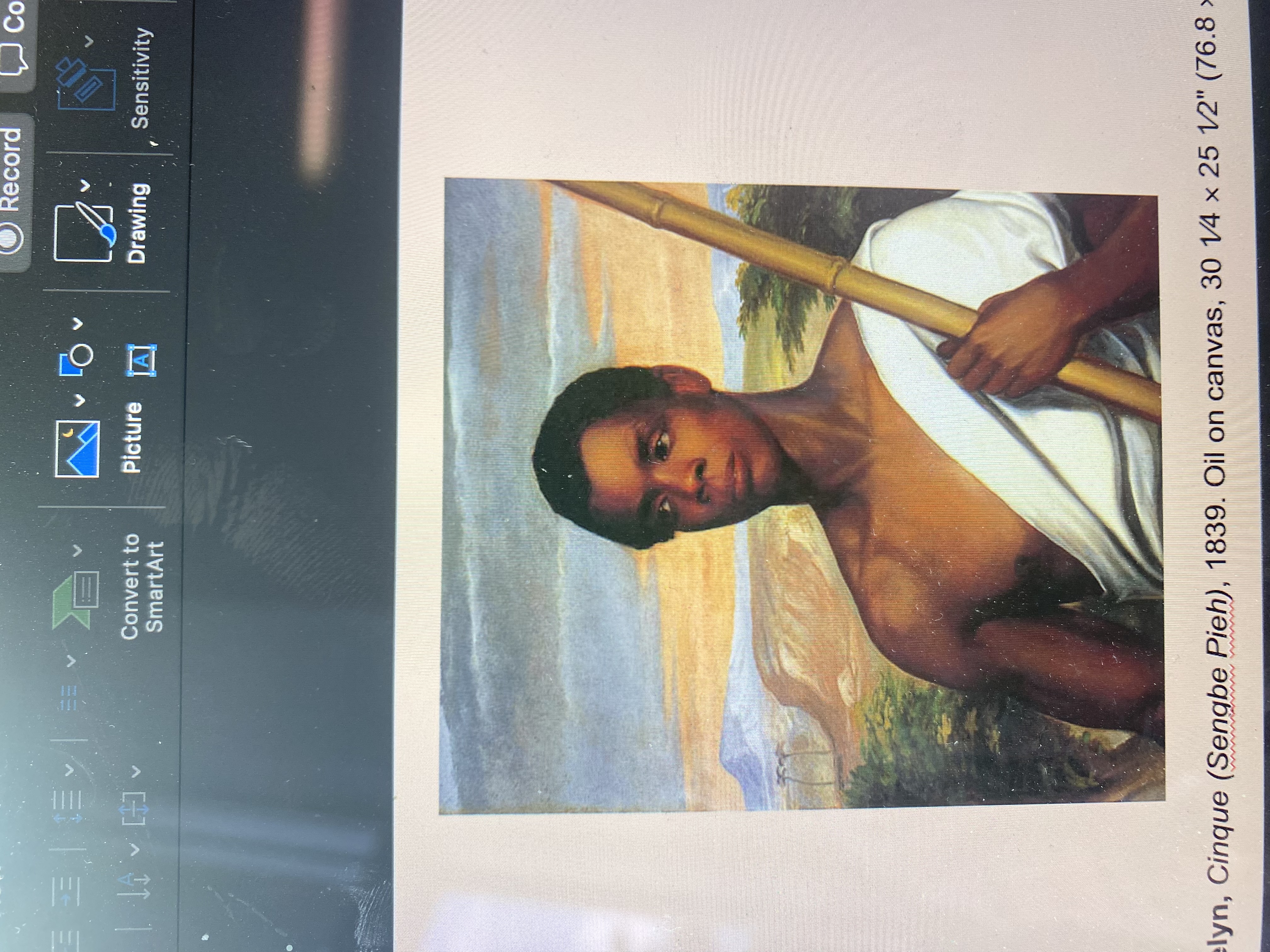
Nathaniel Jocelyn, Cinque (Sengbe Pieh), 1839. Oil on canvas, 30 1⁄4 × 25 1⁄2" (76.8 × 64.8)
Boat filled with people form Africa, took over boat try to get it to W Africa, get stuck in Newhaven, legally US doesn’t know what to do with these people, in jail till court was held, Cinque was leader and hero of expedition, he is simple and deep in thought, not show off, calm leader, not crazy wealthy, idea of underdog, rice farmer in Africa, illegally sold into salvery, 53 africans of boat AMistad, picked up on long island sound, afruged for freedom of captives, in jail for over a year-gain freedom, US supreme court ruled In their favor
painting seen as antislavery display, people uncomfortable with right painting, should be hung because Cinque is well known, because he is black and has fearless look-not how you would normally represent black people-noble depicition-dangerous to their ideas, people did not want to see a black man in a gallery,
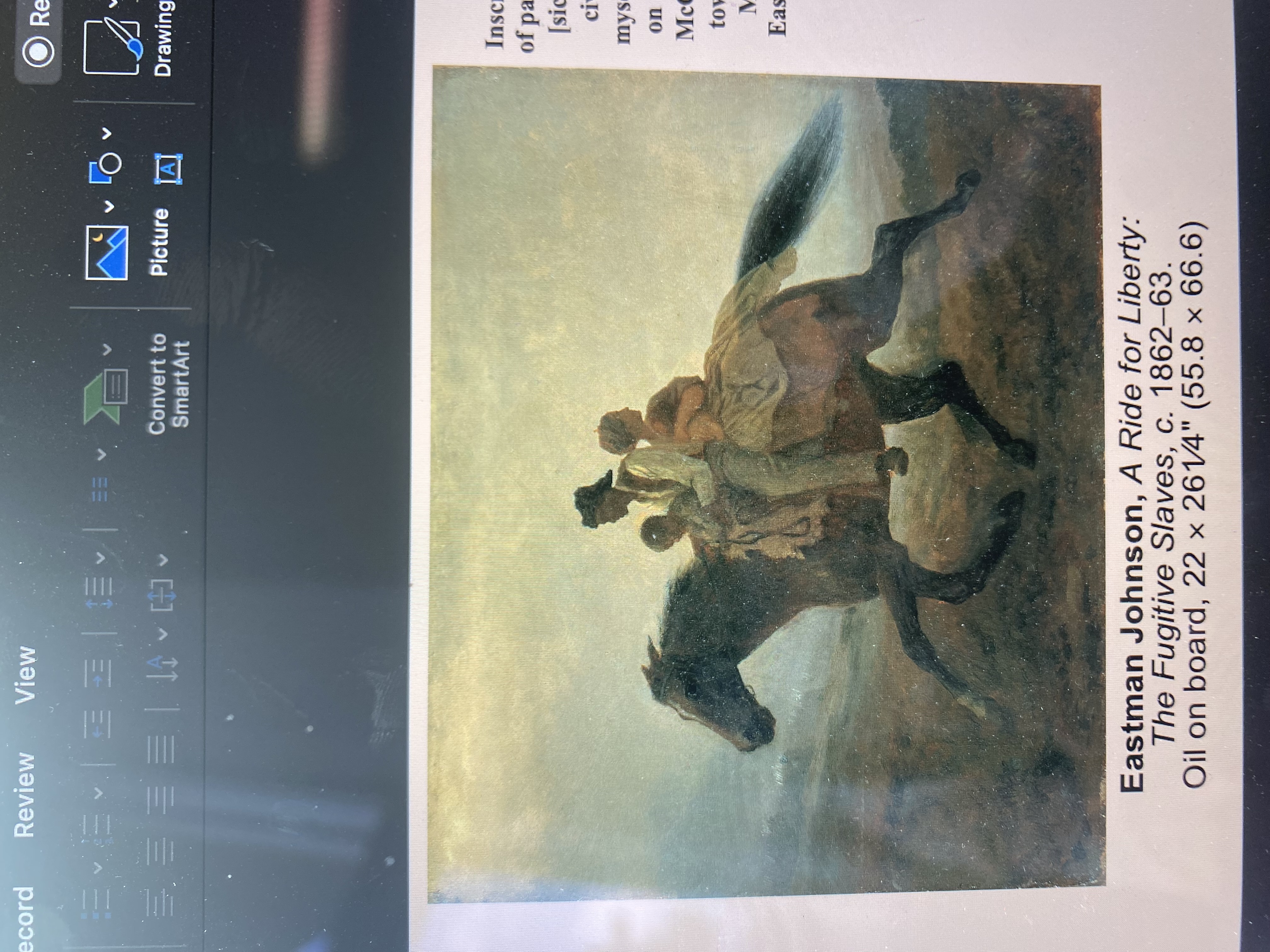
Eastman Johnson, A Ride for Liberty: The Fugitive Slaves, c. 1862–63.
Oil on board, 22 × 261⁄4" (55.8 × 66.6)
Anti slavery image, Johnson claimed he saw this scene happen, is left you can see silver of advance of the McMlellan, sense of eargency, “sic”-originally person made a mistake and they are acknowledging there is a spelling error, Johnson was near the area at the time, this is a construction, urgent cituation-being followed, horse in motion, mother is hiding and protecting the baby, horse seems surrounded by armies, lift quickly don’t have anything with him, dim color skeme-leave early in morning, women looks is profile (Greek goddess, noble) no white people in the image and that makes it unique for the time, departures from the norm, family in middle, totally focuedon them
Recreattion of union army, McClellan, slaves would retreat to north to get to safe area, chance to get away while everyone is fighting
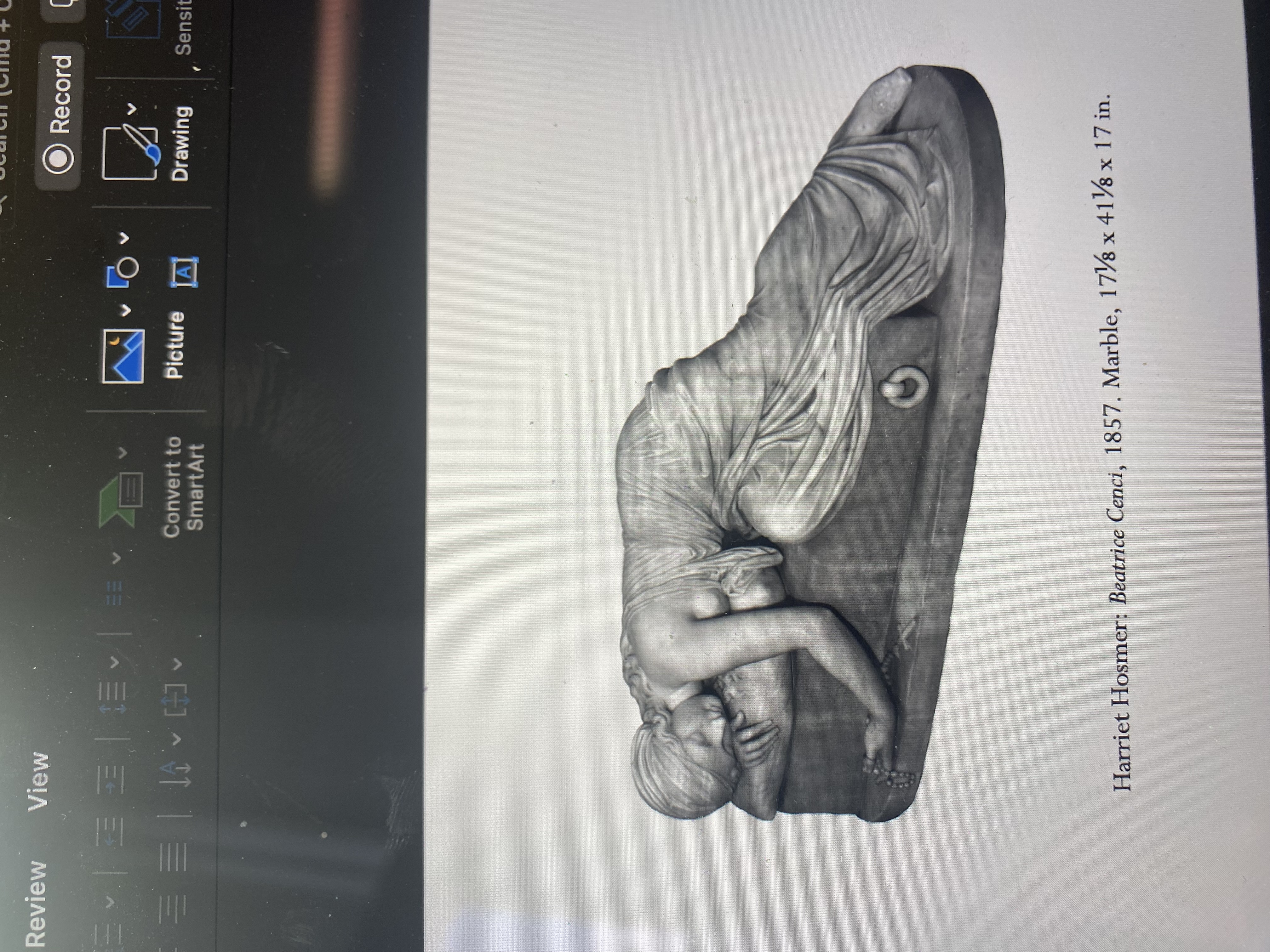
Harriet Hosmer: Beatrice Cenci, 1857. Marble, 17⅛ x 41⅛ x 17 in.
Roman noble women, had abusive father, her mother and brother killed father, are arrested and are about to be put to death, both her and her mother and condemned, they will be put to death, devoted to god, see rosary, Hosmer was one of few who did sculpture in US, women were usallymodels, easier to paint/draw/knit at home, sculting was big endeavor, she specialized in portraiture, first women to study anatomy, women in amer art profession increase in late 19th cen, higher numbers are not guarantees of higher overall success and attention, Hosmer moved to rome, heritange in rome, tradtion of sculpture in rome, material and inspiration she ants, she has freedom, influenced by ancient geco design, very neoclassical,
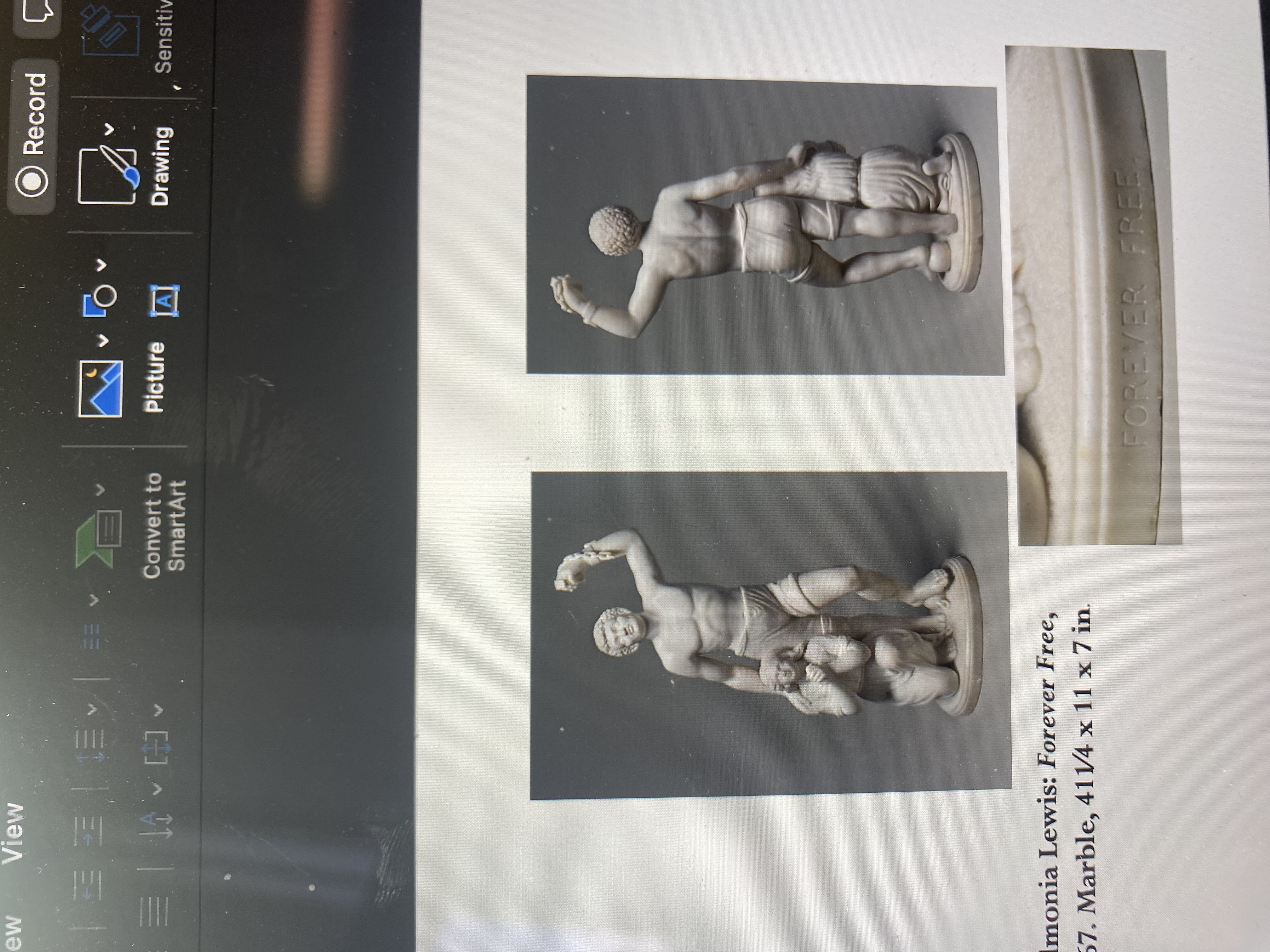
Edmonia Lewis: Forever Free, 1867. Marble, 411⁄4 x 11 x 7 in.
Meant to see on all sides, compelted in rome, see almost no black man standing in visual culture, he as broken free, he is liberated, got accused of trying to poison a student, seemed racially motivated, won the case, went from overland to boston, study local sculptor, movesto rome in 1868, Edmonia lewis joins group of sulptors in rome, sculptor is doing all the work until the end and then gets help, Lewis did not want anyone to think her less then so she did it all herself, Lewis over saw the men in the studio, she had complex ideas, liberation of women and black americans, makes figures look lighter to appear to wider range of people
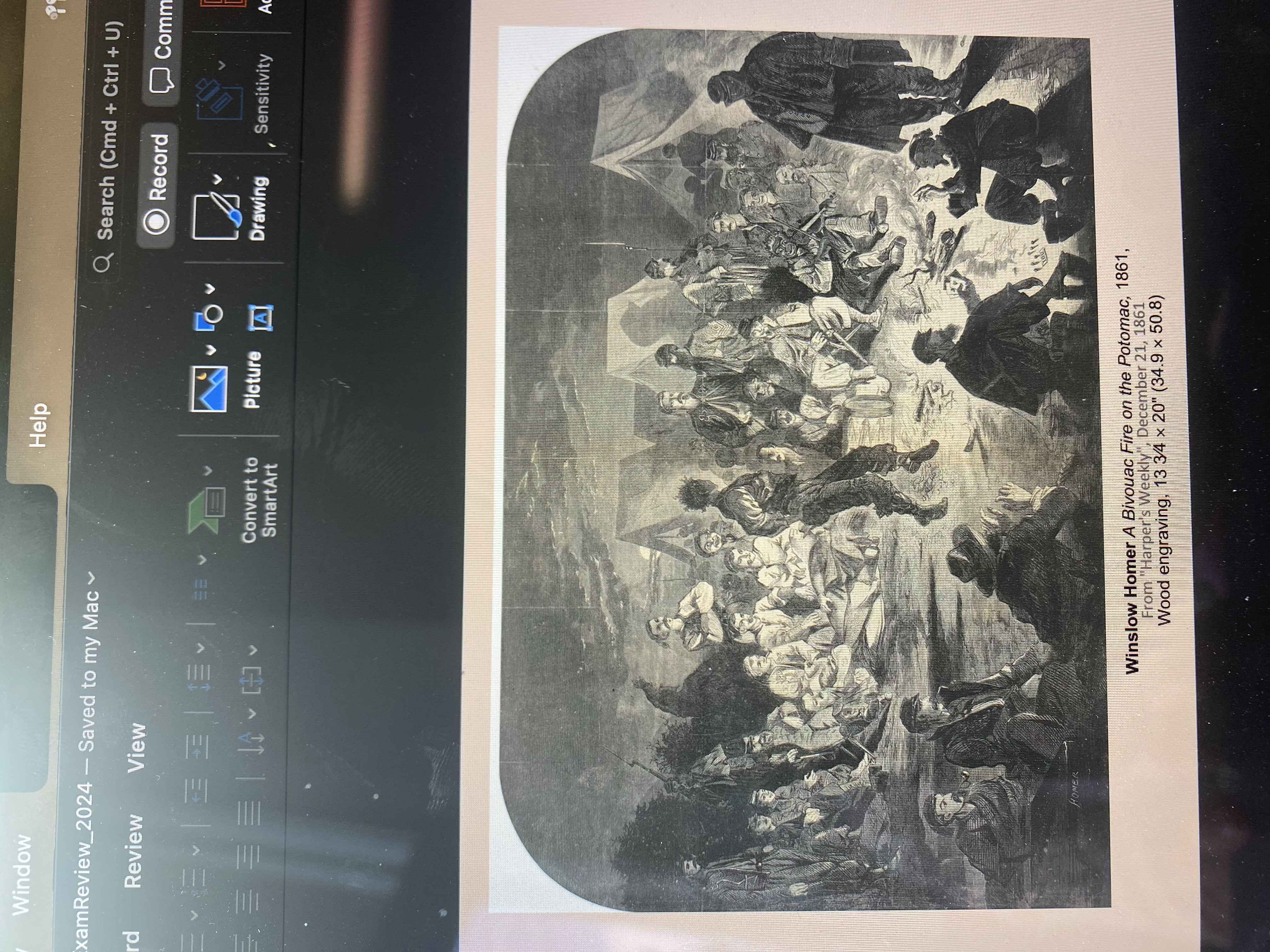
Winslow Homer A Bivouac Fire on the Potomac, 1861,
From "Harper's Weekly", December 21, 1861
Wood engraving, 13 3⁄4 × 20" (34.9 × 50.8)
No photographs of civil war, exposure times were long, cameras are enormous and heavy, glass plate inserted into camera, chemicals are sticky, only photos we get are portraits or of the dead, homer made engravings that would be published in harper’s weekly, newspaper, homer goes to virgina to document in drawing and prints whatsahappening in the civil war, recidved training as a fine artist, homer was popular because he showed everyday camp life, African American figure dance round fire for entertainment of union soliders, see people playing cards, smoking pipes, AA play bango, encampments, cool shadows on tents, sterio typical images of AA, black face in US, huge eyes and toothless smile, black face-shapespearOthello was supposed to be black,
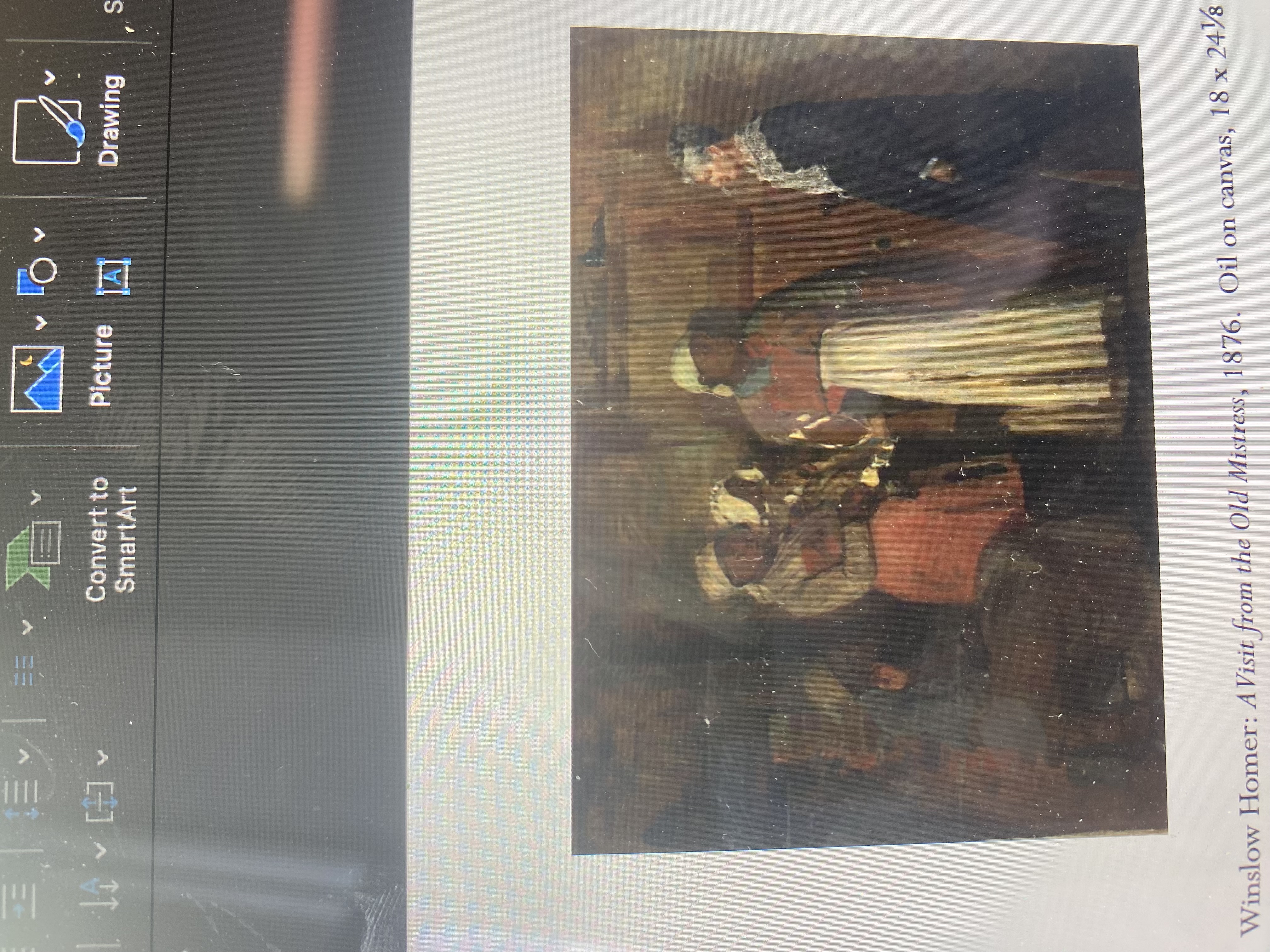
Winslow Homer: A Visit from the Old Mistress, 1876. Oil on canvas, 18 x 24⅛ in. .
Old white female, former land owner of right, aged and dignified, before she would have been the center of life, antebellum era-encounter that gets us to think about what post war was like, relationship is different, no longer have toserve her, everything looks the same, no longer have togreet her with kindness, made work after he travledthroughout virginia, nation has to find balance, to work out and reconcile, speak to need for unity
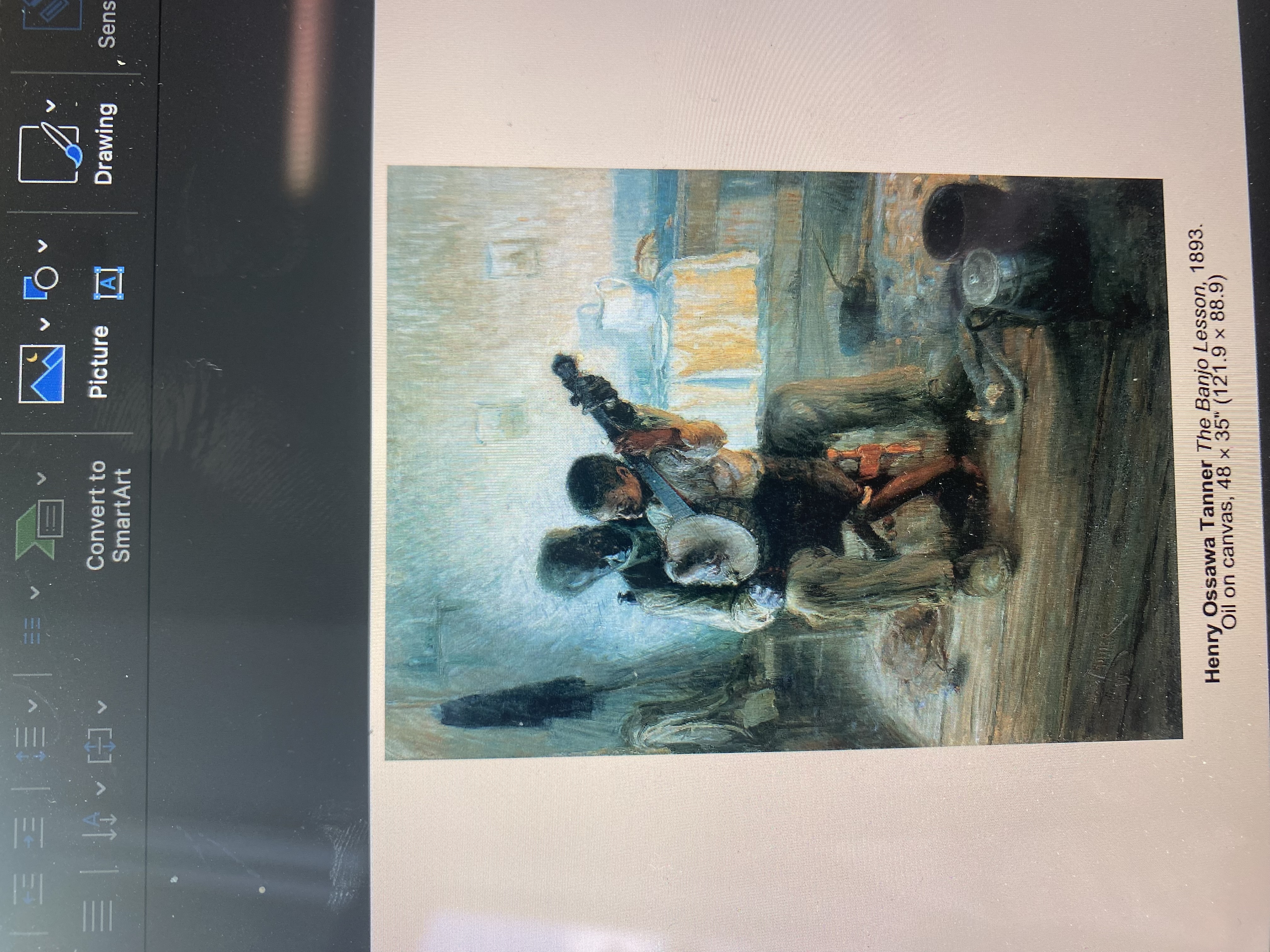
Henry Ossawa Tanner The Banjo Lesson, 1893.
Oil on canvas, 48 × 35" (121.9 × 88.9)
African ameriacan artist, tries to subvert negative seriotypes, sweet semimental scene of grandfather teaching grandson how to teach bango, bango come from African prototypes, boy is standing and curved, grandfather looks solid and stable, light illuminates, having an intimate interaction of family, artitst grew up in African family in pennsulvania, studied there, harassed, leaves and goes to paris, lives there almost his own life, well reveced in paris, got typhem fever, takes up teaching post and spends time in blue ridge mountians, see poor africans, took photos for the paitning, not supposed to look down on them, they are noble and human, painting this in paris
Give charcters dignity, doing everyday things, ordinary people dignity
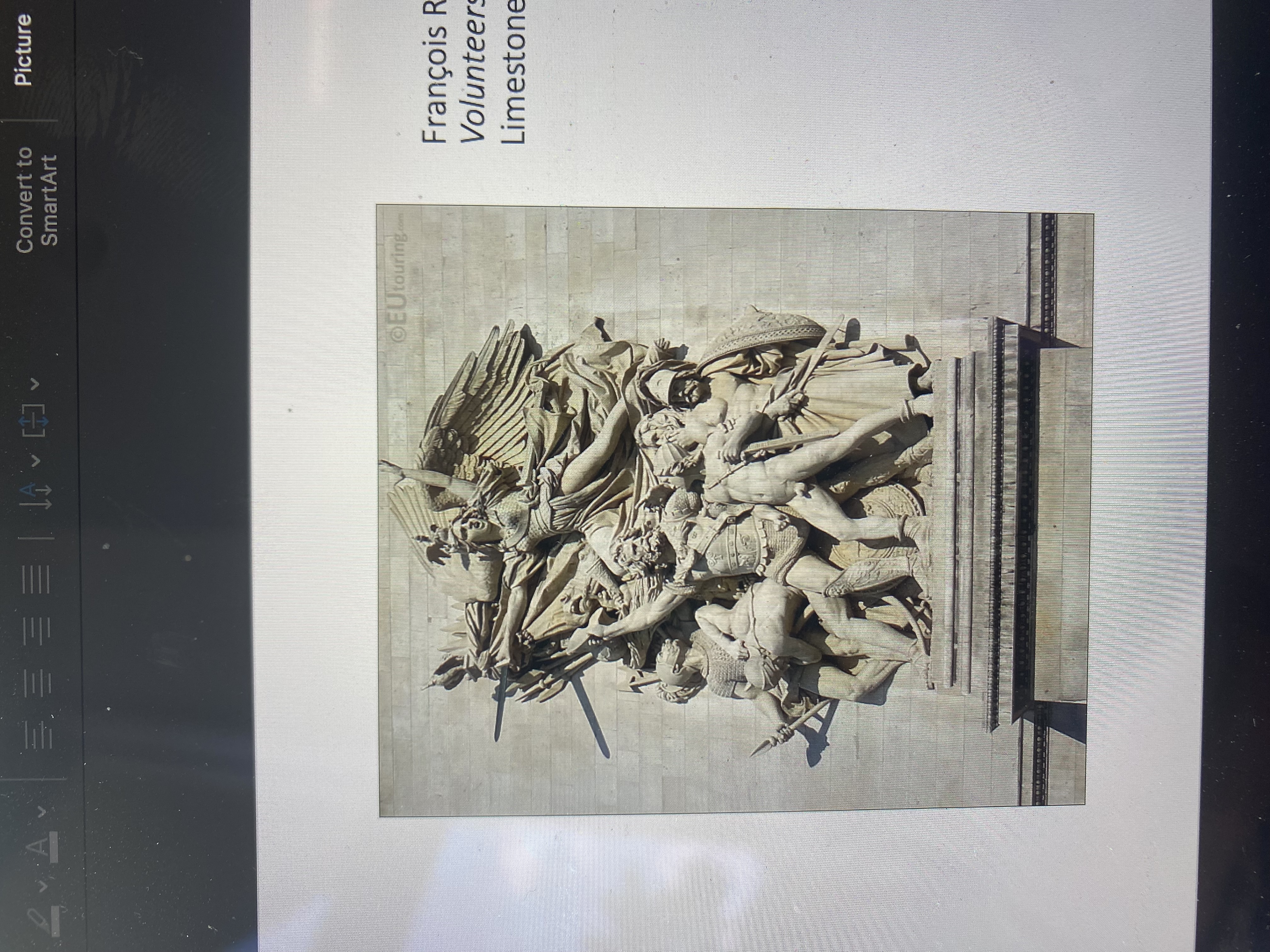
François Rude, The Departure of the Volunteers of 1792, 1833-36. Limestone. La Marseillaise
Napolian wanted the arc de triumph, wants his empire to connected to ancient rome, sculpture on arc de triumph, work stopped after exile of napoleon, policy commissions sculpture to one political faction, made to promote national reconciliation, public art, warrior figure, wings and open mouth calling people (personification of liberty), no one is looking or interacing with her, shes an aligory/idea, armed men of different ages to show that everyone has to come together for democracy to happen, armored man, old and young, made to commemorate moment in 1872 where France has middle of revolution, French citizen arym fight back against sweeden, sculpture is the name of the French national anthem, written in 1792, speaks to first French citizen army, as a child his father was in citizen army (Rude)
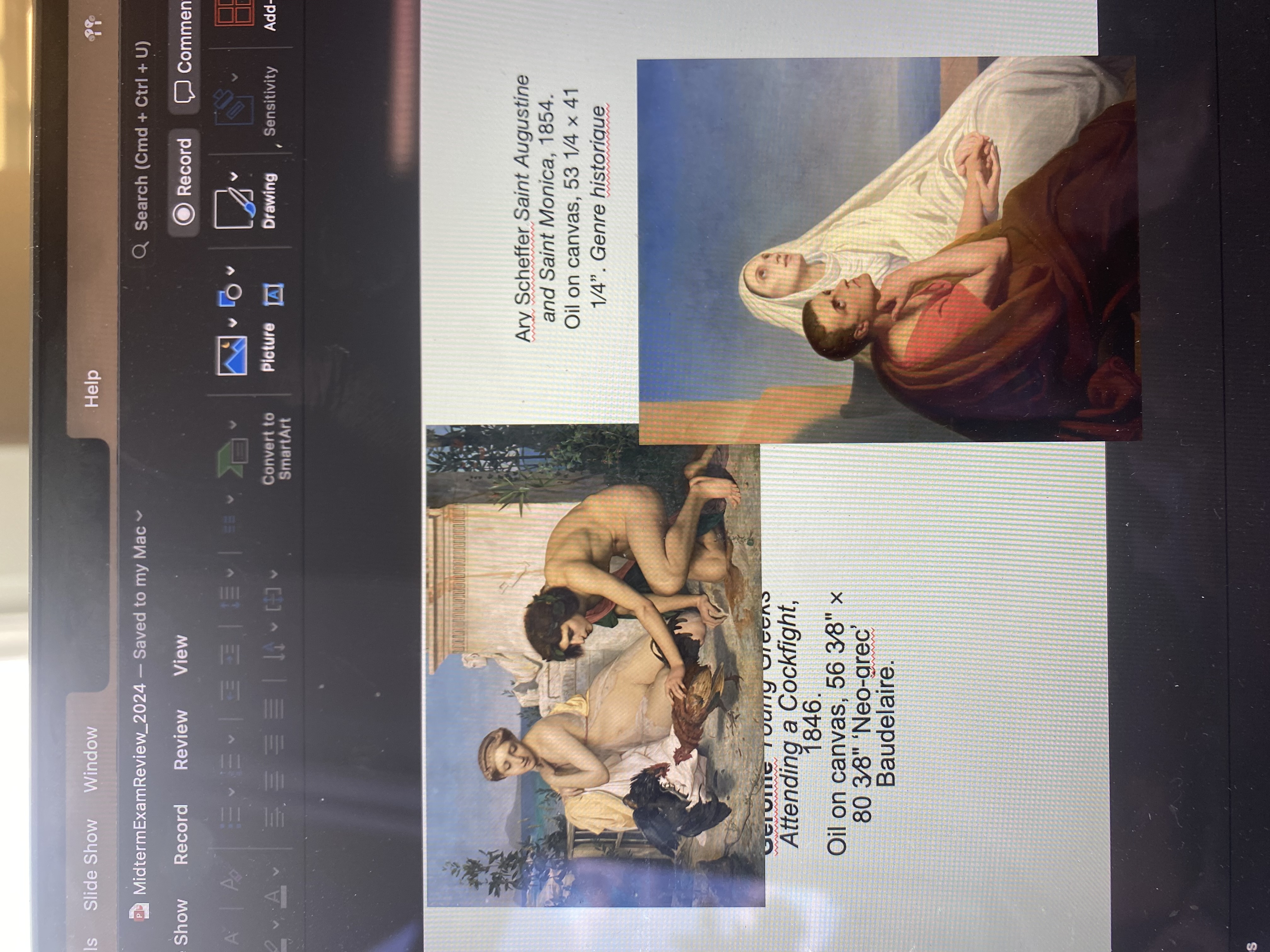
Gérôme Young Greeks Attending a Cockfight, 1846.
Oil on canvas, 56 3⁄8" × 80 3⁄8" ‘Neo-grec’ Baudelaire, Ary Scheffer Saint Augustine and Saint Monica, 1854.
Oil on canvas, 53 1⁄4 × 41 1⁄4”. Genre historique
New type of painting, history painting-GIGANTIC, depicscenes from ancient history and bible, depict current events
Genre painting-smaller, about everyday life, usually inside, flower paintings
This is a combination of both ideas, isel sized paitings, nothing new or different, blending styles together, Newgrec– new Greek style, smooth brushwork, pale colors and scenes form ancient Greece, we are supposed to see contrast belween youth and aging, ancient stone behind them will last longer than their flesh bodies, no one critiziedthere, looks ”weak and artificial”, saint monica – saintaugistine’s mom, showrtly before her death, discussing the kingdom of heaven where she will go, used his own mother as model, both look up at the sky/hold hands, love and acceptance of death, mary and jesus feel

Jean-Auguste-Dominique Ingres, Portrait of Louis-François Bertin, 1832. Oil on canvas. Bourgeoise
Reclining nude female with extra vertebray, like hawk, nose is beak like, hands are like claws, fingers are oddly pointy, eyes have predator look and close together, aggressive person who gets what he wants, good representation of new rising middle class, bourgeoise– new middle class, new political changes, middle class person succeeds in capitalizism, bourgeoise can be nergative because of the idea of new rich, old rich is classy without having to tell you, founded journal, supports consitiuational monarchy, published articles, awesome details – with line, tosseledhair, every strand is specific, wrinkles show experience, eyebrow is lifted so, physically larger, looks like he fills canvas and has large presnse in business
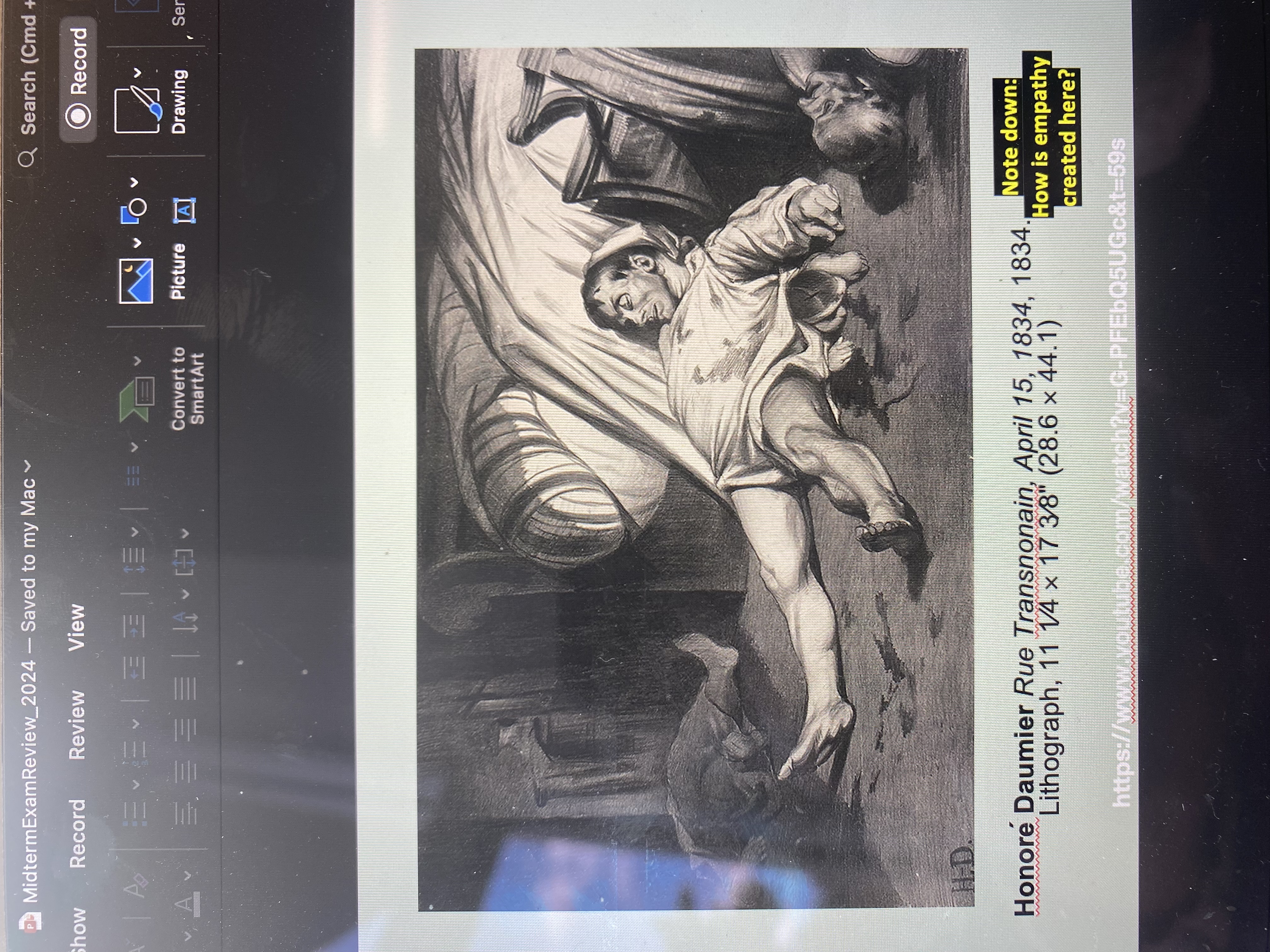
Honoré Daumier Rue Transnonain, April 15, 1834, 1834.
Lithograph, 11 1⁄4 × 17 3⁄8" (28.6 × 44.1)
Daaumier’s lithograph, based off real event, have empathy for figures were, based on politically charged event, no hope all dead, state of undress, not something you would go out in only clothes friends, not in uniform, in night cap, caught unaware, child under him, blood puddle, lower classes team up with middle classes to over throw citizalking, protests got large and loud, met withviolence, citienking stops anything that looks like revolution, April 1834 working class in riots, at night soldiers entered building and killed people, workers protest against suppression of other workers having revolt, support workers revolting, shot and hit them, went after everyone, conservative papers said that police were shooting, new papers were conflicting, dramatic light on bed, was in bed, slipped off, bodies are foreshortened to look more dramatic, made it for a publicaiotn that supported freedom of the press, did series of lithographs for them, when prints sellers exhibited, police took it down and tracked it down, police took litographycstone
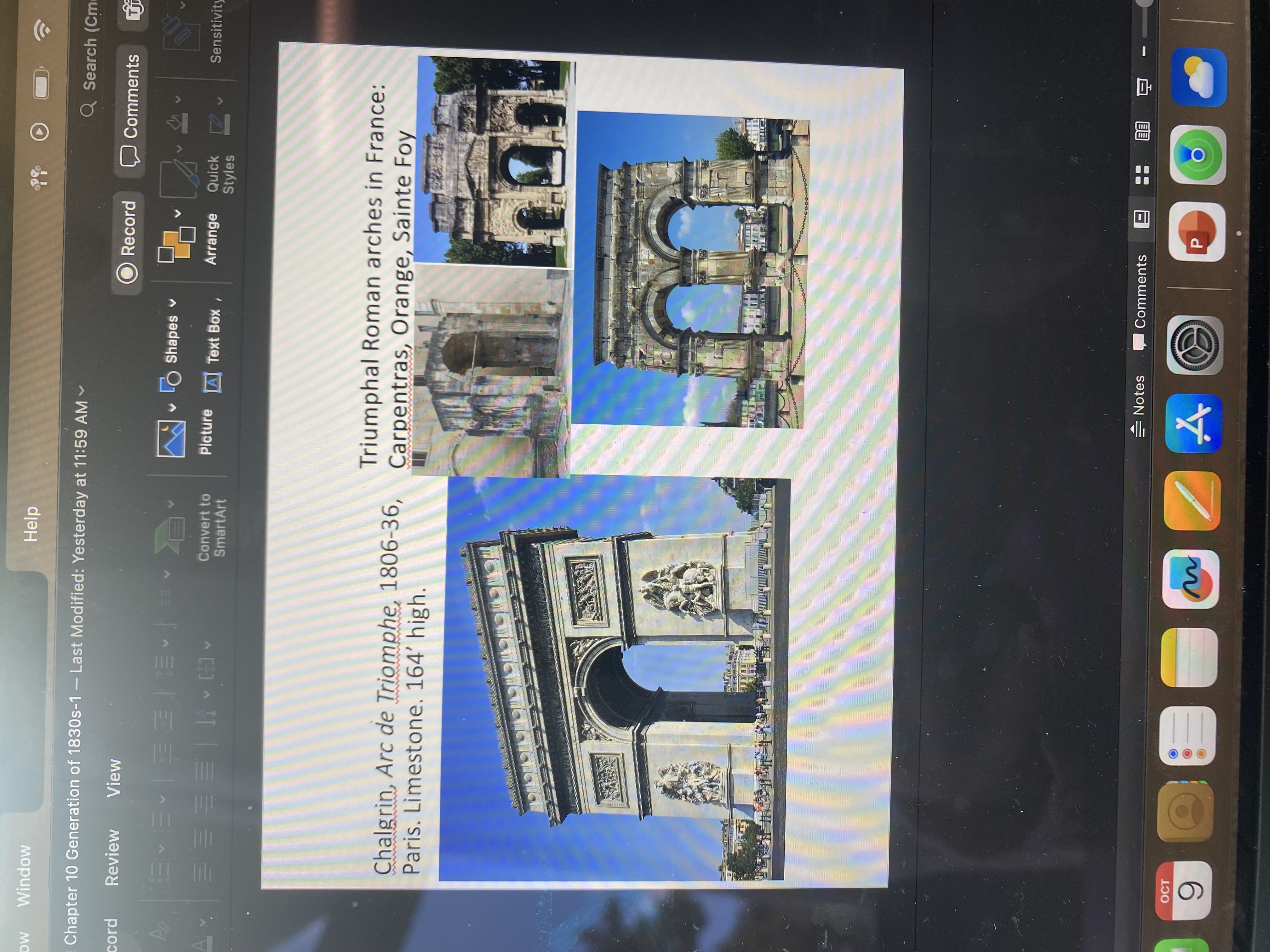
Chalgrin, Arc de Triomphe, 1806-36, Paris. Limestone. 164’ high. Triumphal Roman arches in France: Carpentras, Orange, Sainte Foy
Napoleon copies greek/roman structures to try and make himself to that “greatness”
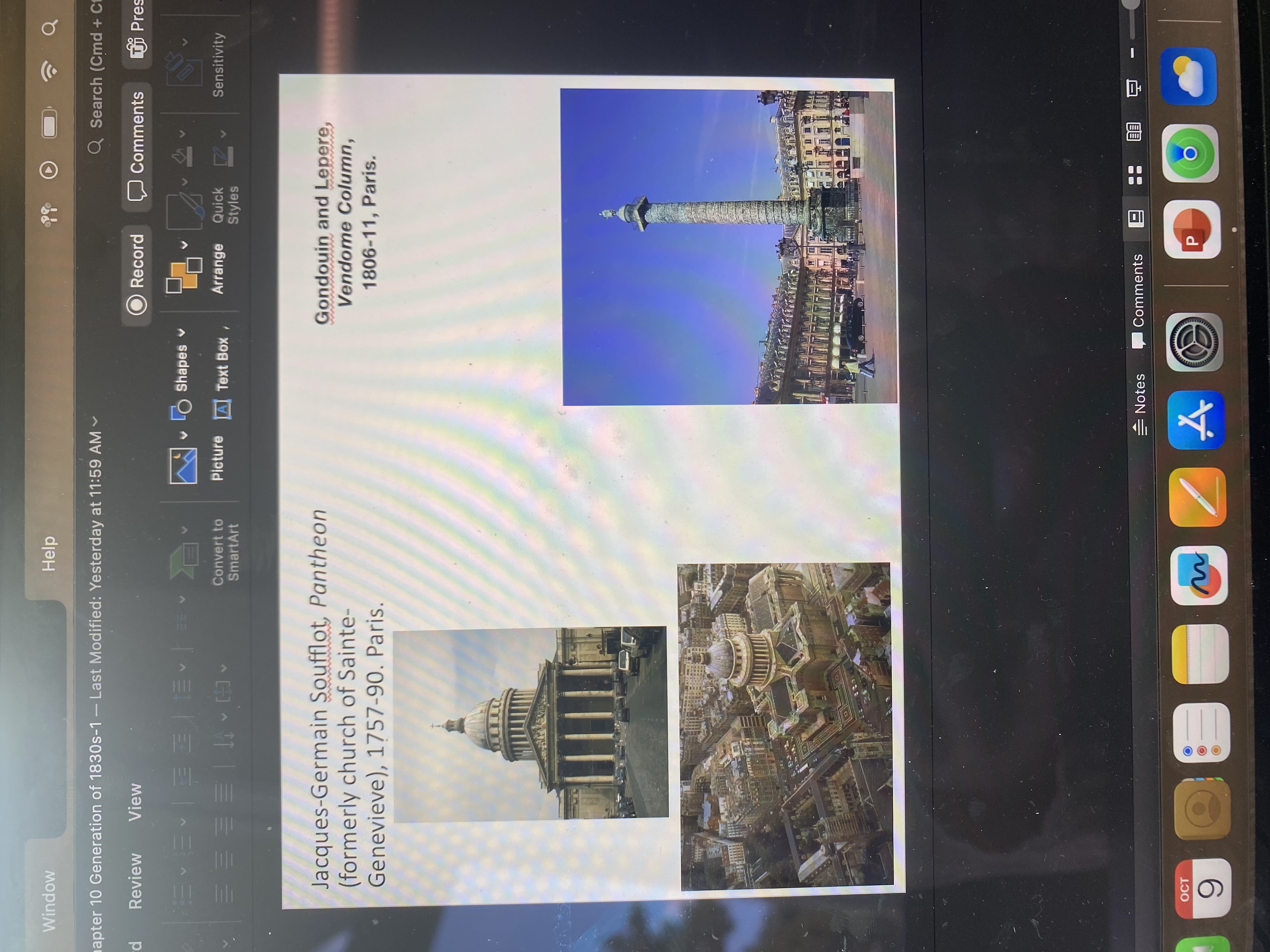
Jacques-Germain Soufflot, Pantheon (formerly church of Sainte-Genevieve), 1757-90. Paris. Gondouin and Lepere, Vendome Column, 1806-11, Paris.
Napoleon again copies greek/roman structures to impersonate himself has powerful and god like
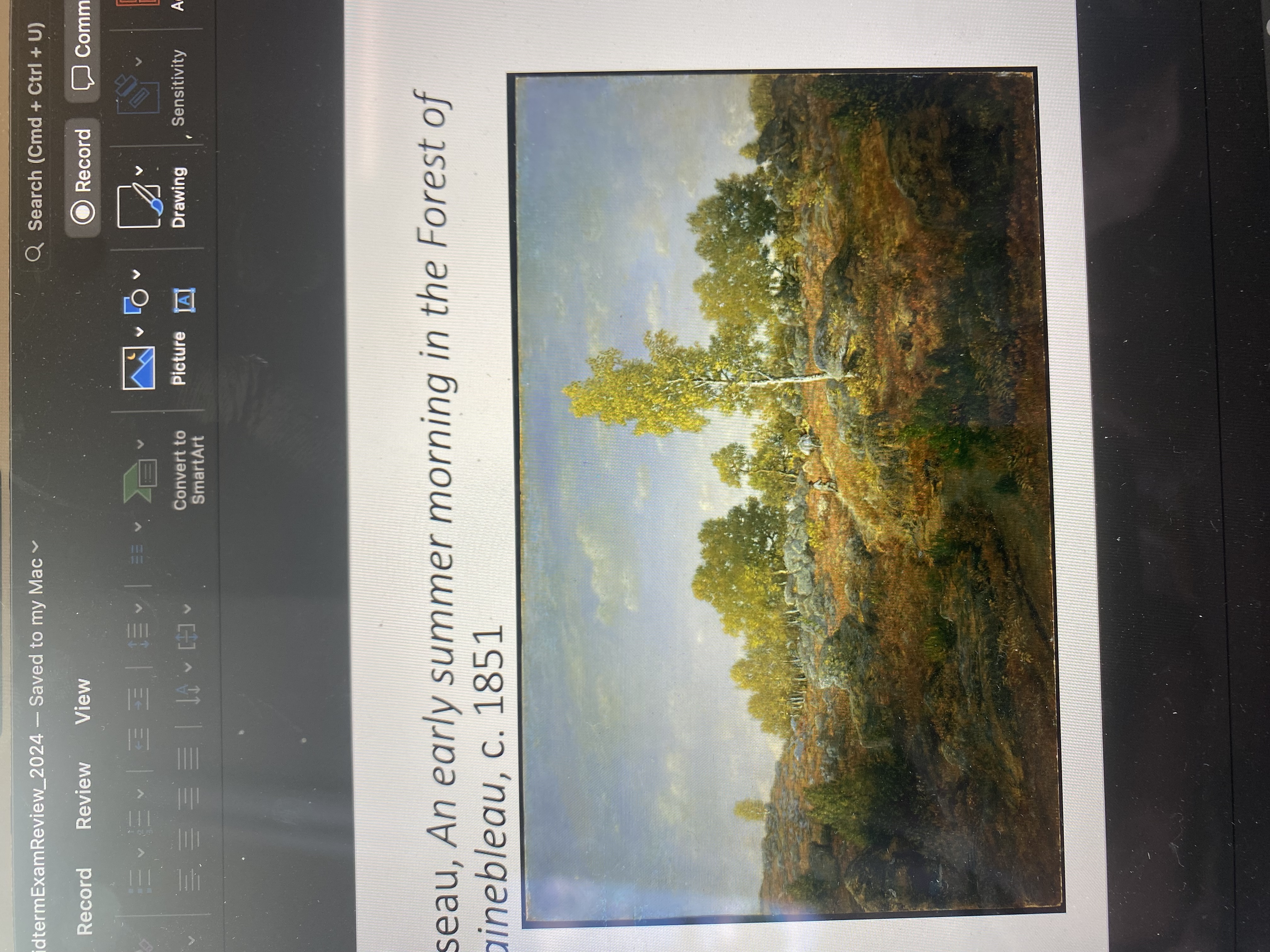
Rousseau, An early summer morning in the Forest of Fontainebleau, c. 1851
More people are going to salons and are interest in art, barbizon school, Realism, Rousseau is part of this group of artists, they liked to paint in the bardizon area outside of paris, went there to get outside of the city, he lived there the rest of his life, 1816 French academy introduced new prize in landscape painting, prize to go to rome, serge of landscape painting, forest is train ride from paris, used to be king’s hunting ground, made large landscapes-John constable, low view point, as if we are down looking up, makes forest look dense, make effect of sunset, trees are in web, reds/oranges, time of day and place, 1849 expanding railroad, commercial interest here, to build hotels and businesses, he protected the trees, potietioned the gov to protect the forest of Fontainebleu
Had back and forth success at salon, 1840s hes rejected by salon, revolution of 1848 take charge of salon, Rausseauis asked to submit a paiting to make amends, it is meant to look like he did it on the top, not result of spontaneity, he would rework everything over and over again, Rausseauwas never satisfied with his work, rousseau is doing same scene at different times of day and seasons
Attention to detail, would be called his mature style/technique, looks like it glows, pople at the bottom and a donkey, insignificant to landscape
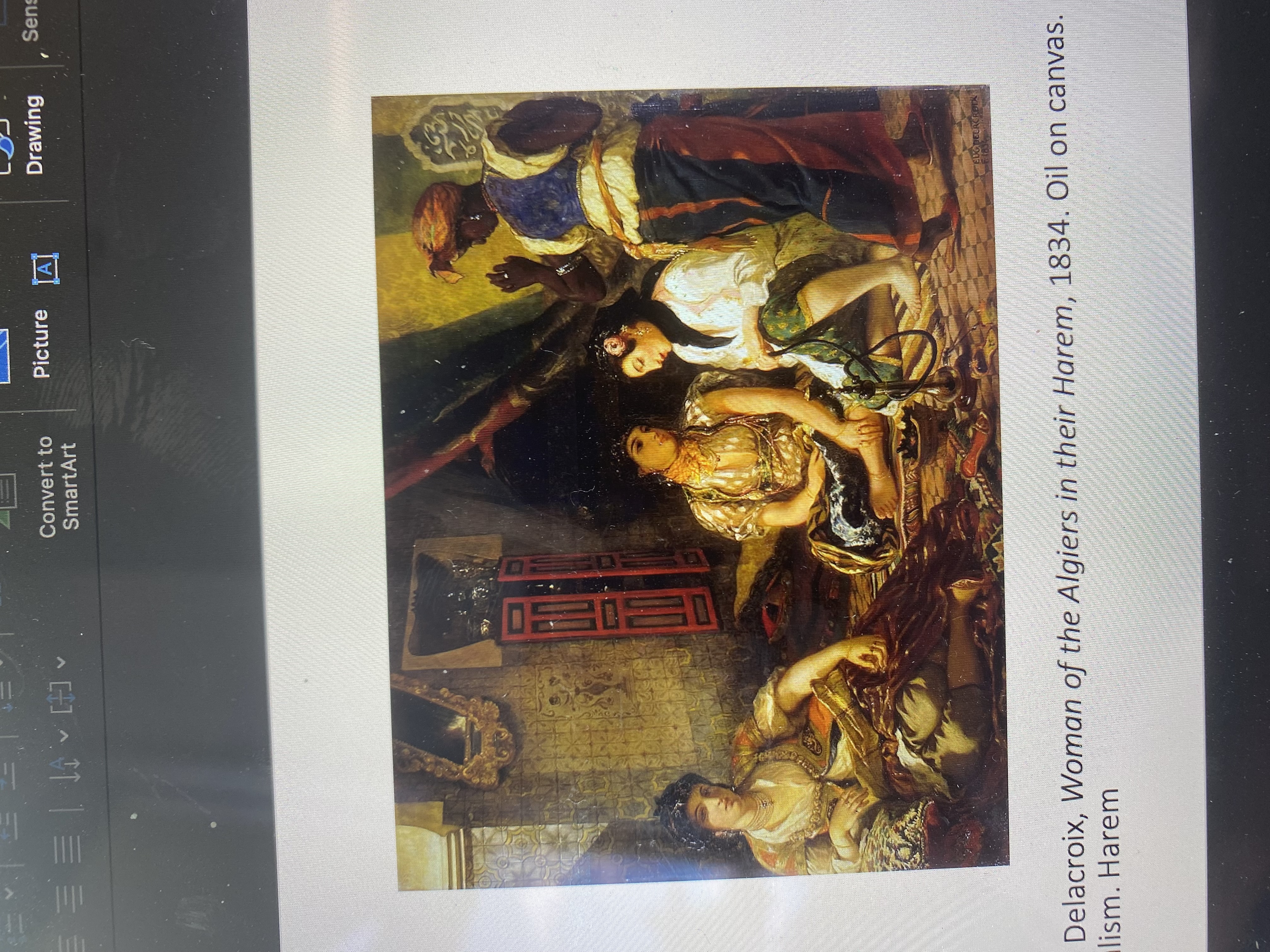
Eugène Delacroix, Woman of the Algiers in their Harem, 1834. Oil on canvas. Orientalism. Harem
Orientalism – west view of the east, east is very vaugue, how they think the Chinese afganistan look, most hadn’t even been there,Delacroix actually went to north Africa, a lot of them were muslin, people were fascinated with north Africa, harem-group of women related in different compacities (daughters, aunts, mothers) usually in sexual terms, people from these areas took multiple wives, women woukd have been separated from the men into different spheres, research on painting – delacrois say and went inside a harem, probably he saw one when no one was there, as a French unrelated man could not go into harem, no men could anyway, dalcrois gets the sanals and the patterns of sandels right, micro interactions – 4 women, look relaxed, black African domestic worker standing, probably related those seated, girl in the left is looking directly at the painting, women is drawing us in, two women are interacting with each other, Arabic calligraphy, different hairstyles and clothing true to the time, women on rug have shoes off, all of details are made to look exotic
, lady in white pops, striped guard worm by main wife, curtain “fade to black” on right makes it more realistic, curtain seerates the space, elbow in pillow – penetration,
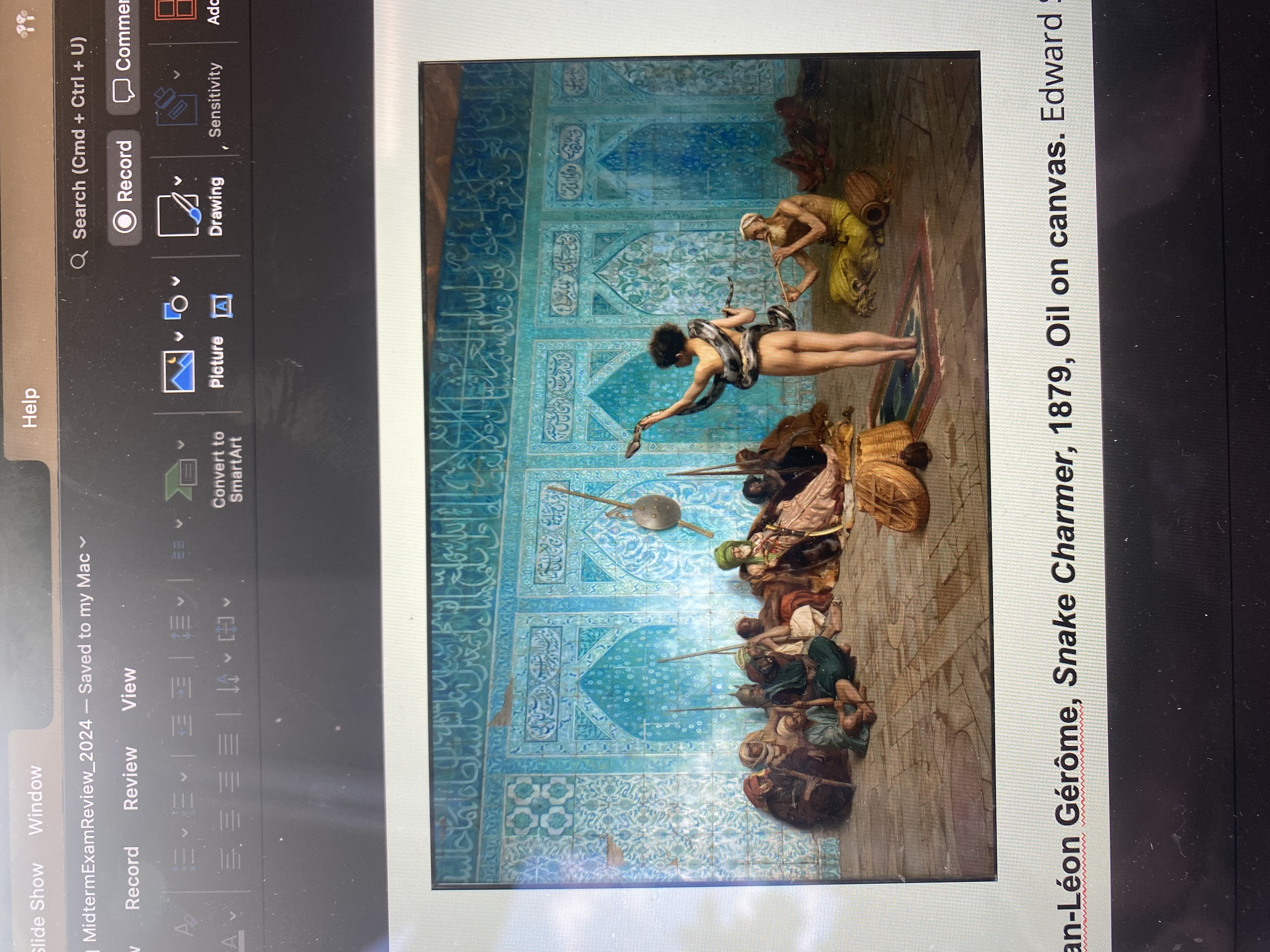
Jean-Léon Gérôme, Snake Charmer, 1879, Oil on canvas. Edward Saïd
Arabic calligraphy, religious structure, ban on images in islam, decorate moscs with tilework, muslim men, barbaric? Huddled on floor, snack charming is supersticious, similar to depictions of NA desomated, respect for visual culture, disrespect for people, french have steriotypes for arambs that they are lazy and passive, exotic-variety of ethnicities, boy is nude and standing, vulnerable, older men are sitting, look easily conquerable, they should conquer them,
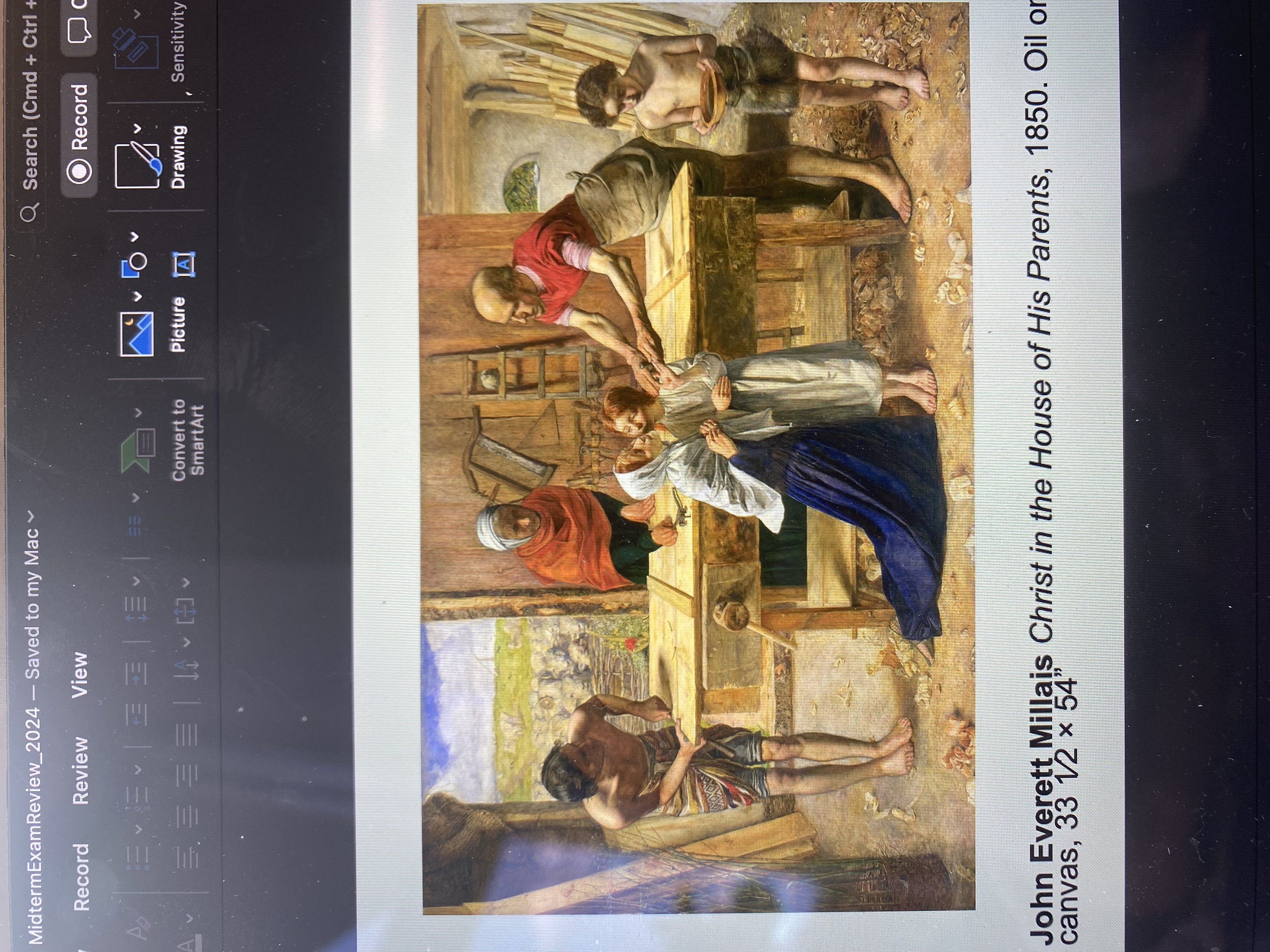
John Everett Millais Christ in the House of His Parents, 1850. Oil on canvas, 33 1⁄2 × 54”
Mary joseph and jesus, john the Baptist, in the workshop of joseph, red hair was scandal, never usually see the family in labor, mary and jesus look sick, usually depicted healthy and beautiful, john th ebaptist is holding water, johntheBaptist often depicted as hairy from his time in the woods, wearing animal furs, close in age, triangle above jesushead, ladder in background, jesus coming down from the cross, dove rep HS, red on hands nails for the cross, sheep “shepard of people”, realism, hard edges, bright and colorful, placed In triangle format to get eyes moving around image, Millais worked on location like workshop, purchased sheeps head to use as models, Charles dickens said jesus looked like a blubbering idiot,
pre raphaelites brotherhood
•A group started in 1848 and led by William Holman Hunt, John Everett Millais, and Dante Gabriel Rossetti
•Inspired by 15th century Italian and Flemish painting, early 19th c Nazarenes
•Style: bright tones, vivid color, linearity, naturalism through direct observation, direct emotional appeal
•Symbolic realism
•Goal: Regenerate British culture and society
•
•Source material: Bible, Shakespeare, Arthurian legend
•
•Critical of the Royal Academy
•Too easily impressed by ‘tricks of the brush’ and blind to an art of ‘noble conception and perfect truth’ - Ruskin
•In the political background: Chartism
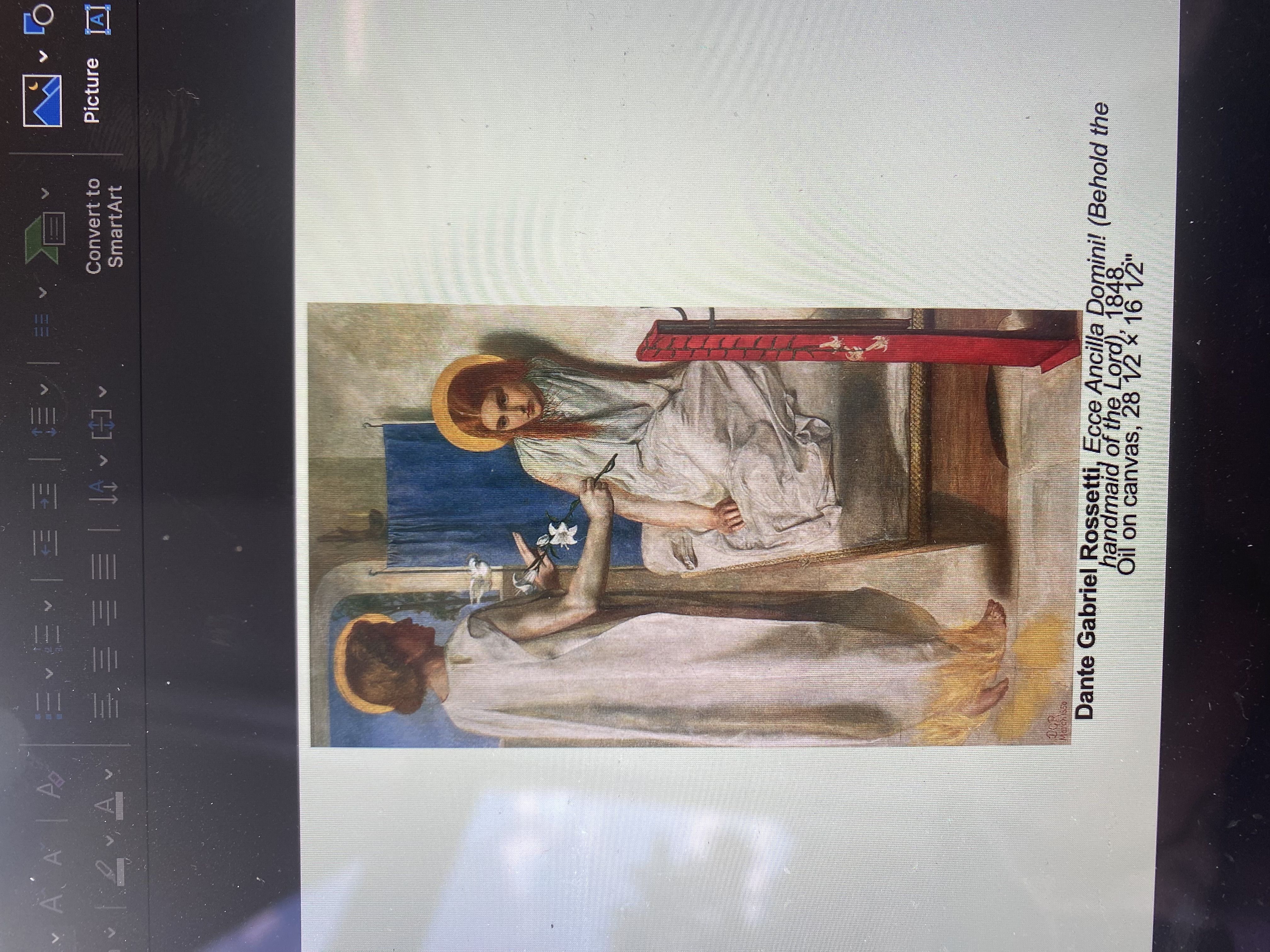
Dante Gabriel Rossetti, Ecce Ancilla Domini! (Behold the handmaid of the Lord), 1848.
Oil on canvas, 28 1⁄2 × 16 1⁄2"
Rossetti drew the thio together, he is a poet, first exhibited in 1850 at national history of fine arts, Gabriel is announcing (annunciation) to mary that she will be mother of god, preraphalite brotherhood like women with red hair, don’t usually see vertical composition, mary is not wearing blue (usually does), blue curtain behind her, angel Gabriel and her have a halo, gives her flower associated with purity, hunched over to look humble, not well liked – rossetti never exhibited publically again
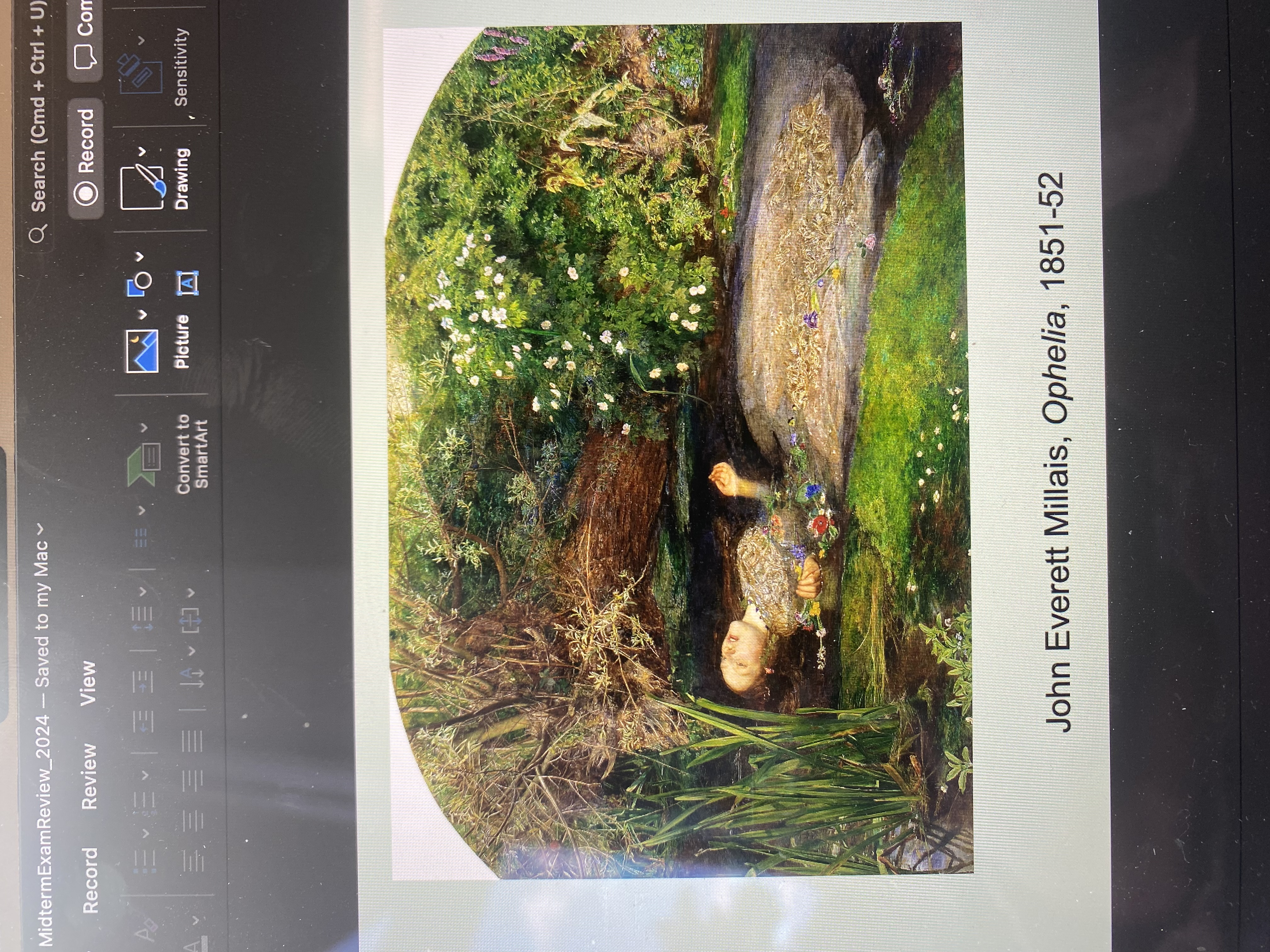
John Everett Millais, Ophelia, 1851-52
Elizabeth sidal was also model in this one, scene from shakespere, shakespere popular at the time, from hamlet, she kills herself, she murdered her father and does mad, she allows herself to drown, sidal sat in a bathtub when she modeled so it could look like she was floating and made her look even more sick, not quite dead yet, preraphilitesbelived that nature contained elements of god, should be true to nature and not change anything, he stayed true to flowers and plants (poppies – death, viloets – faithfulness) in white dress, also sketched outside – difficult – accused of trespassing and almost fell into water and swans were distracting him, solitary longing, sickly women is theme of preraphilites
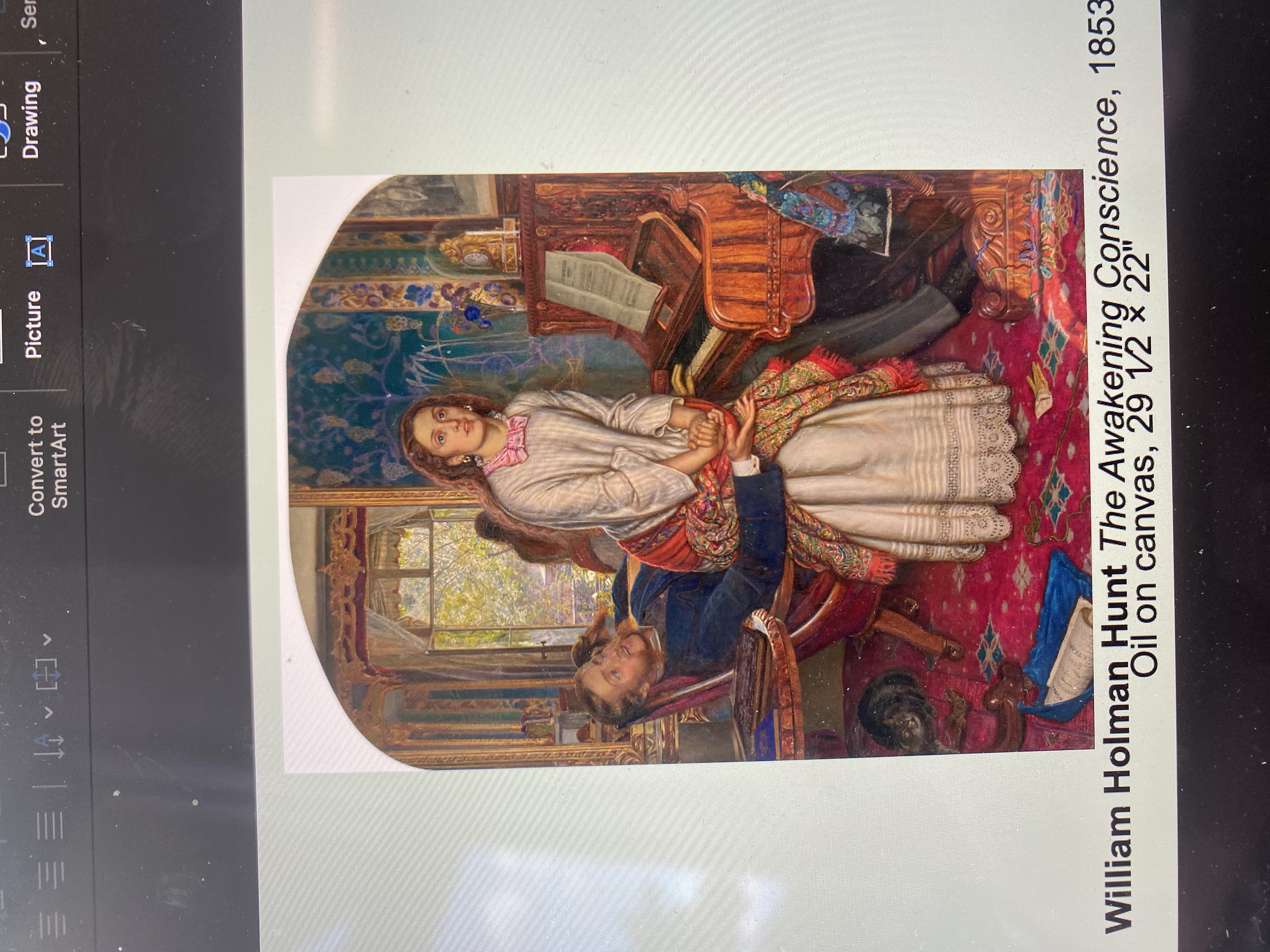
William Holman Hunt The Awakening Conscience, 1853.
Oil on canvas, 29 1⁄2 × 22"
Pre rafillite brotherhood messages had morals, usually slept around with other people, regenerate british society with beauty, women is his mistress , she is not wearing a ring, inimatley connected, llisening to beauty together, she is surrounded by new luxury, “kept women” – he got new apartment for her, spiritual realization allows her to reflect after hearing the song, she realizes she needs to get out of cituation ship, she shouldn’t be the other women, awakened her cauntious by nature outside window, anniemiller was his gf he met when he was 15 – paid for her education but refused to marry her, not usually practice what they preach
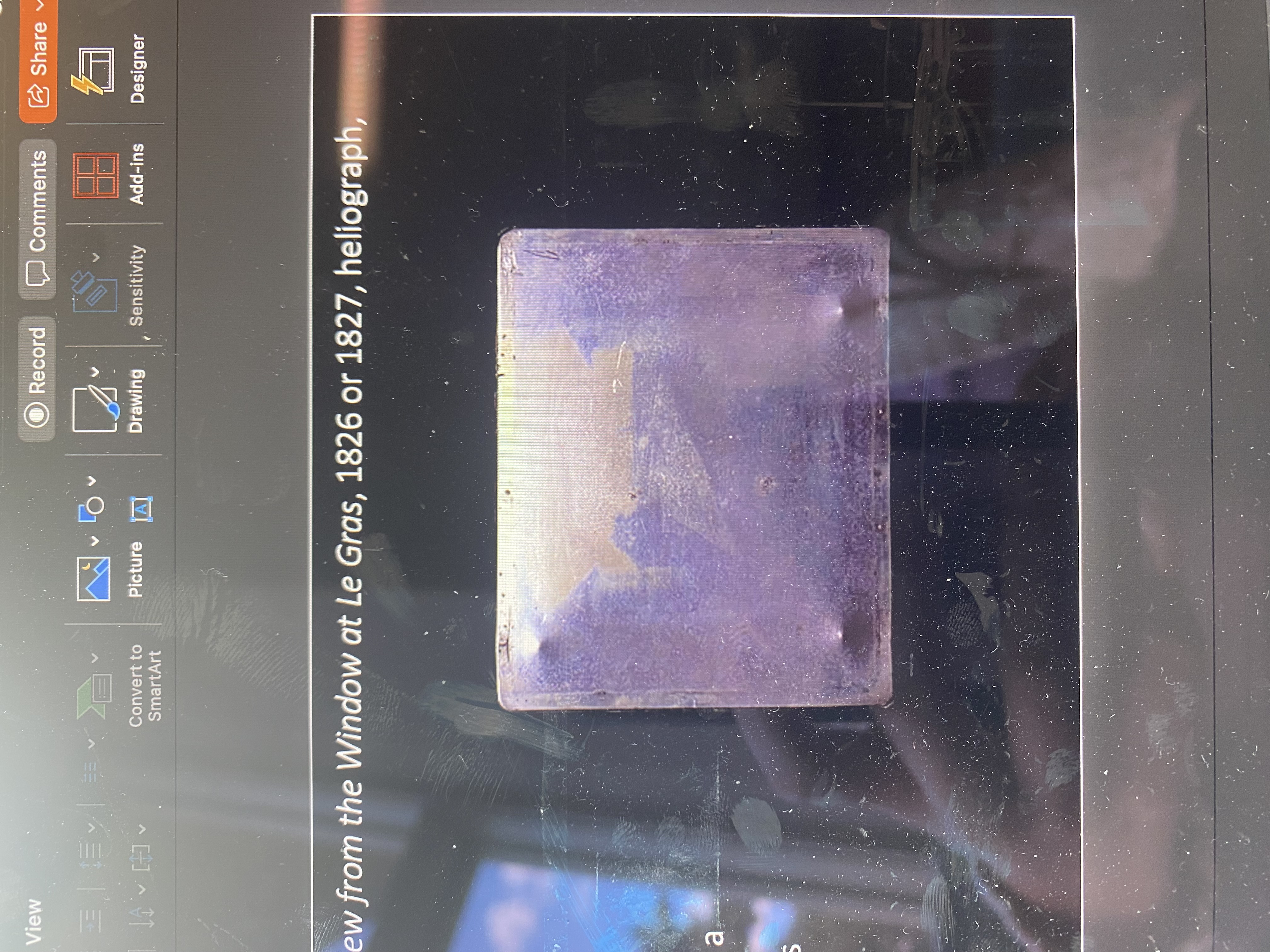
Joseph Nicéphore Niépce, View from the Window at Le Gras, 1826 or 1827, heliograph, 16x20 cm
First photograph every made, phtotgraph of a roof, grain cylo, camera was set up in upstairs window. Niepce had a lot of money, had the recources to fix an image, people had been able to temporarity fix an image, only one of them, direct positive, coated woth chemicals placed in camera placed outside – exposure time took 8 hrs, treated with more chemicals and let it dry, heliograph (helio – sun),
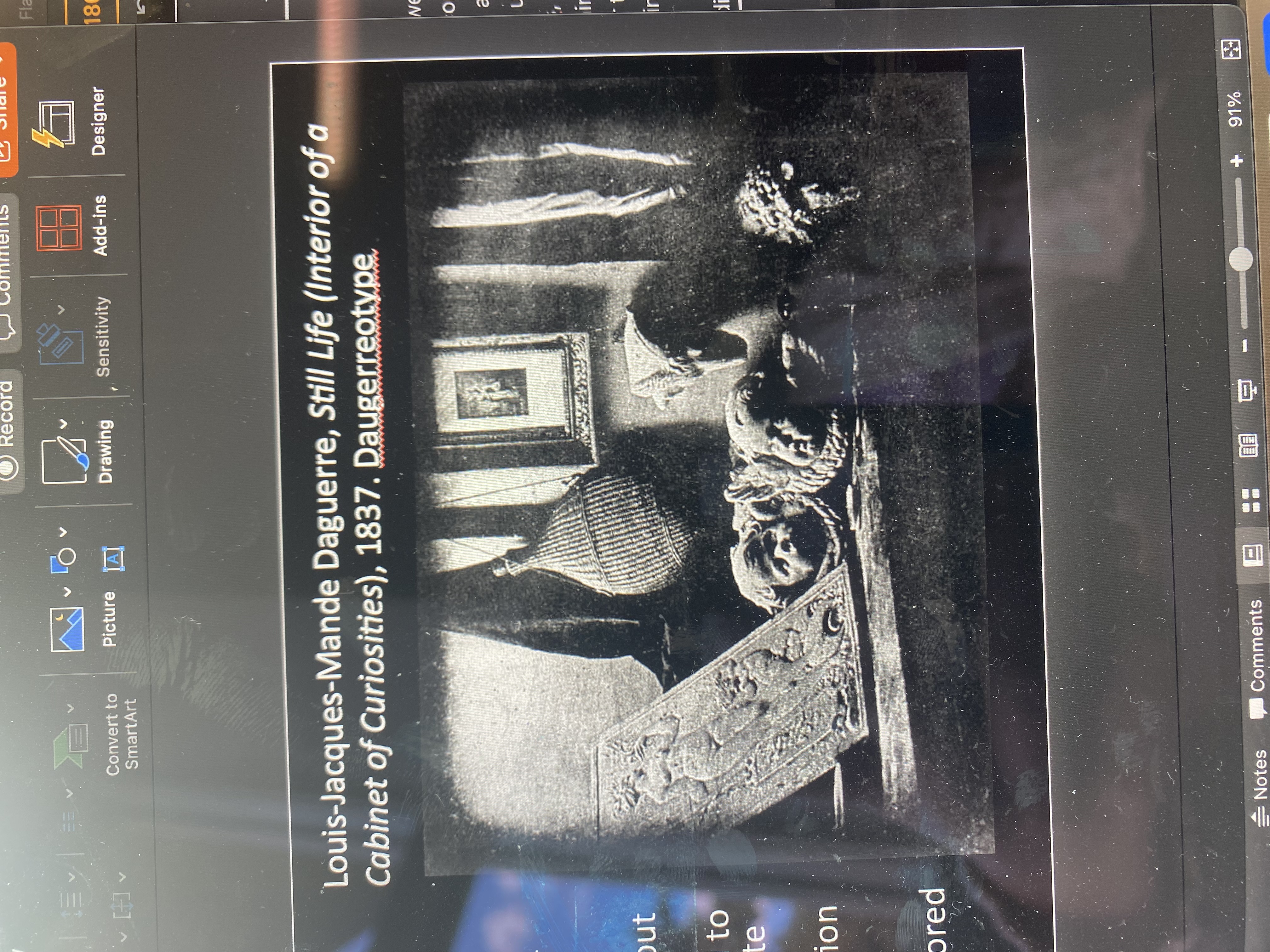
Louis-Jacques-Mande Daguerre, Still Life (Interior of a Cabinet of Curiosities), 1837. Daugerreotype
Daguerre was trying to make a photograph, Niepce wouldn’t tell society how he made photographs, Niepce and dagueereworked together, niepce dies, dagueere made a dagueereotype – copper plate, placed in camera, hand color had to store under glass to keep it visible,
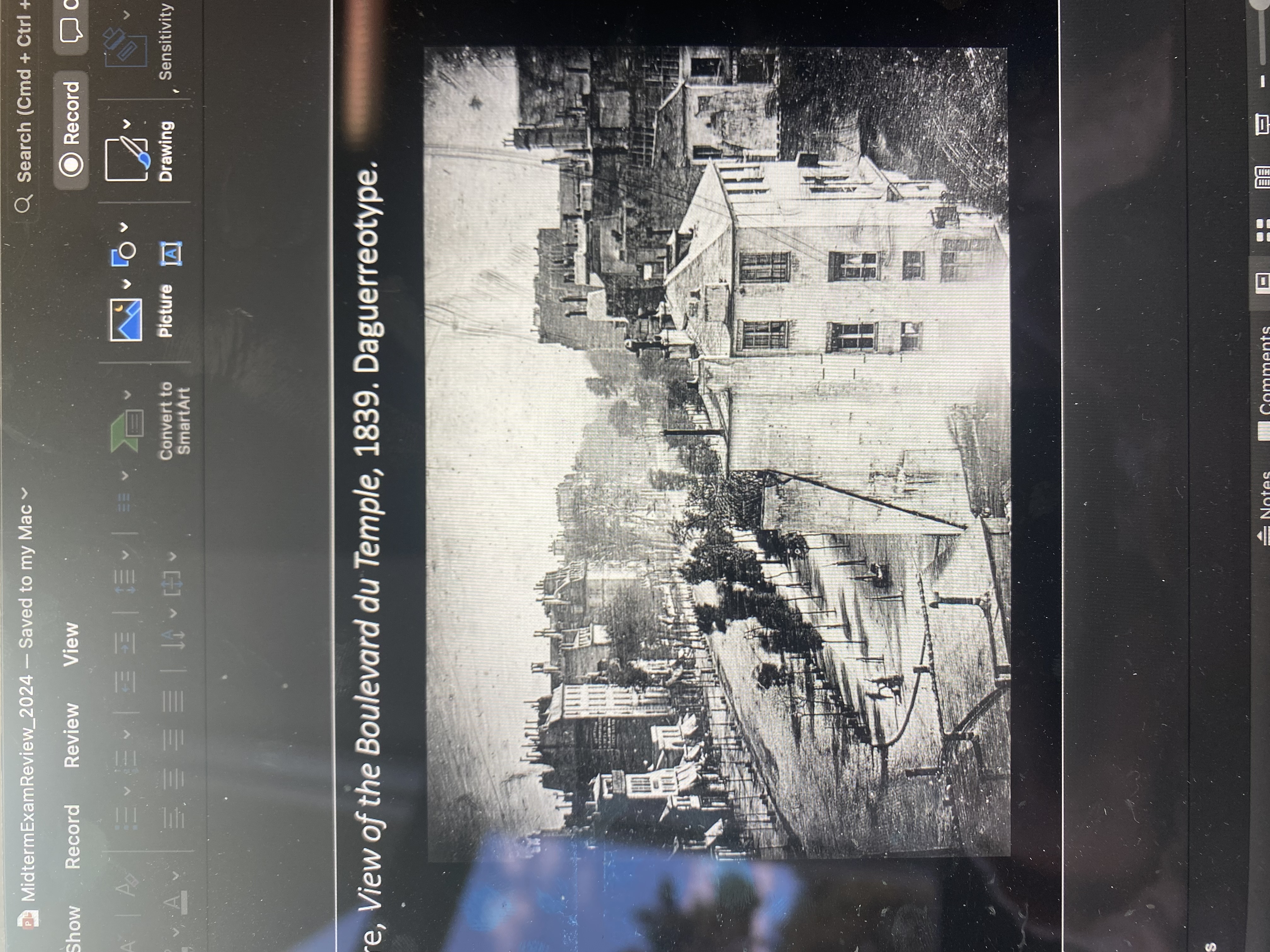
Daguerre, View of the Boulevard du Temple, 1839. Daguerreotype
First photograph of a person in the world, guy was getting his shoe shinned and he was stationary long enough. There were other people there but they moved too much,
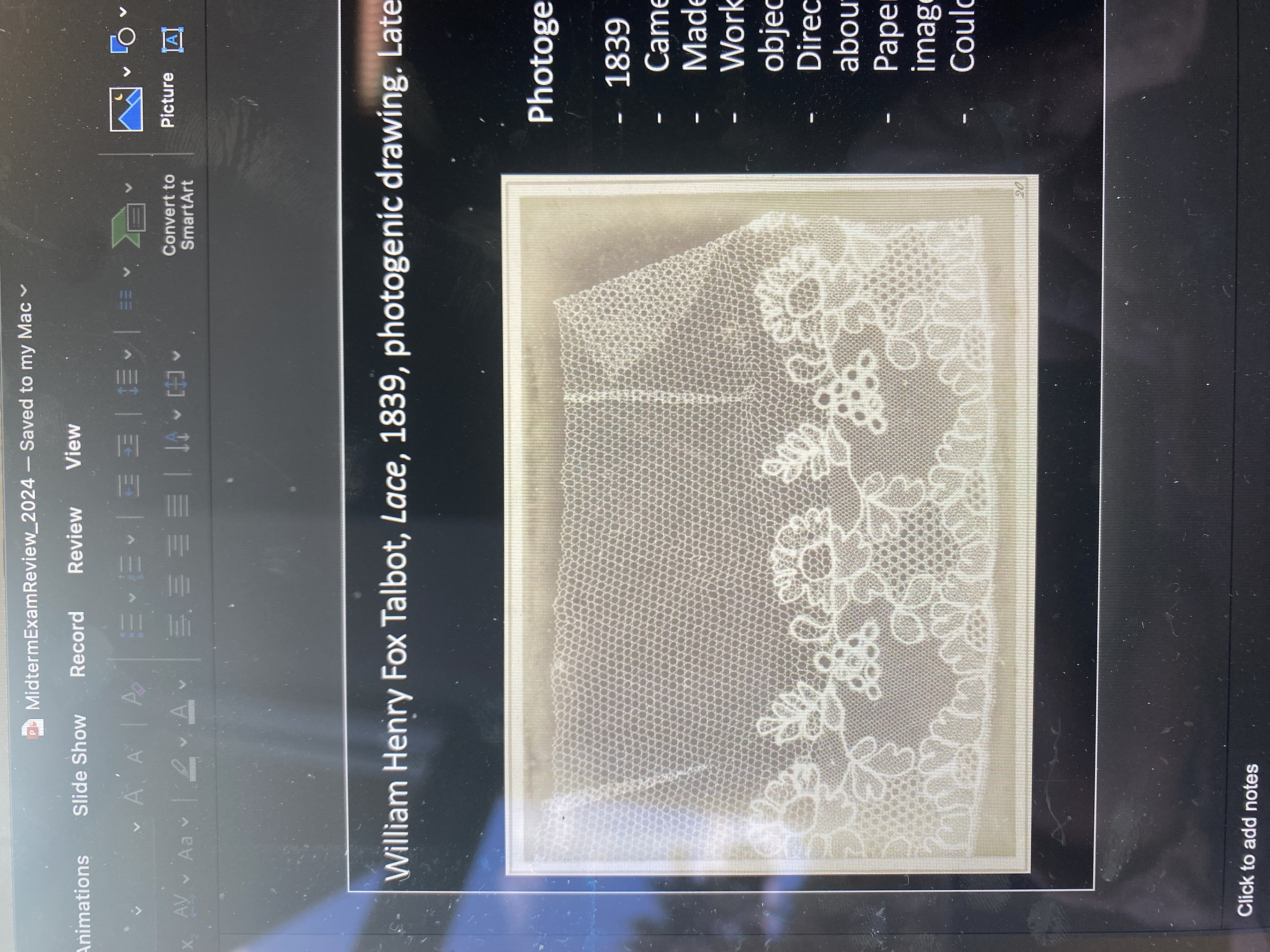
William Henry Fox Talbot, Lace, 1839, photogenic drawing. Latency
Photogentic drawing – talbot types, chemically treated paper, leave or lace that is transparaent, expose opbject to light passing thru on chemically treated paper, first negative made of on object, could be copied off of it, photography was not to be used as art, to be used for practical reasons
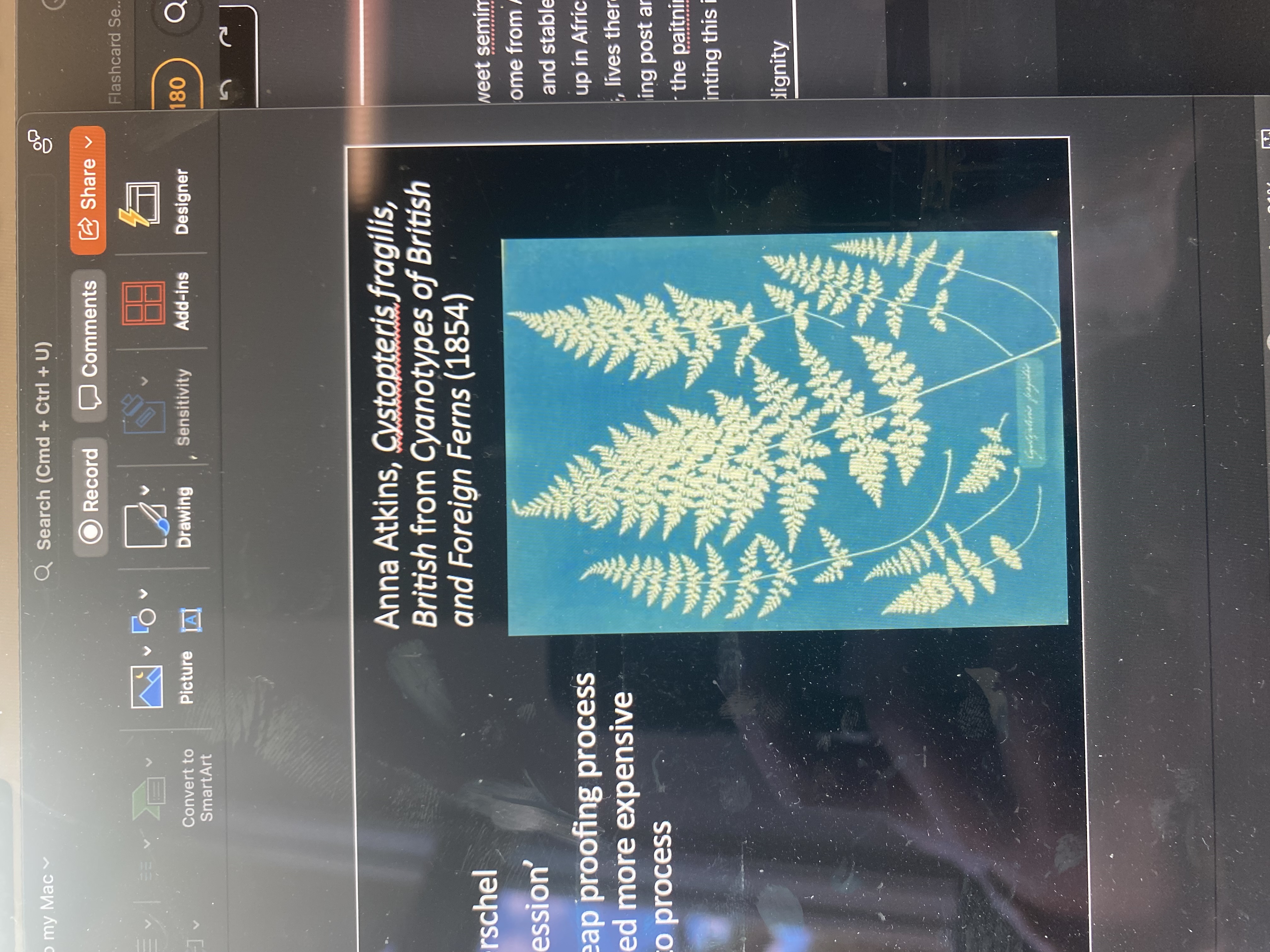
Anna Atkins, Cystopteris fragilis, British from Cyanotypes of British and Foreign Ferns (1854)
Ana Atkins was a botanist, she could take photo of plants instead of drawing, made first photographic book of ferns, photgraphy first only seem as a way to assist science
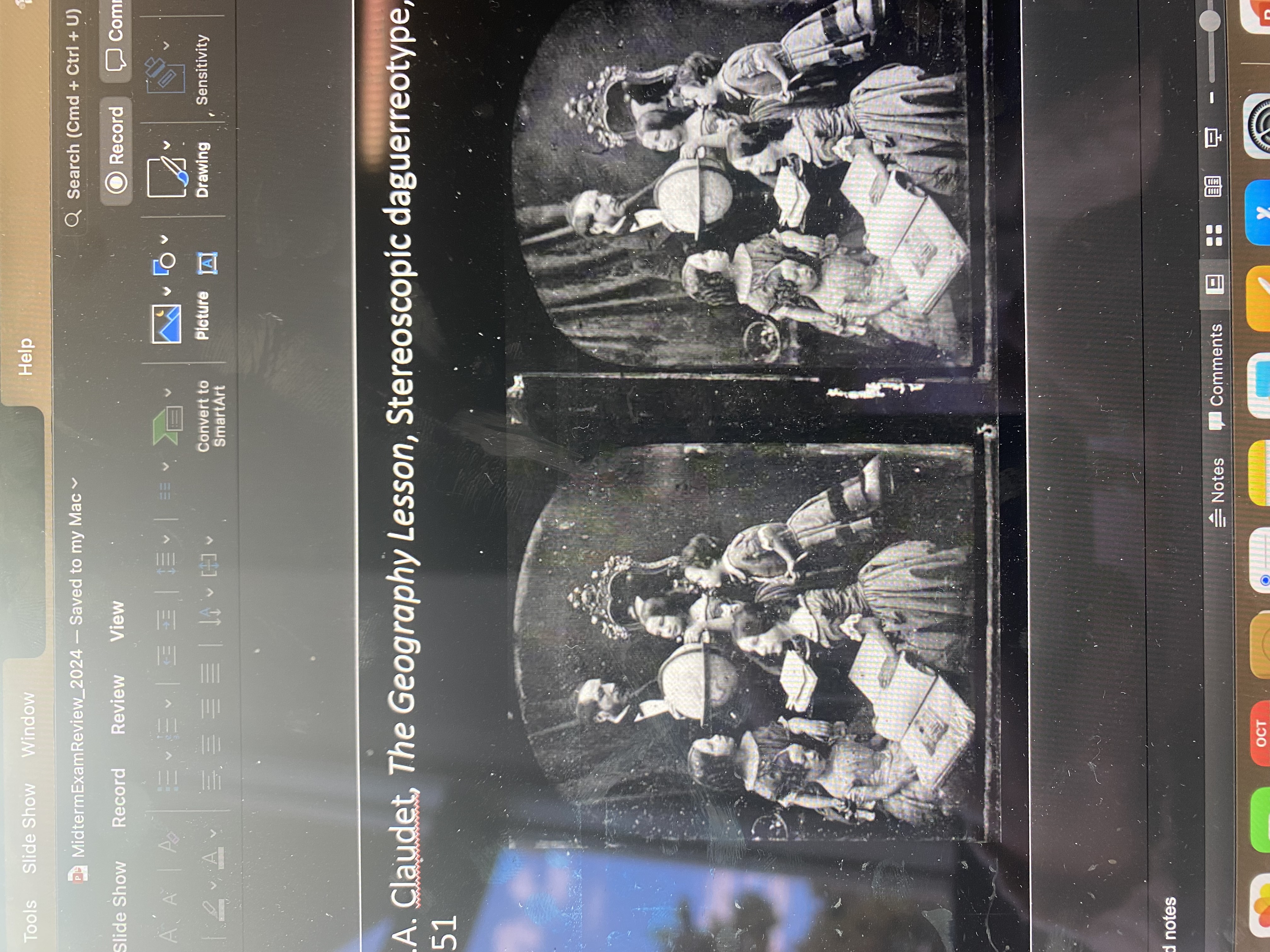
J.F.A. Claudet, The Geography Lesson, Stereoscopic daguerreotype, 1851
Stereoscope – have stereo viewer, put double image inside, looks 3D, left is off center, personal experience that you can make yourself, pornography made from this, no look at early forms of pornography
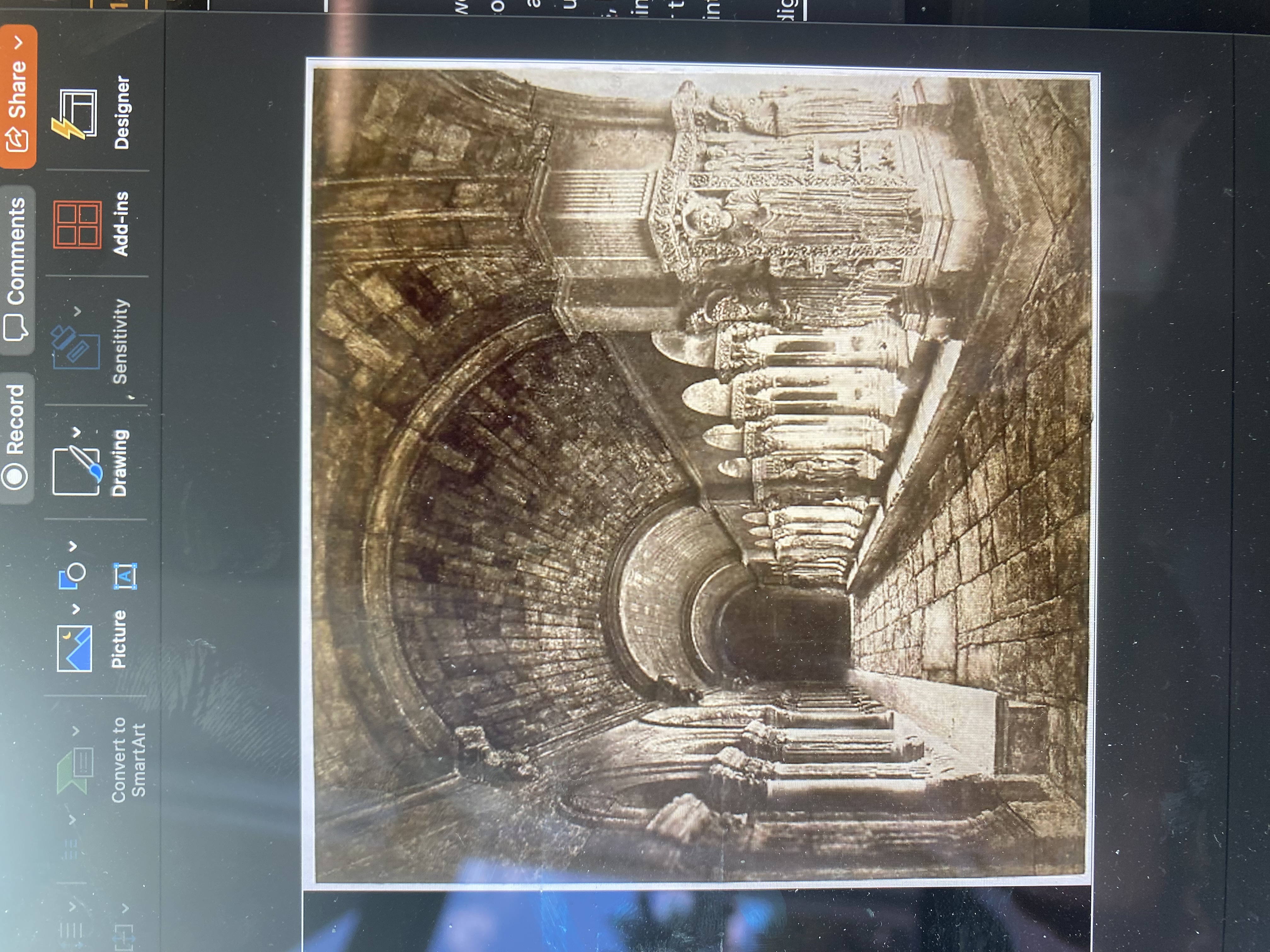
Edouard Baldus, Cloister of Saint-Trophîme, Arles, 1851, The Historic Monument Commission (Missions Heliographique) Combination Printing
Photographers in France sent out to churchs in disrepair, after French revolution – gov cannot help churches in any way, historic monument commission to take photos and they base what they need to fix on the photos taken, actually not real – constructed fake so it is more real, combination printing, took dozens of paintings together, view point is not possible for our eyes, makes it more ture than it actually is, photos of ceeling and hallway put together,
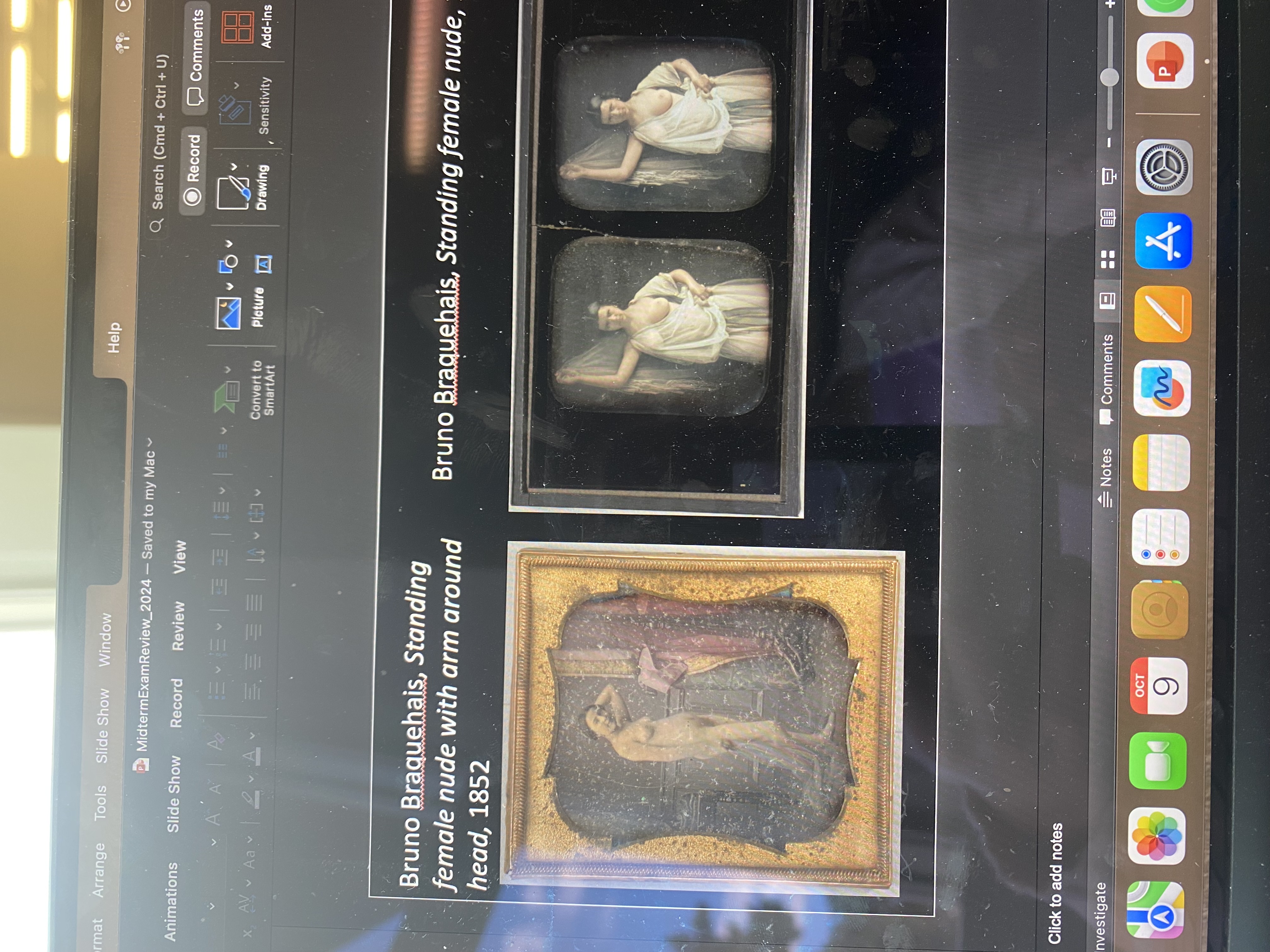
Bruno Braquehais, Standing female nude with arm around head, 1852, Bruno Braquehais, Standing female nude, 1854
looks 3D, first forms of pornography, could me make my yourself, more personal experience
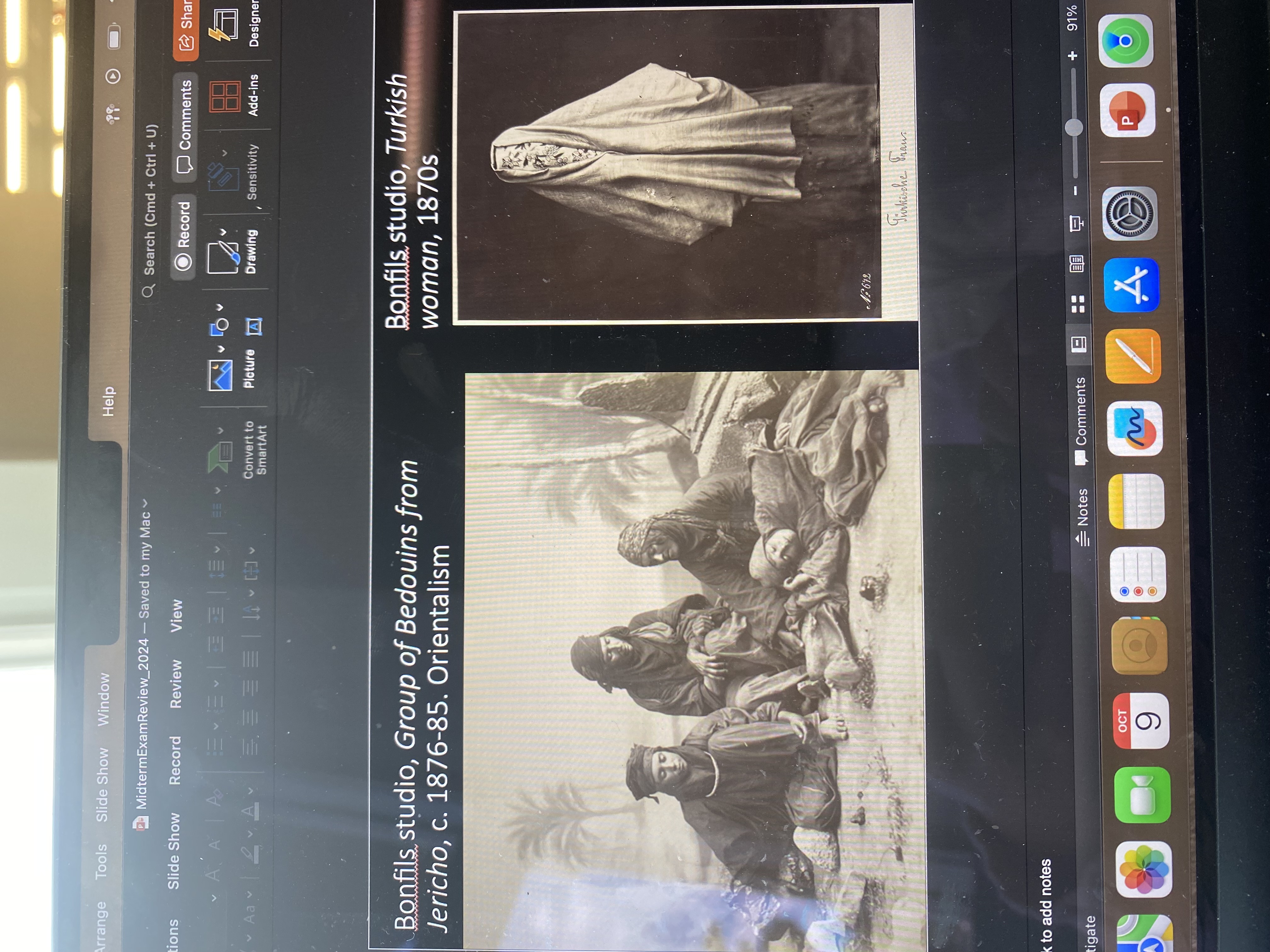
Bonfils studio, Group of Bedouins from Jericho, c. 1876-85. Bonfils studio, Turkish woman, 1870s
Run by husband and wife team, backdrop, props, same people hired to pose for multiple pictures and cultures
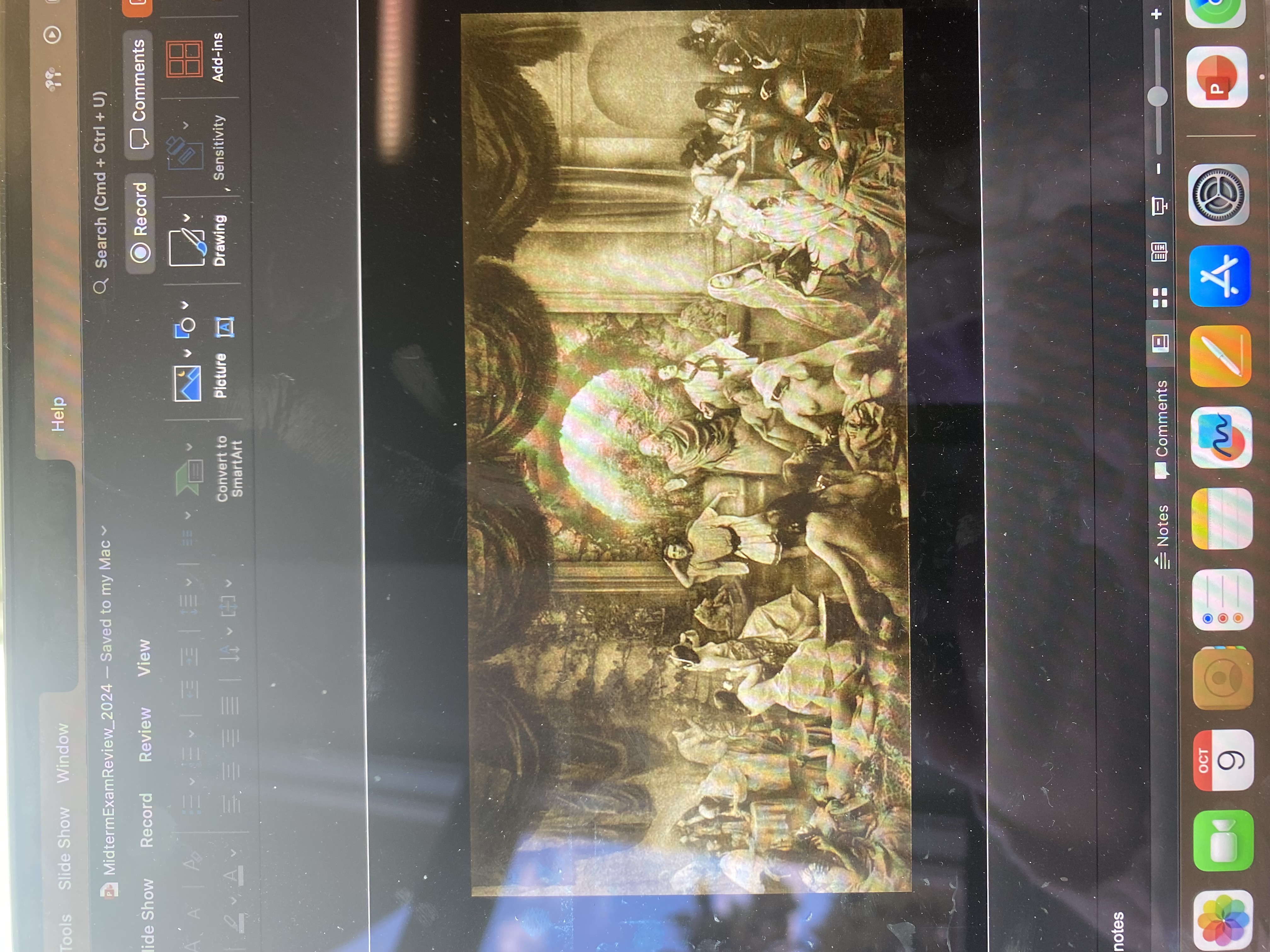
Rejlander, The Two Ways of Life, 1857
Combination printing, made to teach a moral, based on Raphael’s school of Athens, one side here is vice and virtue, nude women, gabling, virtue – studyining, women praying and reading, poorly received for the women in front for being naked, idea that she was infront of his to take photo seemed highly innaproprient, combination photographs
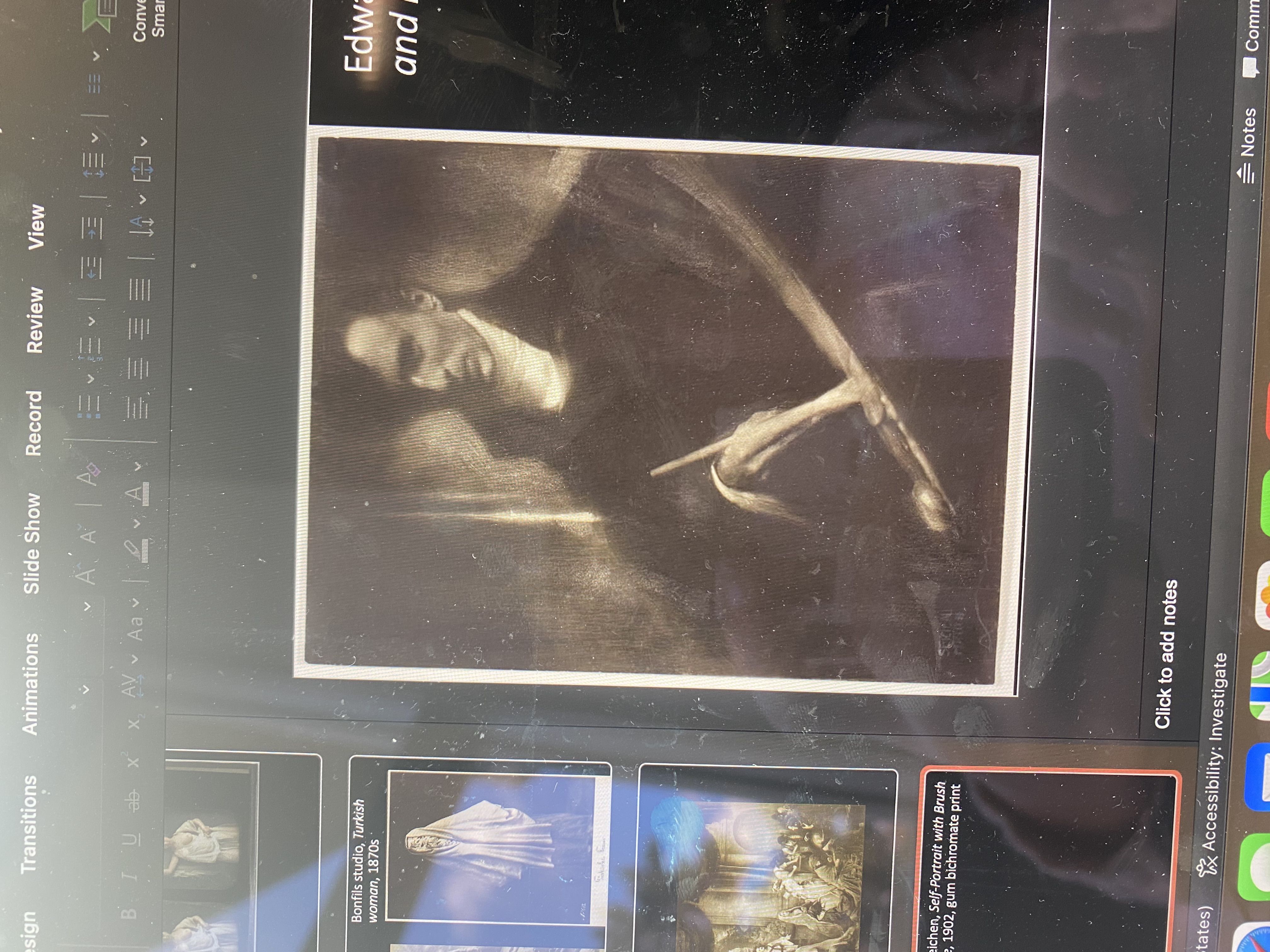
Edward Steichen, Self-Portrait with Brush and Palette, 1902, gum bichromate print
Photographer as artist, with brush and palate, makes it look fuzzy and atmospheric, dark room techniques to have artists have personal touches on it